Last updated on April 5, 2024
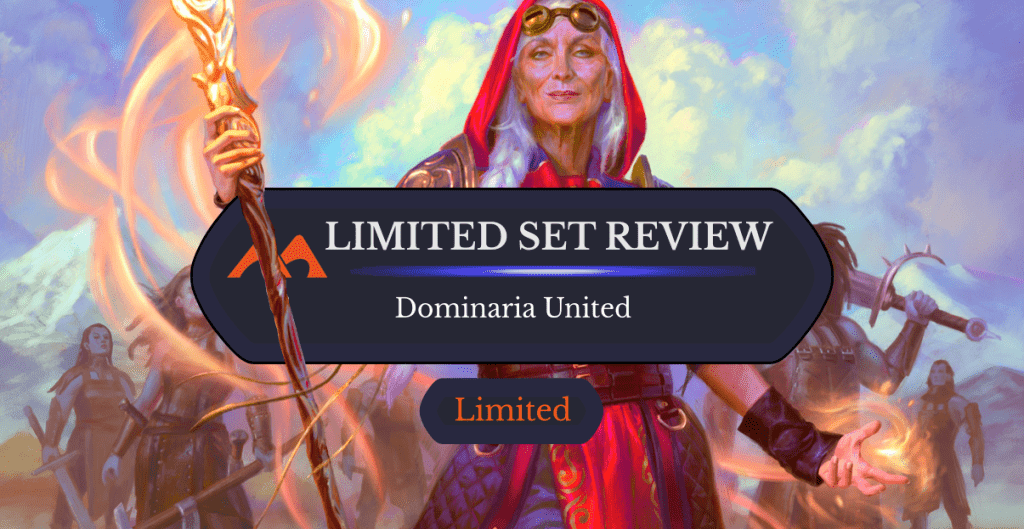
Jaya, Fiery Negotiator | Illustration by Marta Nael
Our full draft guide for Dominaria is now live! Check it out here.
The first set after Magic’s 30th anniversary starts the “Phyrexian Arc,” an epic story being told across the next year of Standard sets. Dominaria United has a lot of hype to live up to. Its predecessor, the 2018 Dominaria, was one of the greatest Limited formats of all time.
Let’s see if this new installment has any chance of living up to its namesake’s reputation!
Rating Breakdown

Karn, Living Legacy | Illustration by Chris Rahn
These reviews are based on my initial impressions of the set. There’s no way of telling how fast or slow the format is without playing the set, even if a 3-color set is highly likely to be slower than the average set, or how good each of the draftable decks is going to be.
I’m reviewing each card assuming the archetype it’s designed for is actually playable. My hope is that these insights will go some way to help inform your decisions in your first attempts at playing the format.
Here’s what each of my ratings means:
- 10: The absolute best of the best. 10s make a meaningful impact on any game regardless of when you play them and are extremely tough to beat. These cards like Sanctum Warden or Brokers Ascendancy.
- 8-9: Extremely good cards, usually game-winning bombs or the most efficient removal spells that aren’t quite good enough to be a 10/10. Think cards like Inspiring Overseer or .
- 6-7: Important role-players. These are typically going to be the best uncommons that really drive you towards playing a particular color, like build-arounds and good removal. These are cards like Brokers Charm or Rigo, Streetwise Mentor.
- 3-5: The average Limited card. Most commons and uncommons end up in this range, and most of your Limited decks will be made up mostly of these. Think cards like Civil Servant or Spara's Adjudicators.
- 1-2: These cards are generally pretty bad and you don’t want to play any of them. They should be kept in the sideboard and might be useful in specific situations. These are cards like Evolving Door or Witness Protection.
- 0: Absolutely awful cards. Virtually unplayable in every scenario and you should never put these cards in your main deck. Think cards like Cement Shoes or Meeting of the Five.
Set Mechanics
Domain

Making a return from the Invasion and Shards of Alara blocks, domain abilities give you a bonus based on how many basic land types you control. Since most Draft decks start as two colors, that’s the baseline for deciding if these abilities are good enough. A lot will be very serviceable with two land types, but then I expect there to be a sweet 4- or 5-color deck that can make extra use of these effects.
Domain plays out well in Limited, but a lot of cards with the mechanic tend to be bad and unplayable if you don’t have three or more land types around. This makes them difficult to play in most decks and is something you absolutely should bear in mind when building your decks.
Enlist

Enlist is an interesting new combat mechanic that’s somewhat reminiscent of banding. If a creature with enlist attacks you can tap another creature you control without summoning sickness to add its power to the enlist creature’s. There are some very clear advantages to this, like allowing a 2/2 with enlist to attack into bigger creatures.
But a big disadvantage is that the attacking creature doesn’t gain any toughness. This means that your 2/2 with enlist can still be traded off with an opposing 2/2 creature. You just have to know when to use the ability and when it’s a waste.
Attacking into bigger threats is a great ability for aggro decks, so I can see this playing out really well for those decks.
Kicker
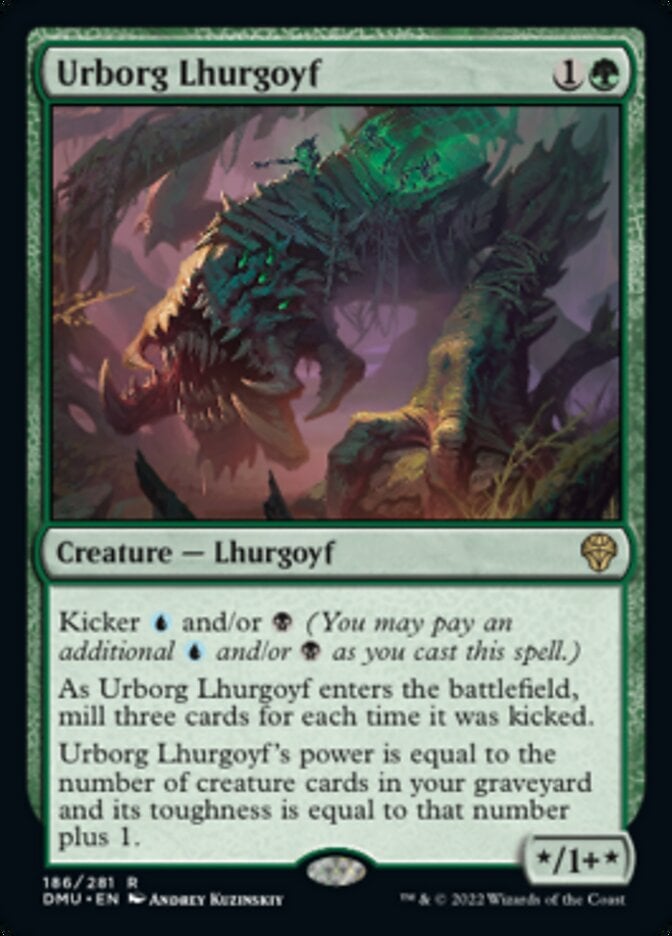
Every mechanic is basically kicker. I’m sure many of you are familiar with this sentiment by now.
Every time we see kicker, it’s amazing. It’s one of the simplest mechanics that WotC has in their arsenal, and I expect them to keep using it over and over again. We last saw it in Zendikar Rising and in 2018’s Dominaria. Both times it was phenomenal and led to some great gameplay.
This time around the gimmick is that the kicker costs are a different color from the main spell and some spells have multiple kicker costs, allowing you to get multiple bonuses. While this does effectively make most of these spells multicolored, finding a way of splashing the kicker costs gives you a little extra buff whenever you see it if you’re happy enough with the base spell, and you’re not unhappy if you don’t find the splash color.
This mechanic is great and I expect it to do great things. Given that you’re not guaranteed to have access to these off-color kickers I’ll give a rating for these cards both with and without the kicker cost.
Read Ahead and Sagas
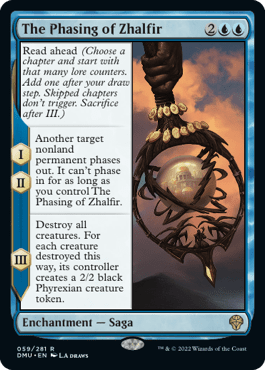
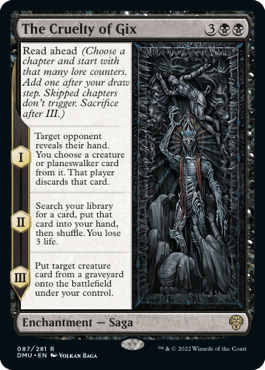
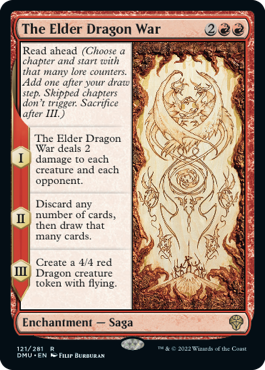
Sagas are back since they made their debut in Dominaria, and their inclusion here seems very fitting. This time we have another evolution with the new ”read ahead” mechanic.
By now you’re probably all familiar with sagas. They’re enchantments with a number of chapters on them. Read ahead lets you start the saga on whichever chapter you choose. This is a pure upside and gives a lot of flexibility to the cards.
Sagas have been great in every set they’re in, and I expect them to be a slam dunk here too.
Stun Counters

Stun counters are a new evergreen mechanic, meaning you’ll see them in most sets from now on, not just here. They’re a new way of phrasing effects that say, “that permanent remains tapped during its controller’s next untap step.”
If a permanent has a stun counter on it, then you remove that counter if it tries to untap for any reason. Sometimes when using cards like Frost Breath, it perfectly counters your spell if your opponent has a spell that untapped their creature. Stun counters fix that issue since an untap spell just removes a stun counter and the permanent remains tapped.
This also lets WotC design cards with more options, because a greater number of stun counters can keep a creature locked down for longer while that was virtually impossible to do without this design. These kinds of effects have always been fine, but I expect stun counters will play out a lot more smoothly than their previous clunky iteration.
Draft Archetypes
Most modern Limited sets focus on 10 basic Draft archetypes with ten 2-color combinations. This set works a little bit differently.
With domain and a lot of multicolored legendaries and kicker spells, the set instead has five heavy mono-color focuses so that the colors essentially blend together and your Draft archetype is flexible depending on which parts of those colors you draft. Each color combination has a pair of uncommon gold legends, sometimes with very different focuses on them, so Draft decks in this set will probably be less synergy-based than other sets and more about drafting good cards that don’t conflict with each other.
The mono-color themes are very classic and are as follows:
- White: Going wide using lots of small creatures and tokens.
- Blue: Heavy focus on instants and sorceries.
- Black: Creature removal, sacrificing creatures and manipulating the graveyard.
- Red: Fast and aggressive using creatures and burn spells.
- Green: Ramp and domain.
White
Anointed Peacekeeper

Rating: 6/10
Cards like Anointed Peacekeeper that restrict your opponent’s plays tend to play out better in Constructed than in Limited, but being able to see their hand and pick whatever you want to restrict can add up to a really nice combo. There’s a good chance you can stop your opponent from even being able to make a play on the next turn if you land this on turn three.
A 3-mana 3/3 with vigilance is already excellent at the end of the day, so having the potential to really screw up your opponent’s plays makes this a really nice card.
Archangel of Wrath
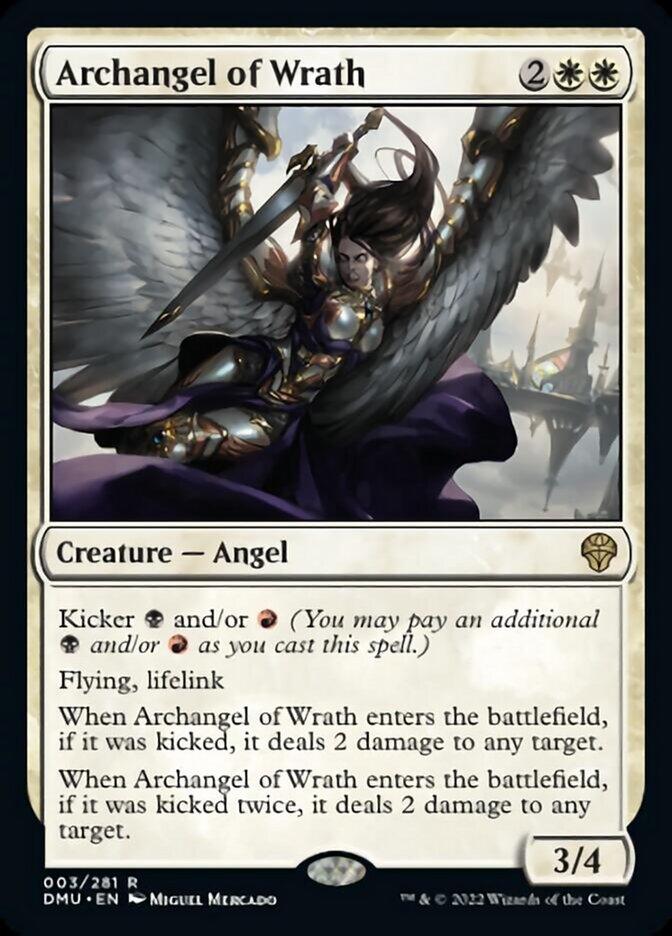
Rating: 7/10 without kicker, 10/10 with kicker
What. A. Card.
Archangel of Wrath is the stuff that 10 out of 10s are made of. I’m going to assume that it’s relatively easy to splash both kickers, but even if you can only cast it as a 3/4 flier with lifelink that’s still a great deal.
If you get to cast it with both kickers, this is one of the most powerful effects you can get. Two Shocks lets you kill two small creatures, one medium-sized creature, or just hit your opponent for four damage. Since the creature has lifelink, you also gain life from these hits, which is huge. And if you have access to these kickers then you have one of the most powerful effects that you can get in Limited.
The card is great when you’re ahead since it provides a huge flying body that wins you races, and it’s great at breaking parity by killing creatures and giving you a flying threat. It’s also great when you’re behind because the life gain helps to keep you alive while killing relevant attackers and giving you a very strong blocker.
This is just everything I want a Limited card to be, and I can’t wait to try it out for myself.
Argivian Cavalier
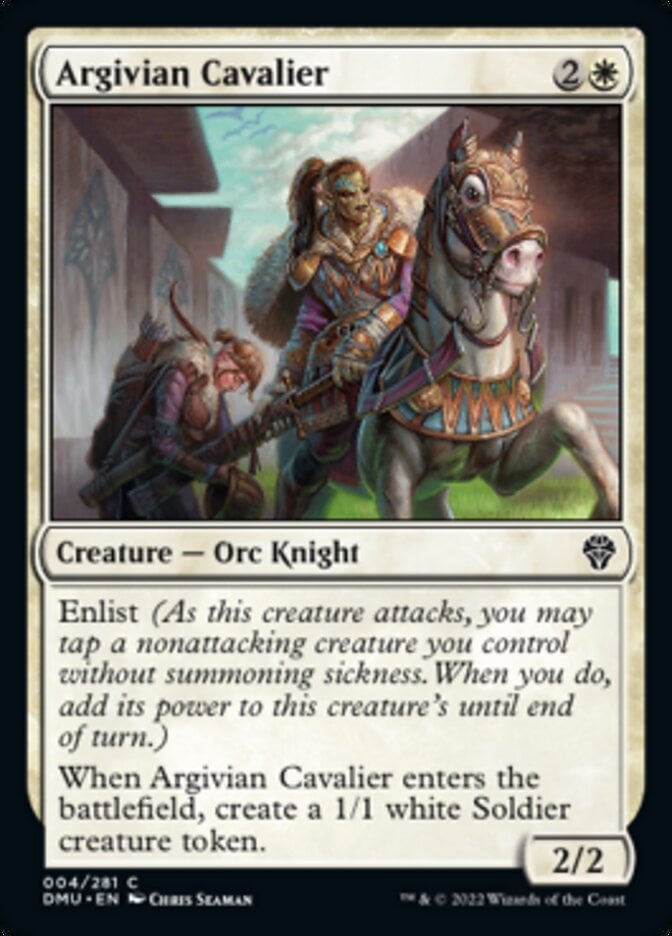
Rating: 5/10
Three mana for a 2/2 and a 1/1 has always been a great deal, especially on a common. Enlist on the 2/2 is just a nice cherry on top to help Argivian Cavalier become what’s likely to be one of the better white commons in the set.
Argivian Phalanx
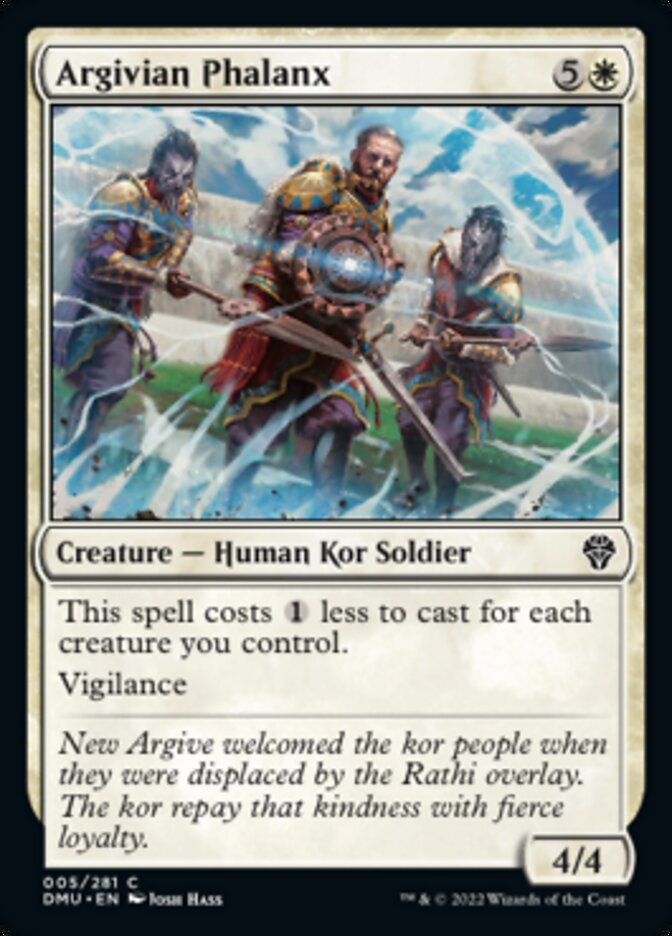
Rating: 4/10
Argivian Phalanx is the first of a cycle of overcosted creatures in each color that become cheaper based on a particular number. This one seems fine, but not as exciting as some of the others in the cycle. It’s fairly easy to enable at six mana.
For example, this could be your 4-drop and you’d be pretty happy with that if you cast creatures on turns 2 and 3. White has access to quite a lot of token generators so you may have ways to build it up quickly to enable this even if your board is empty.
All in all, this looks like a solid payoff for your go-wide strategies.
Artillery Blast
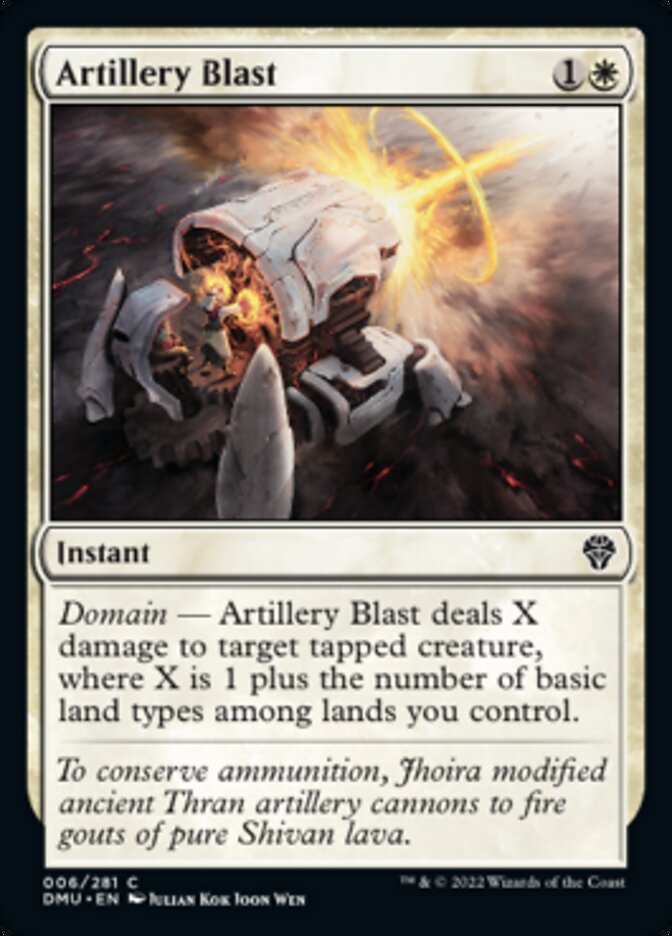
Rating: 3/10
The use case for Artillery Blast is the ability to deal three damage, but only to tapped creatures. The creature has to be something that’s attacked you in theory, which is often going to be a little restrictive.
White is very aggressive in this set, meaning that you ideally want your removal to kill potential blockers, which this is very bad at doing. It might be a different story if it outright killed any creature. But as it stands this will probably be very mediocre outside of a slower and more controlling white deck.
Benalish Faithbonder
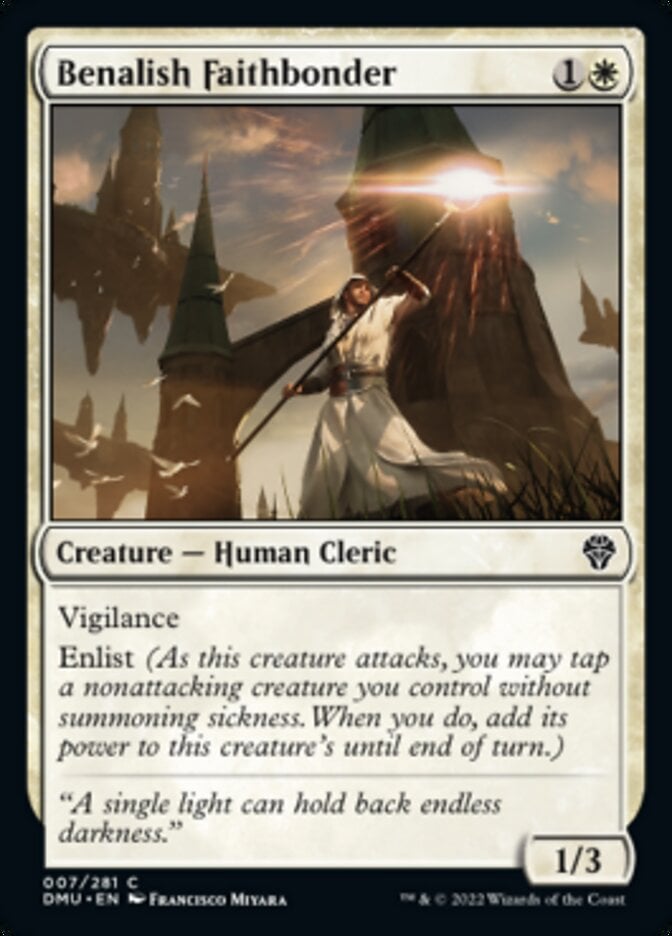
Rating: 4/10
You can’t go too wrong with Benalish Faithbonder as your 2-drop. It may not hit very hard, but enlist helps rectify that in later turns. Just solid all around, no complaints.
Benalish Sleeper

Rating: 3/10 without kicker, 5/10 with kicker
Fleshbag Marauder is always a fine card, and having the option to cast it as 2-mana 3/1 is a nice upside. I don’t tend to want these vanilla creatures in my white aggro decks, but enlist might make Benalish Sleeper more attractive than it normally would be.
And this becomes a very desirable card if I can use the kicker.
Captain’s Call
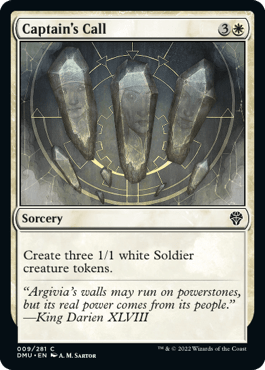
Rating: 4/10
Four mana for a trio of 1/1 soldiers from Captain's Call is a decent rate. A Hill Giant wouldn’t be welcome in your deck, but when you split that across three bodies in a set that has a lot of payoffs for going wide, then I’m in.
Charismatic Vanguard
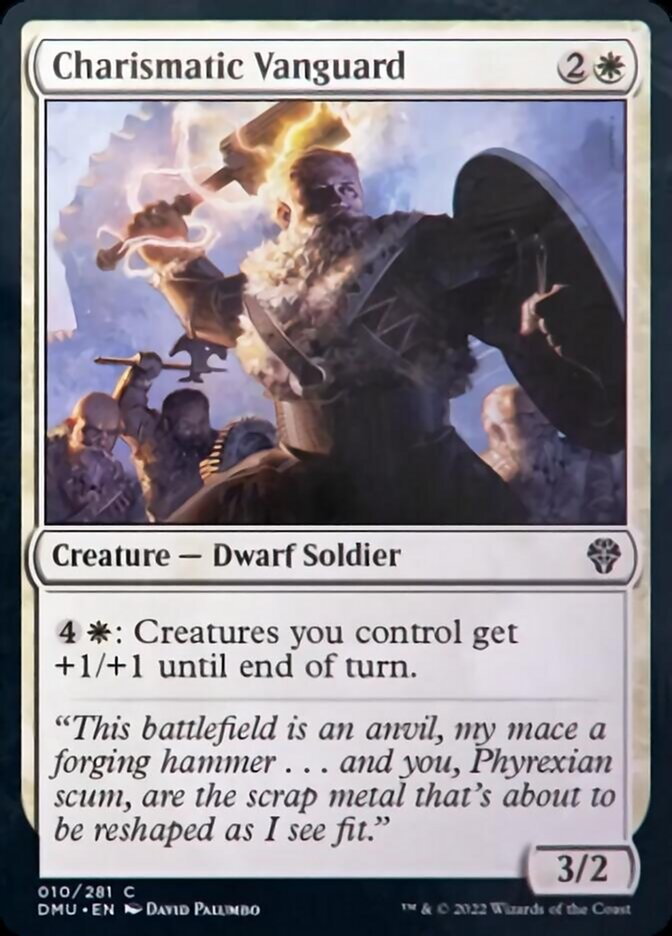
Rating: 4/10
3-mana 3/2s aren’t all that bad, so all you want to make them playable is a little upside. Being able to give +1/+1 to your team is a decent bonus. Charismatic Vanguard looks like a nice solid common.
Citizen’s Arrest

Rating: 6/10
The Pacifism effect for the set isn’t messing around at all. An enchantment that exiles a creature indefinitely is a lot better than an aura that keeps it locked down.
Aura variants can usually be removed by flickering or bouncing your creature, and the creature is still in play to get sacrificed too. But this variant of Journey to Nowhere is only vulnerable to enchantment removal, which isn’t exactly common in most main decks.
Citizen's Arrest should be a very solid common removal for white, and something I’d want to pick up early.
Cleaving Skyrider
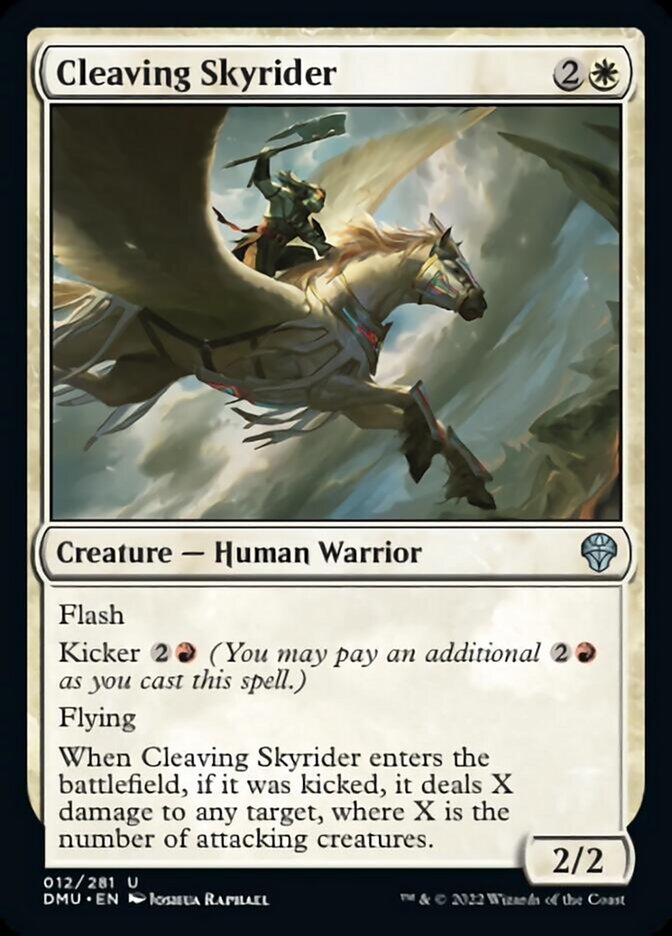
Rating: 4/10 without kicker, 7/10 with kicker
First of all, a 2/2 flash flier for three is really decent, so I’d be happy with Cleaving Skyrider in any deck. But the kicker cost is insane.
Needing there to be attacking creatures is a pretty heavy restriction, but given that it can be any player’s attacking creatures means that this should usually be able to flash in and pick off something relevant. Any time you have the potential to kill a creature and have a relevant creature left behind, that card needs some attention. And you always have the option of just flashing it in early if you need to.
Clockwork Drawbridge
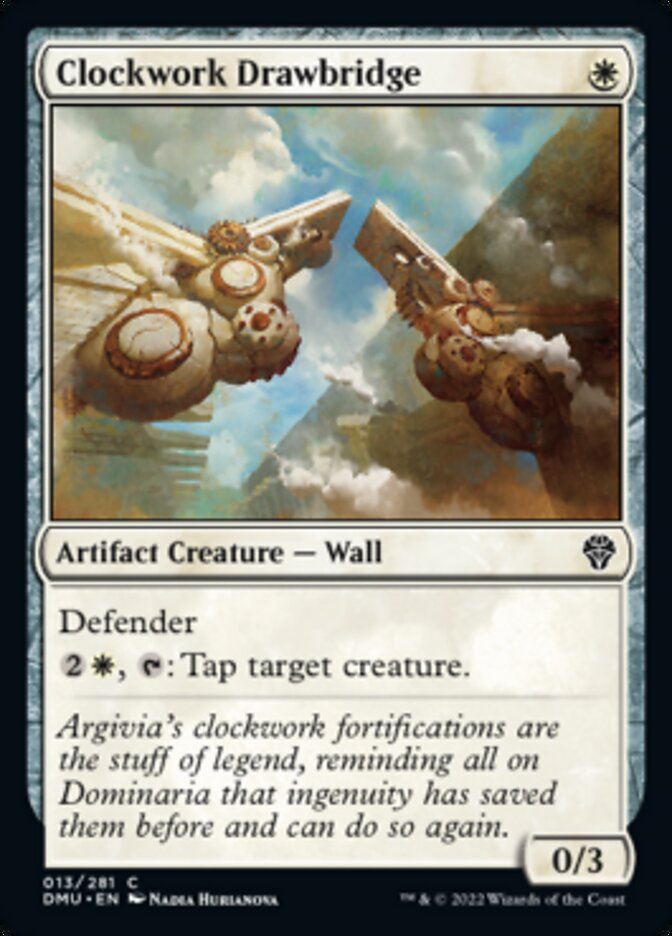
Rating: 3/10
Clockwork Drawbridge is an interesting card to evaluate. On one hand, paying three mana to tap a creature is a bit on the expensive side for the Benalish Trapper-style cards that we’ve seen before.
But on the other, being a 1-drop is nice, and being a wall is also quite relevant for some of the set’s synergies. This looks like a nice card in the right deck when you consider those, though not one that I’m likely to want in a really aggressive deck.
Coalition Skyknight

Rating: 4/10
My first thought when I read enlist was that this would be busted on a flying creature. It seems like WotC caught on to that too because four mana for a 2/2 flying creature is just bad.
Enlist makes a huge difference here since Coalition Skyknight will often be able to attack as a 4/2 or 5/2. This is the kind of card that you just can’t play in a lot of decks because it’s bad at doing everything other than attacking.
I think this has a home in the most aggressive decks, but outside of that, you can definitely do better.
Danitha, Benalia’s Hope
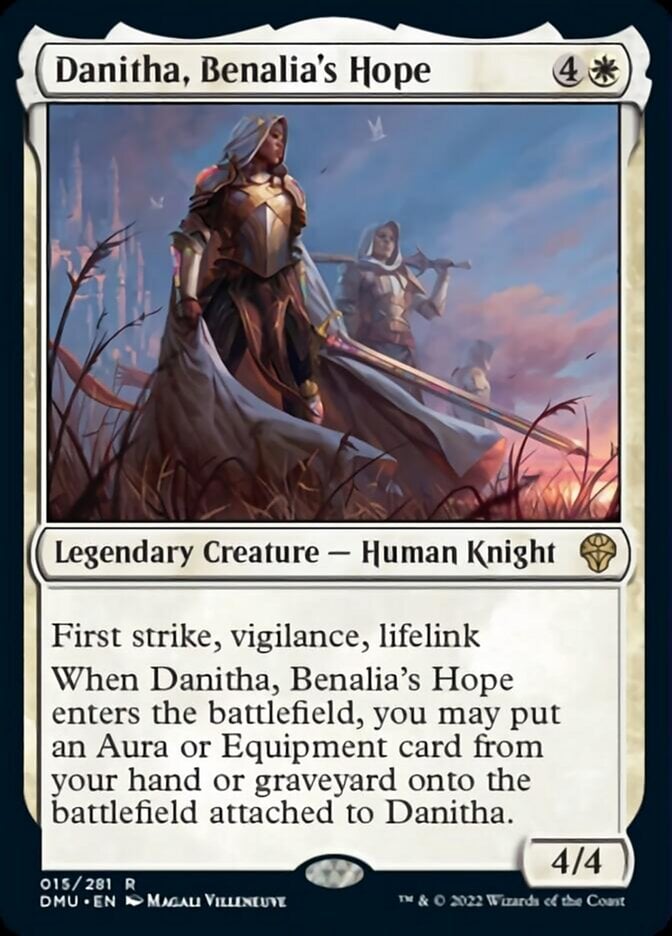
Rating: 8/10
This combination of abilities is and has proven to be, pretty broken. The original Danitha Capashen, Paragon had the same combination of abilities and it usually dominated a board, even on a simple Gray Ogre.
The new Danitha, Benalia's Hope should be just as dominant since you can’t get into combat with it, you can’t race it, and you don’t even get to attack past it thanks to vigilance. It’s just absurd. I haven’t even mentioned its triggered ability, which isn’t likely to happen all that often but will sometimes make it even more broken.
There’s an uncommon equipment in this set, Hero's Heirloom, that’s not only a good card but also gives Danitha two keywords it doesn’t already have, one of which is haste to let it smack really hard right away.
Danitha easily gets bumped up to a 9 or a 10 if you have a bunch of equipment available to you, so the potential on display here is really impressive. I think this card will end up being a great bomb rare to open.
Defiler of Faith

Rating: 7/10
Defiler of Faith is the first of a really cool cycle of rares that basically allow you to cast permanents of the same color with Phyrexian mana.
This white one is pretty decent. A 5/5 for five with vigilance doesn’t have to do much to be a very playable card, so giving you the Phyrexian mana boost and a free 1/1 every time you cast a white permanent are very nice abilities to make this something I’ll always be happy to have.
Destroy Evil

Rating: 4/10
We had almost this exact same card in Kamigawa in the form of Repel the Vile. While that card wasn’t very good, Destroy Evil costing half as much mana should be pretty solid.
The difference between two and four mana is huge and often means the difference between being able to cast an extra spell in the same turn and not. I imagine I’ll want the first copy of this but not the rest, but they make excellent sideboard cards nonetheless.
Griffin Protector
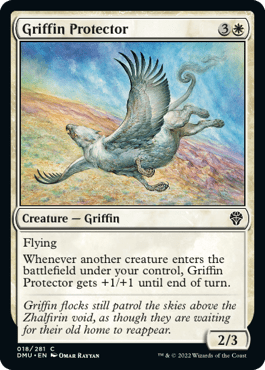
Rating: 4/10
2/3 fliers for four need a little bit of help these days since they’re a bit over costed for what you want. But Griffin Protector might get to attack as a 4/5 or a 5/6 with token generators lying around, which I’ll be pretty happy playing at the top of my curve.
Guardian of New Benalia

Rating: 8/10
After playing against cards like Adanto Vanguard and Seasoned Hallowblade, my first thought when reading Guardian of New Benalia is just, “thank god it’s rare!”
This attacks into basically any size creature thanks to enlist and is virtually impossible to get into combat with. Not only that, but every enlisted attack lets you scry into more threats, keeping your aggressive curve going into the late game. This is a powerhouse that’s just going to take over most boards it’s played onto.
Heroic Charge
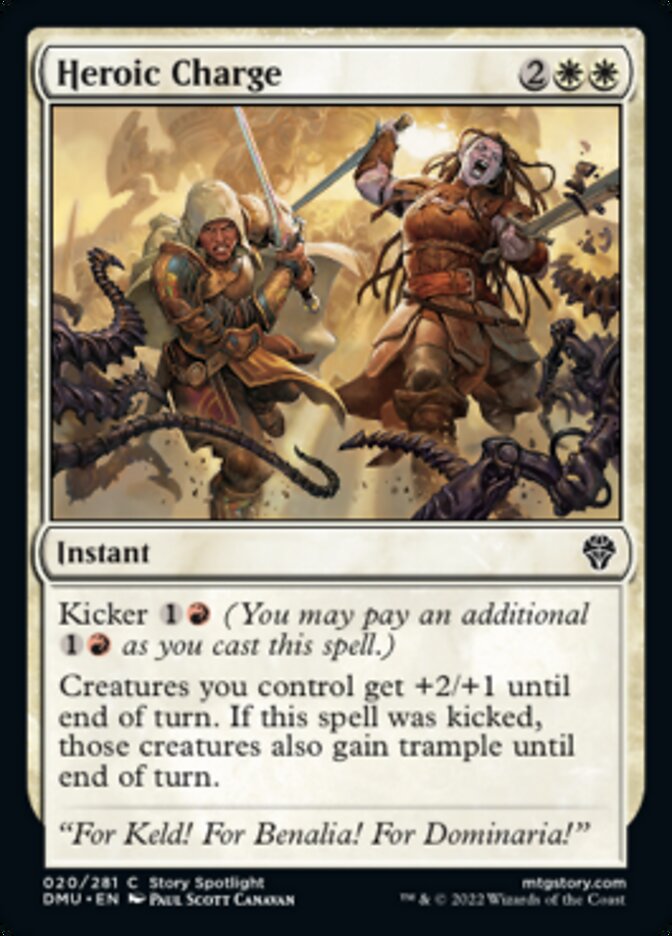
Rating: 4/10 without kicker, 4/10 with kicker
Inspired Charge is a card that works really well in any set where white is good at going wide with multiple creatures on the board, so it stands to reason that Heroic Charge is good here too. I don’t think the kicker cost is relevant or even worth it because you’ll often use this to push damage through with lots of small creatures which aren’t likely to get to trample in the first place.
I’m just happy with the 4-mana version, and I’ll likely ignore the red.
Join Forces
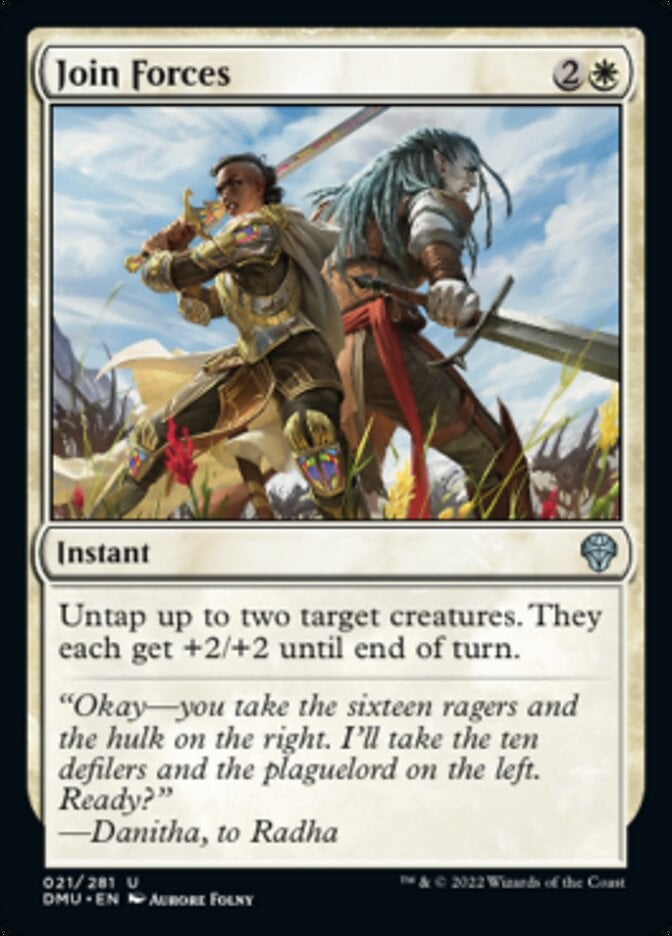
Rating: 3/10
While I like combat tricks when they give you opportunities for big two-for-one swing plays, Join Forces has historically been too difficult to set up to be consistent. Situations, where you have two tapped creatures that are big enough to ambush two attacking creatures, are a lot rarer than you might think. So are situations where you can buff two attacking creatures.
While not exactly unplayable, don’t pick this up expecting it to be as busted as it can be most of the time.
Juniper Order Rootweaver
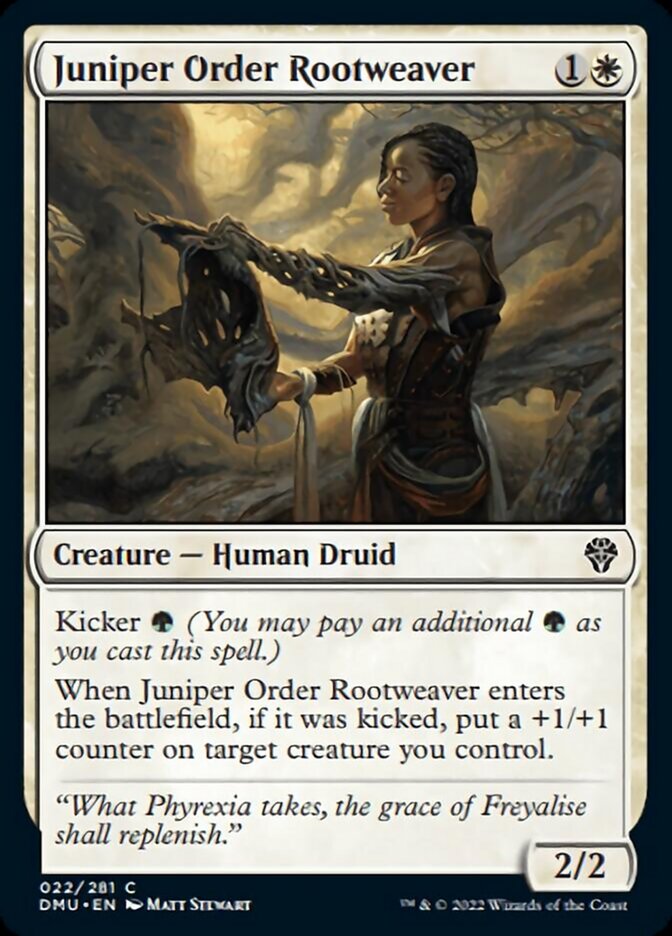
Rating: 3/10 without kicker, 4/10 with kicker
Vanilla 2/2s only need a little bonus to become sought after, and Juniper Order Rootweaver giving you a free +1/+1 counter for a single green mana is a bonus I’m very interested in. Your white decks typically need plenty of 2-drops anyway, and this is perfectly fine for that.
Knight of Dawn’s Light
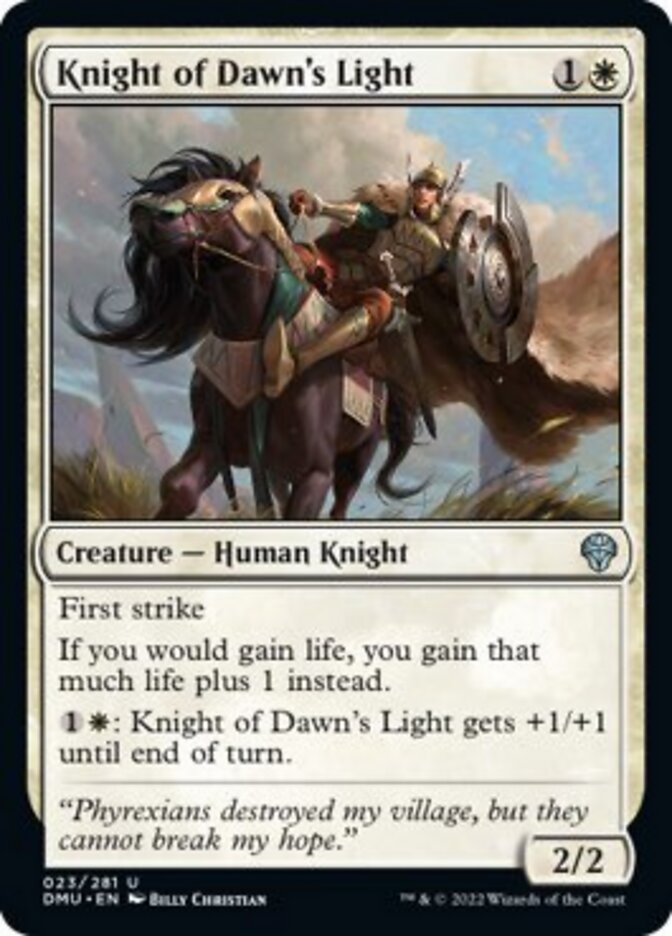
Rating: 7/10
As far as 2-drops go, one that threatens to grow bigger than the creatures it blocks is something that warrants a further look. The first strike is already good enough to make Knight of Dawn's Light a high priority.
Being able to grow itself means that you’re always threatening that ability and making it impossible for your opponent to block effectively. The extra life gain ability is largely irrelevant but certainly nice to have for some decks.
Leyline Binding
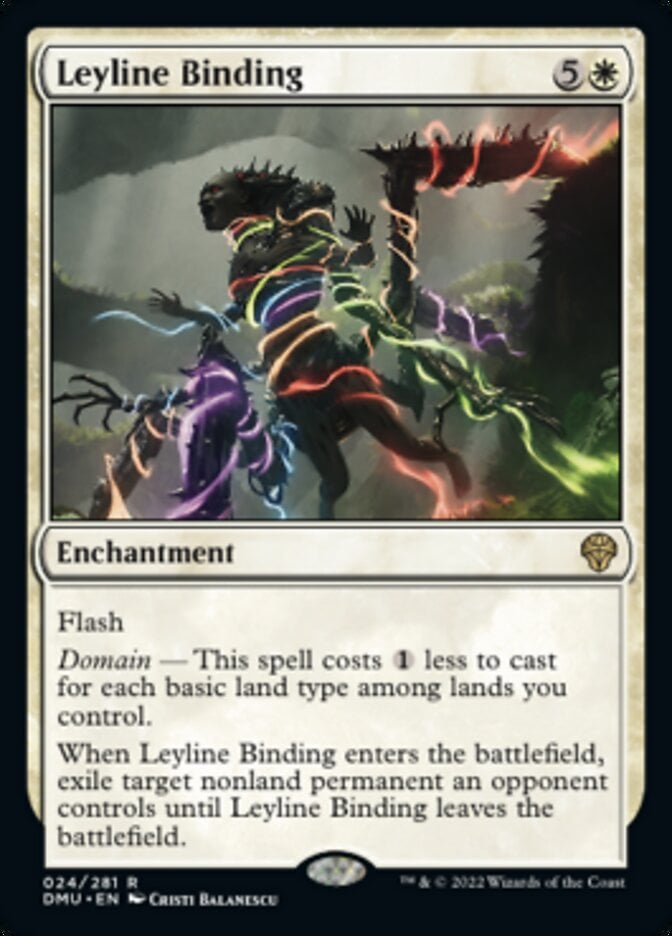
Rating: 7/10
You’re only going to be reducing Leyline Binding’s cost to four mana in most decks, but even then a 4-mana Banishing Light with flash is an excellent card. If you’re able to get the cost down any further then that’s also great, but ultimately this card is good no matter what deck it’s in.
Love Song of Night and Day
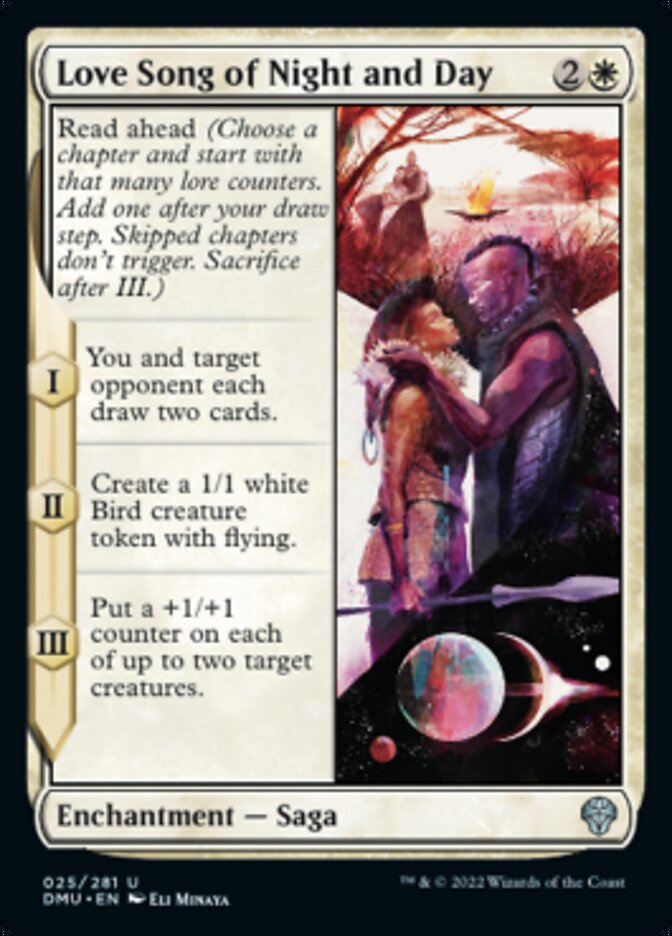
Rating: 4/10
I’m really not interested in the first chapter of this particular saga, but you can choose to skip it thanks to read ahead. You get a 1/1 flying creature if you do, plus a couple +1/+1 counters which is a nice deal for three mana.
Love Song of Night and Day is a little easier to disrupt, and you need creatures on the board for it to be effective. But the card can be quite powerful if you can meet those conditions regularly.
Mesa Cavalier
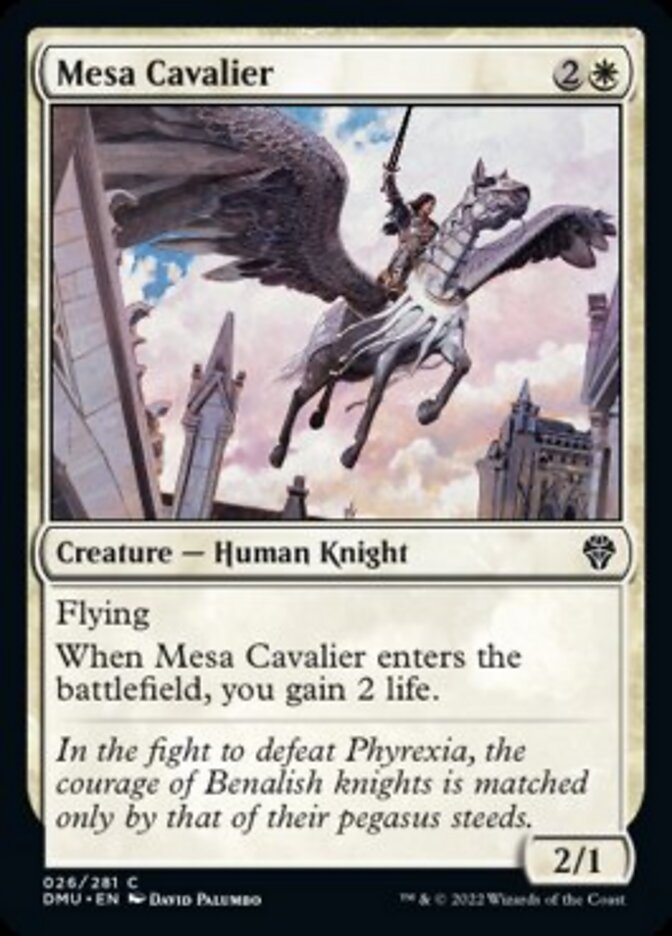
Rating: 4/10
Mesa Cavalier takes me back to the days of Scars of Mirrodin, the first time I ever learned how to play Limited, and was shocked to learn that something as innocuous as Kemba's Skyguard could be a great Draft card. Times have changed in the past 12 years, but even now this card looks really good to me, and every kind of white deck will be happy playing it.
Phyrexian Missionary
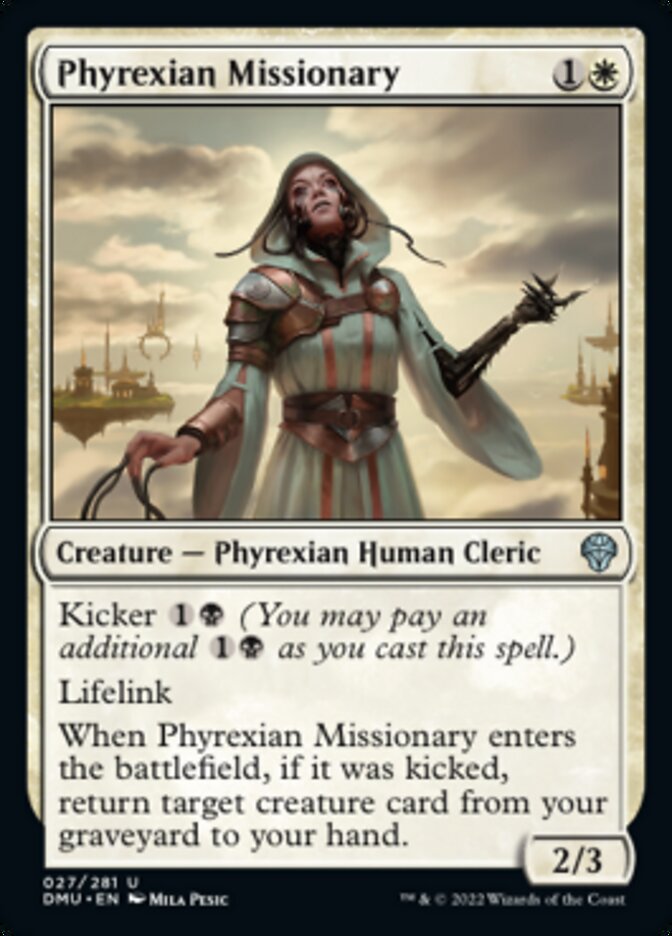
Rating: 5/10 without kicker, 7/10 with kicker
A 2/3 lifelinker for two mana is a great deal that belongs in any white deck. But the real potential is in becoming an Orzhov () Gravedigger. While Phyrexian Missionary can’t be flickered, the strength of being able to enter the battlefield and draw a real spell is an incredibly powerful effect in limited.
This ought to be a high pick regardless of what nonwhite colors you have access to.
Prayer of Binding
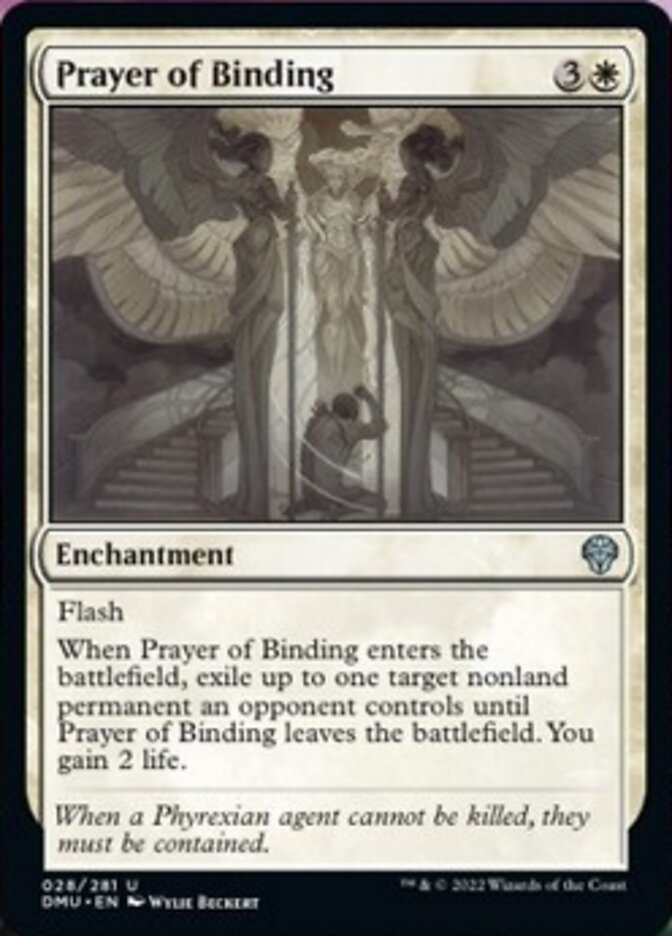
Rating: 7/10
Didn’t I just review this exact card a few minutes ago? And why is Prayer of Binding slightly better than its rare counterpart?
Okay, if you have a domain deck then Leyline Binding can cost less than this and be better, but a lot of the time they cost exactly the same and this one is slightly better. But they’re both still premium removal spells and I’ll be happy with whichever one I get.
Resolute Reinforcements
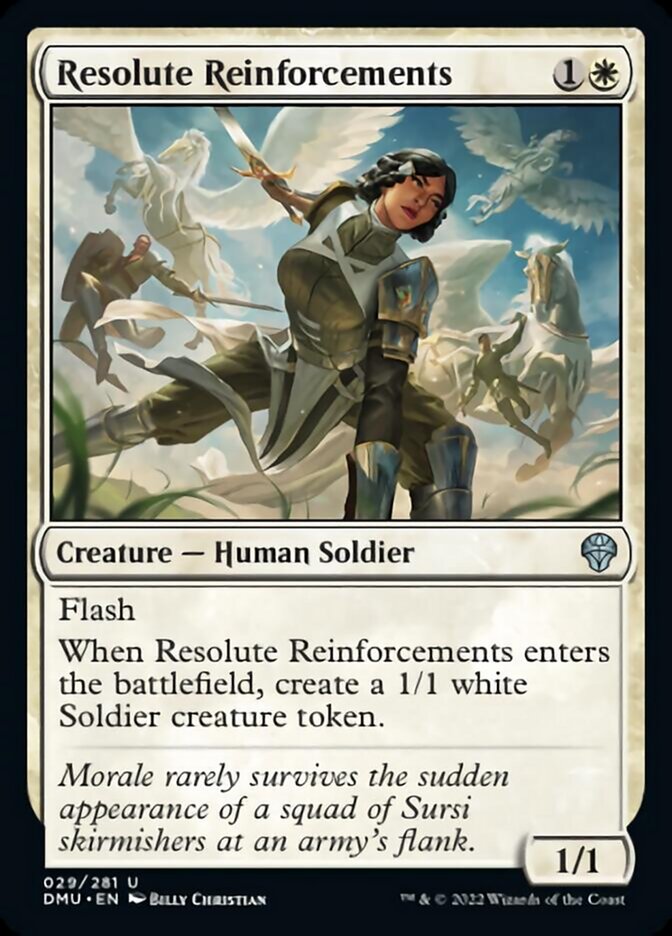
Rating: 4/10
Raise the Alarm is a very solid card, and having it in creature form is likely to be an upside. Unlike Raise the Alarm, Resolute Reinforcements can be flickered, more easily returned from the graveyard, and so on.
All I’m thinking is, “where was this card when you wanted to double trigger alliance abilities back in Streets of New Capenna?”
Runic Shot
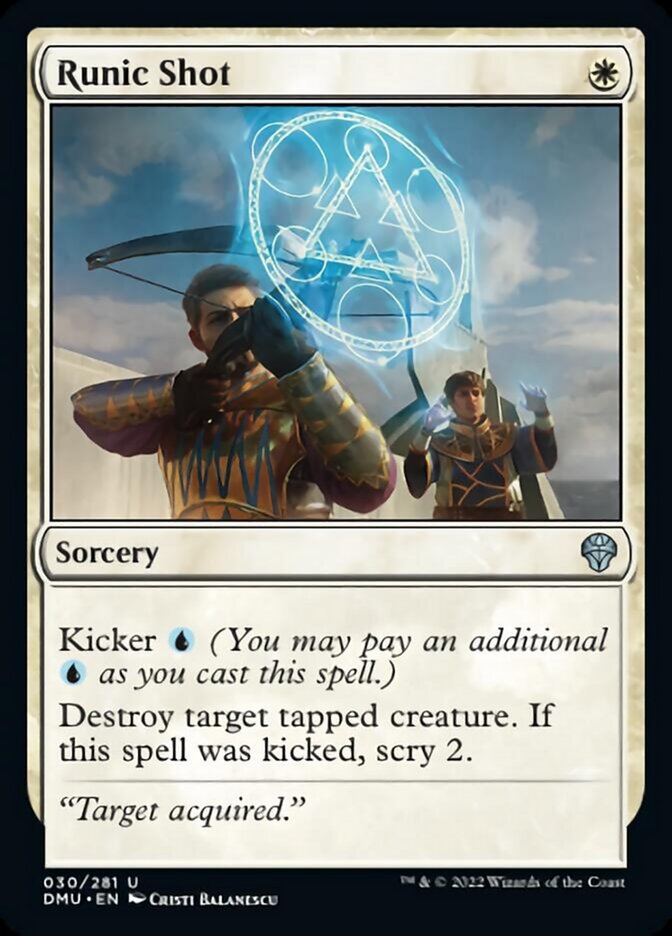
Rating: 6/10 without kicker, 6/10 with kicker
Sadly Runic Shot is a sorcery so you can’t destroy an attacking creature. Your target has to have already attacked you before you get to kill it.
That said, one mana is incredibly efficient so I’d guess I’d be happy to play this in a lot of white decks. I don’t even care about the blue kicker cost because getting to scry 2 is only a minor upside, so while I’ll do it if I have access to it it’s not something I’m actively going for.
Samite Herbalist
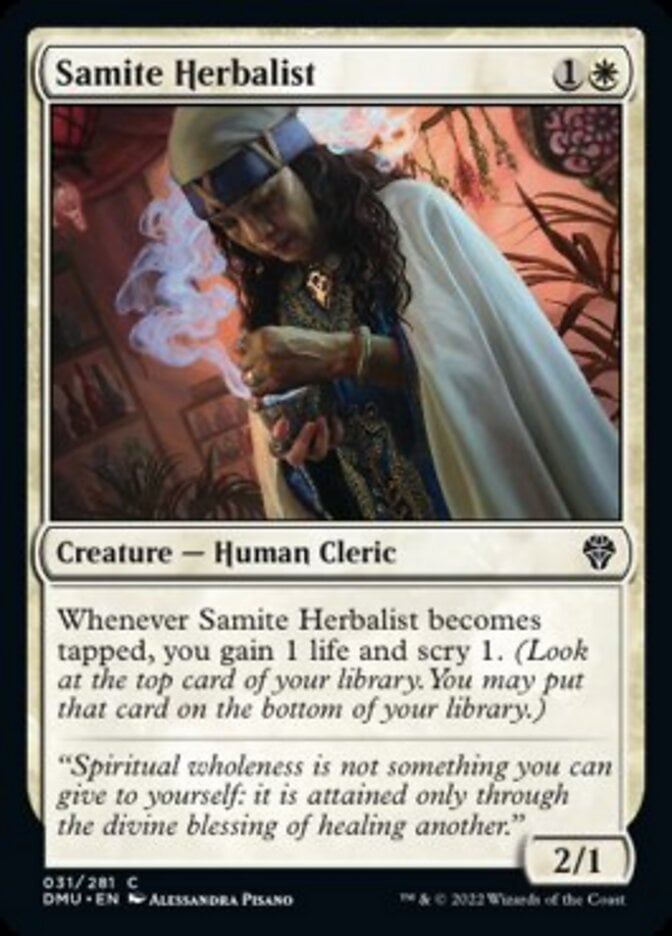
Rating: 5/10
Not only does Samite Herbalist trigger on attacking, but it also triggers when you use it for an enlist trigger. This makes it a really nice and versatile creature.
And being a 2-drop ought to make this a very high pick in any Draft. All aggressive white decks need a good number of 2-drops and this is bound to be near the top of the list thanks to the synergy with enlist.
Serra Paragon

Rating: 9/10
Mythic rares that give you free cards every turn are incredibly powerful. The idea is that if Serra Paragon goes untouched for several turns it just draws you card after card every turn and that easily wins you games.
I think the ideal play with this is to wait until you have six mana, cast it, and then immediately cast a 2-drop from your graveyard. It’s true you might not always have one, but you can hang onto it until you can make a profitable trade or two and use this to rebuild as long as you’re not in a hurry to commit this to the board.
On top of that it’s a big flier and casting it on turn 4 is still a good play to advance your aggressive game plan. There’s just nothing bad to say here.
Shalai’s Acolyte

Rating: 4/10 without kicker, 5/10 with kicker
We’ve seen vanilla 3/4 fliers for five mana every now and again, and they actually play out pretty well. Tacking on the option of being a 5/6 flier for seven is a nice bonus, but I’m honestly just happy with it at five and I’ll play Shalai's Acolyte regardless of whether or not I have access to green.
Stall for Time

Rating: 3/10 without kicker, 3/10 with kicker
Tapping two creatures is a reasonable effect, but not one that’s particularly high on your list of priorities. Drawing a card is nice and so is the blue kicker, but paying five mana for a Frost Breath that draws a card isn’t all that exciting.
Cards like Stall for Time definitely had their place in older formats, so I can see a situation where this ends up being better than it looks.
Take Up the Shield
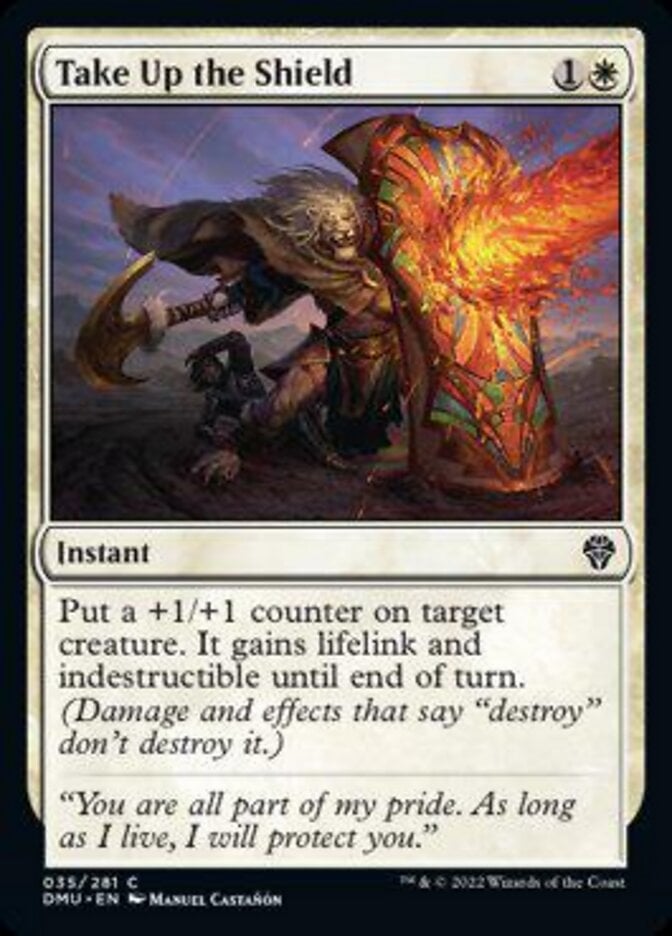
Rating: 4/10
We’ve seen a number of decent combat tricks that give +1/+1 and indestructible or protection from a color, so you can tell Take Up the Shield will be at least good. But lifelink pushes this well over the top, making it a really powerful trick that does a lot of work in helping your aggro deck win a race.
Temporary Lockdown
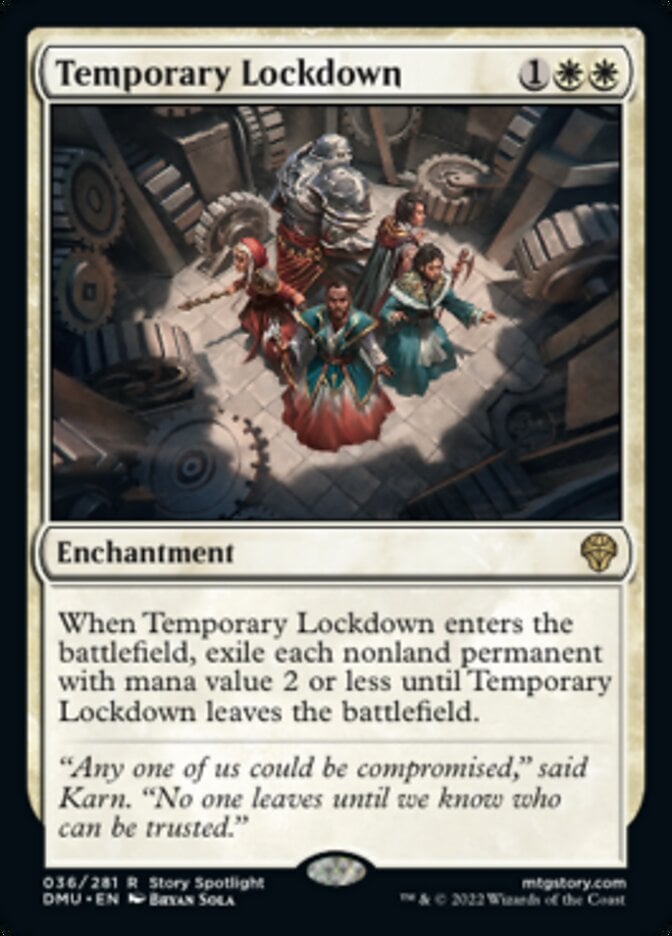
Rating: 6/10
Temporary Lockdown looks very powerful for Constructed and it’s bound to be good enough in Limited too. Immediately exiling all 2-drops is a great effect, and you’ll definitely pay three mana for that even if it only hits a couple of creatures.
If you have 2-drops of your own with this in hand you can just hold them back until you’ve used this to clear the early board and then play them afterward. It also kills all tokens, which should be especially useful in white mirrors.
Urza Assembles the Titans

Rating: 0/10
At this stage I probably don’t have to tell you why a rare saga only works if you have multiple specific mythic rares in your deck. Urza Assembles the Titans is obviously a Constructed plant. Let’s just move on.
Valiant Veteran
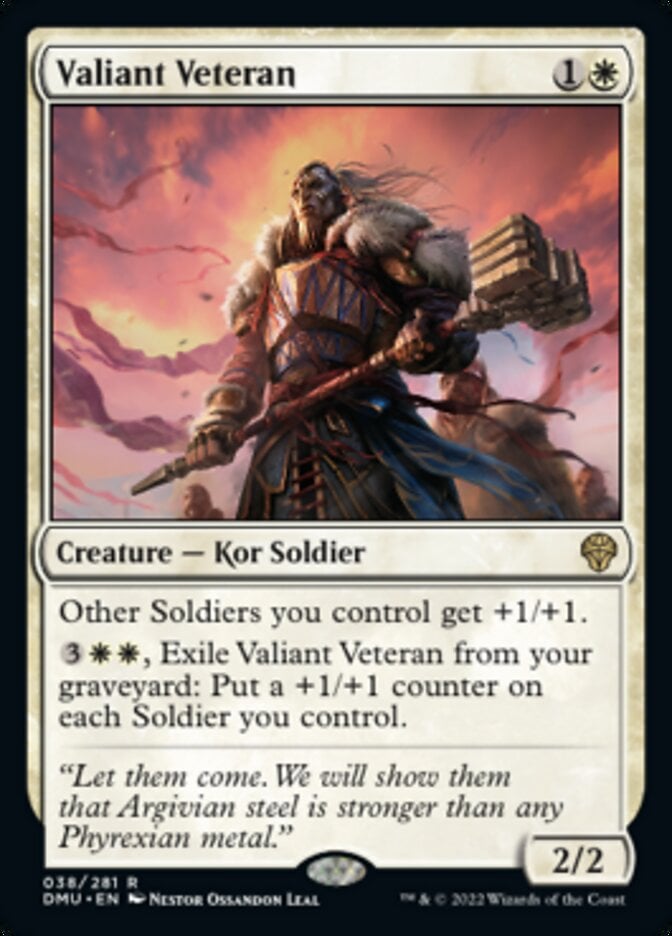
Rating: 7/10
There aren’t that many soldier creatures for Valiant Veteran to be buffing, but there are quite a lot of Soldier tokens, and turning 1/1s into 2/2s is something I’m very interested in. This cycle of lords is obviously going to be heavily reliant on how many creatures of that type you can find, but this one looks like it might be the strongest thanks to these tokens alone.
Wingmantle Chaplain
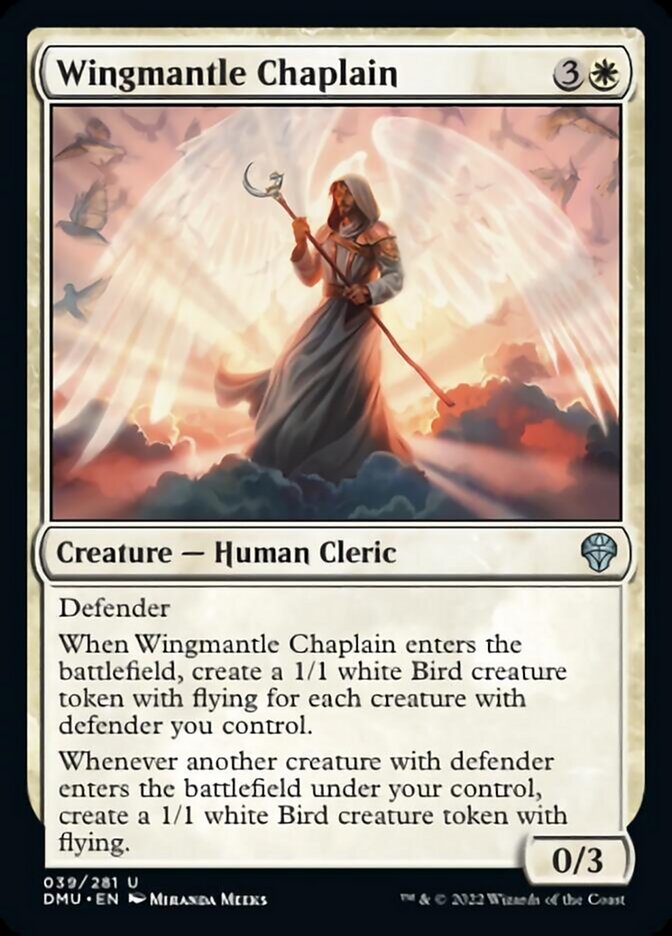
Rating: 5/10
I’m a huge fan of “defenders matter” as a Draft concept and it looks like there are a few cool payoffs for this in this set. Wingmantle Chaplain is the best of the bunch, creating free value based on your number of defenders.
The thing I don’t like is that the card sucks if you have very few defenders. Four mana to create a 1/1 flier and a 0/3 defender is just not good enough in a vacuum, so you can only really put this in a deck with enough defenders to make its trigger worthwhile. But you know I’ll be trying it as often as I can.
Blue
Academy Loremaster

Rating: 1/10
I really like Academy Loremaster’s design, but it has to be too much of a liability to bother playing. The trick here is that spells only cost two more for the rest of the turn, meaning you can still use your mana to cast instants on your opponent’s turn.
But the most important thing to remember about this is that your opponent gets to draw a card first. If they draw a card of her and then kill Loremaster then you’ve fallen way behind and I wouldn’t want to take that risk for a card that’s only giving me an extra card every turn if I’m willing to lose a lot of tempo or only cast instants.
This is really cool and I hope it sees play in Constructed, but as far as Limited goes I’m not sold.
Academy Wall
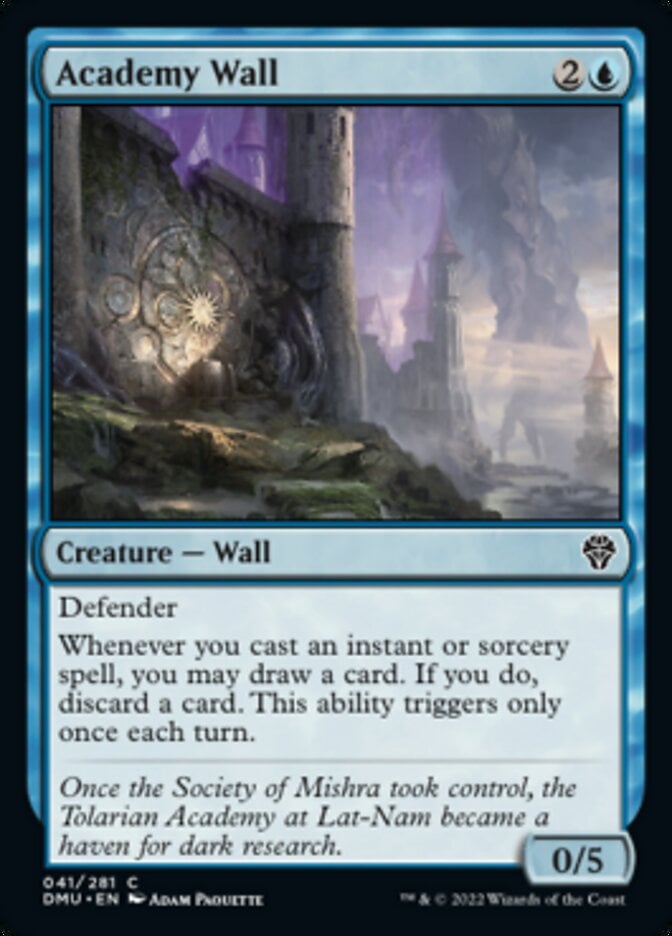
Rating: 3/10
There’s a lot to like about Academy Wall. Being a wall means it works with the defenders theme, getting to loot whenever you cast an instant or sorcery is a really nice bonus. Sadly I think you’d rather not bother with a card that can’t attack or dissuade your opponent from attacking unless you have a deck that is heavily dedicated to either of those strategies.
Aether Channeler

Rating: 7/10
There’s just no way that Aether Channeler is ever bad. Like Callous Bloodmage from Strixhaven, it has three great abilities that are always good even if it’s nowhere near the level of a bomb rare and isn’t exactly setting the world on fire.
On top of that, the flexibility of choosing whichever one you need the most is exactly why this card deserves a high rating and you should always just take it and play it.
Battlewing Mystic
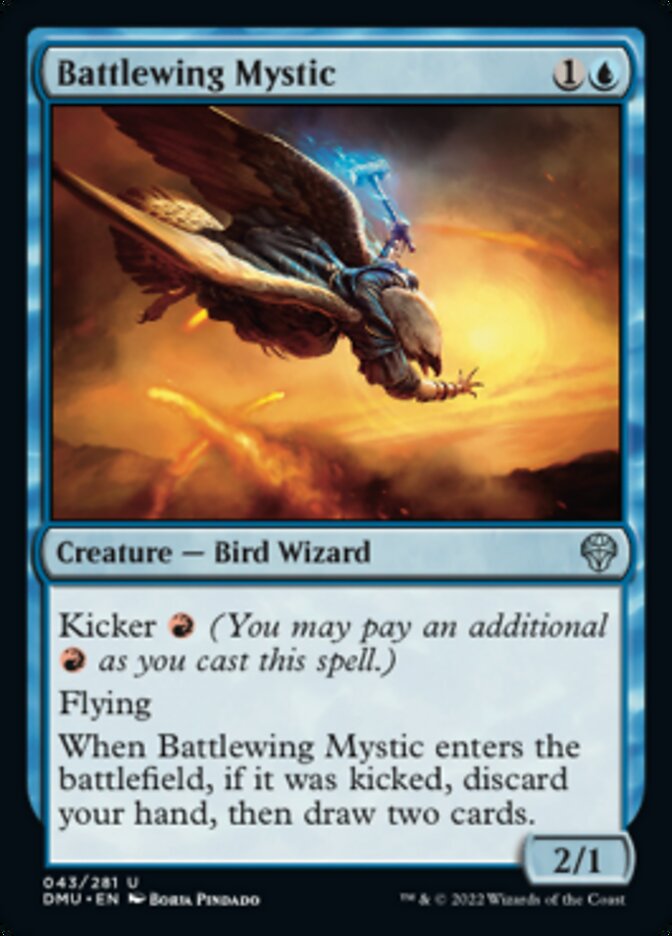
Rating: 5/10 without kicker, 6/10 with kicker
A 2-mana 2/1 with flying is already a great card that I’m happy to play in every blue deck (I’m sensing a pattern here, a lot of these kicker cards appear to be that). The kicker is very interesting, and I imagine top decking Battlewing Mystic with no cards in hand feels amazing.
You’ll probably just play this as a 2-drop and be happy most of the time, even with access to red mana.
Combat Research

Rating: 4/10
While a certain subset of players absolutely love cards like Combat Research, I’m not its biggest fan. While it’s true that auras suck, this has already paid for itself if you can guarantee to get a hit in. From there on it threatens to take over a game if left unchecked, and that’s quite a threatening card.
Still, it’s difficult to find a good spot to play it and guarantee a hit as the +1/+1 buff is only going to legendary creatures.
Coral Colony
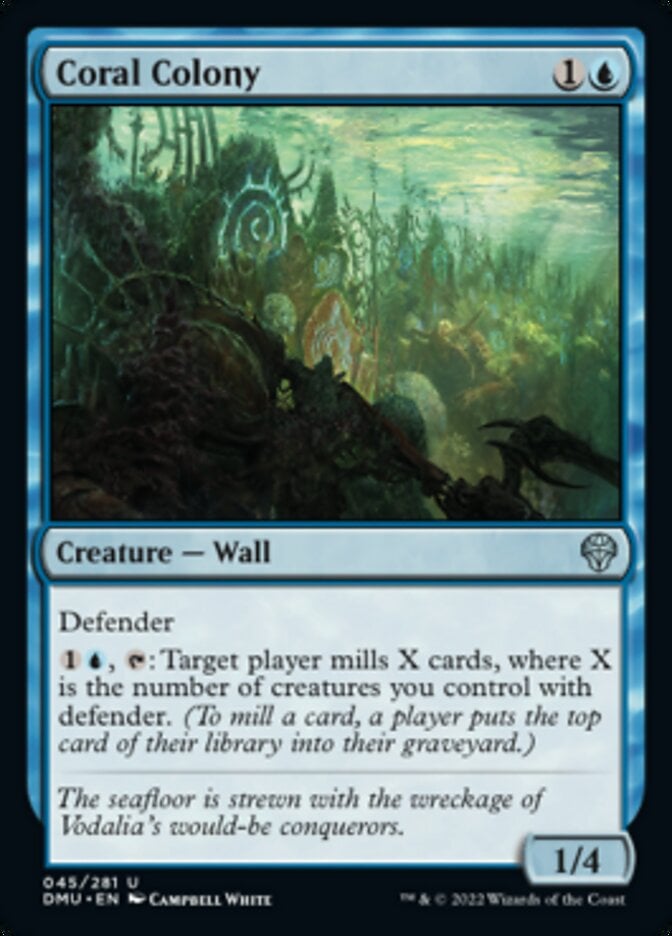
Rating: 4/10
Doorkeeper was always a funny card, and Coral Colony is a significant upgrade on it. Having one point of power makes all the difference since a lot of creatures can’t afford to attack it.
On its own, it mills a player for one card which isn’t enough to be a win condition by itself, but there are enough walls in the set that should turn this into a really viable way of winning the game. If I see this early it’s probably the sign I need to take it and start going into walls.
Defiler of Dreams
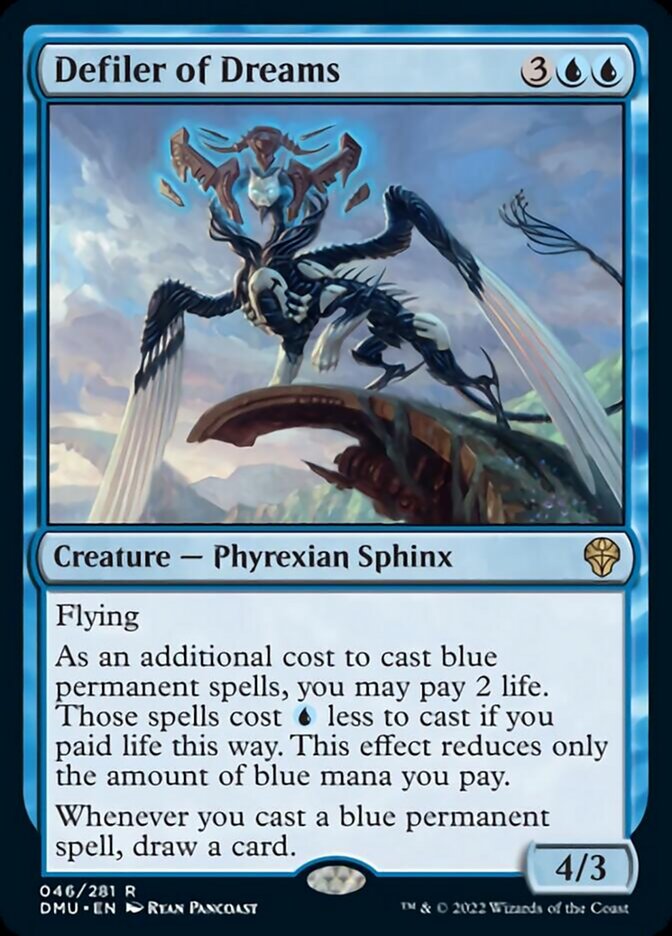
Rating: 7/10
What I’m really interested in on Defiler of Dreams is the final line of text that says you draw a card whenever you cast a blue permanent spell. Netting you a card for every blue creature you play is a really powerful effect, and it’ll be a very influential card assuming you get a card or two off of this.
Other than that this is just a 4/3 vanilla flier, which is still fine and I’ll never cut it from a blue deck. But I still want the other abilities to be relevant when I play this.
Djinn of the Fountain
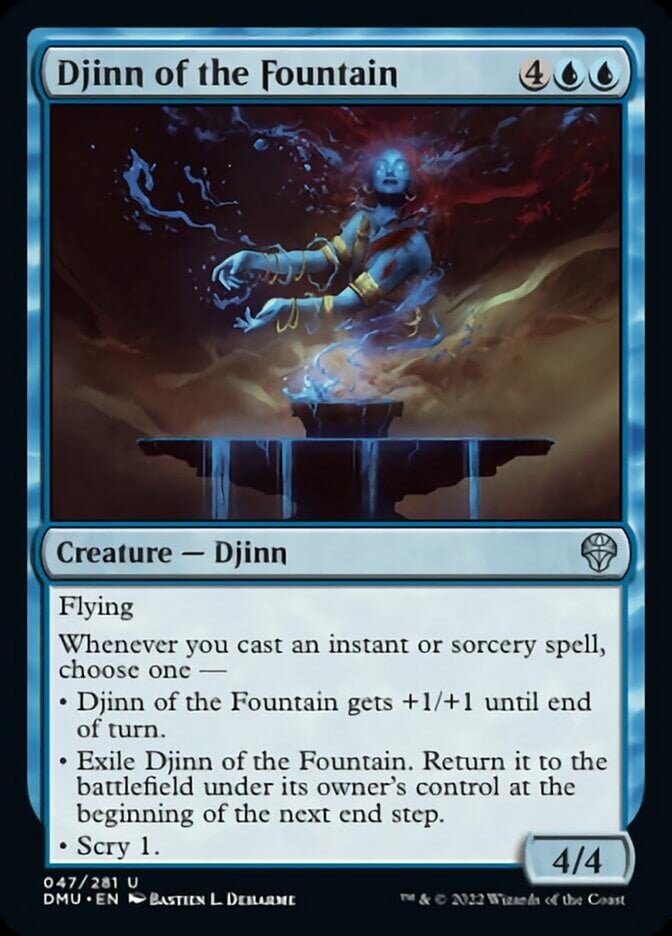
Rating: 6/10
Given that any blue deck you draft is likely to have a good number of instants and sorceries in it I’d imagine that Djinn of the Fountain has a good chance of triggering a lot.
A 4/4 flier for six mana is a little over costed for my liking, but it’s still very reasonable on its own. The variety of abilities you can trigger should also make this a nice curve topper in your spells decks.
Ertai’s Scorn
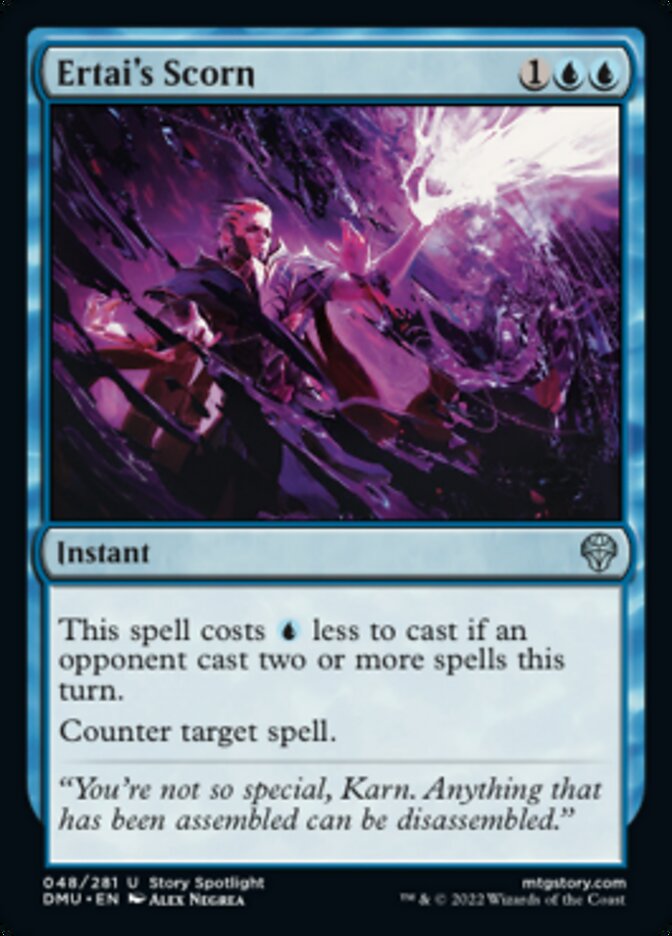
Rating: 1-5/10
Ertai's Scorn’s alternate casting cost isn’t all that likely to happen, or at least it’s not something you can rely on. This is just going to be a Cancel with a minor upside, and Cancel is a card that varies greatly in power level from one set to another.
This is a great card for blue if this format is slow and grindy. But if it’s fast and aggressive then it’s virtually unplayable.
Essence Scatter

Rating: 5/10
Unlike Cancel, you can always rely on Essence Scatter in a Limited deck. Colloquially known as the blue Doom Blade, this counterspell has been a good and solid playable pretty much every time we’ve seen it.
And with a heavy spells theme running through blue, this is a card that should be high on your list of priorities.
Founding the Third Path
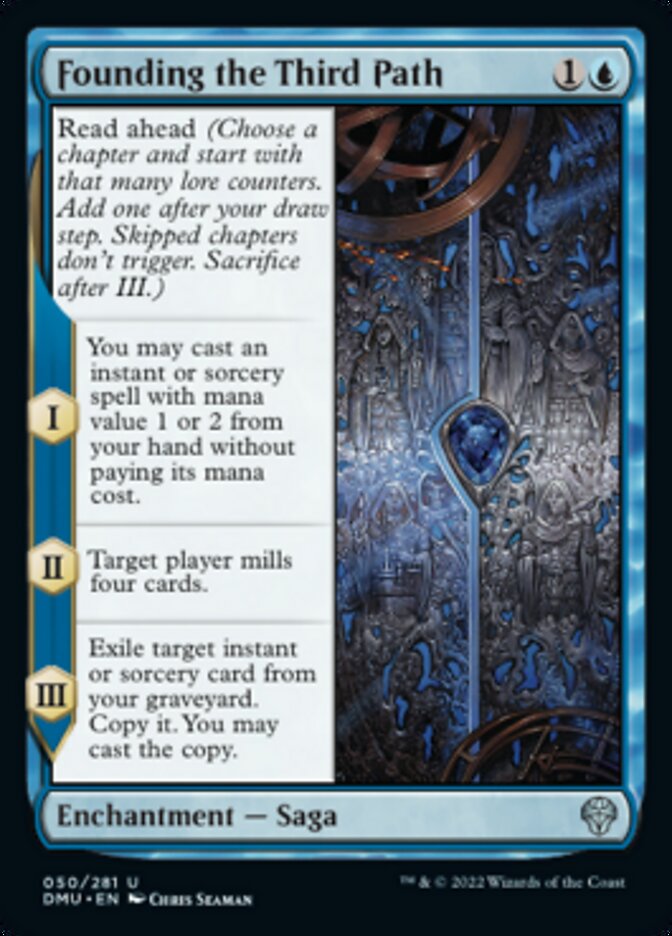
Rating: 4/10
Founding the Third Path is a weird design in my opinion. The first chapter does pretty much nothing since you’ve spent two mana on this saga anyway, so cheating out a 1- or 2-drop is a bit meaningless, but you can skip on a card’s color requirements.
Milling a player doesn’t seem all that relevant in this set either. I think the only chapter you actually care about is the final one, which basically lets you flashback a spell in your graveyard, which isn’t a bad deal for two mana.
But it’s still a little too situational to make this a card I’d want in every deck.
Frostfist Strider
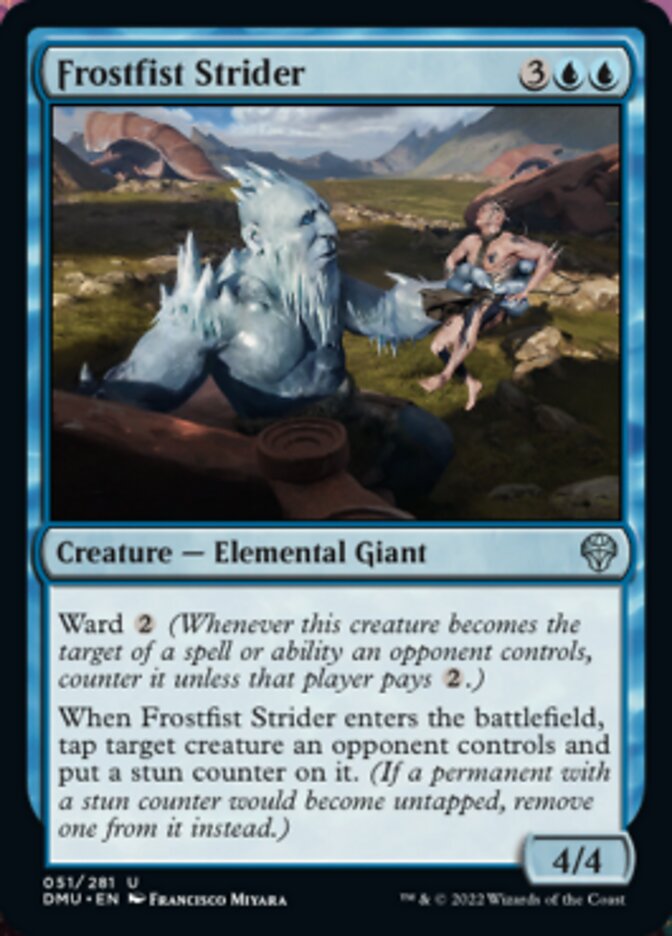
Rating: 6/10
There’s a reason why Berg Strider was one of the best commons in Kaldheim. Huge 4/4s that freeze a creature for a turn make for incredibly powerful tempo swings. I’m not surprised it’s been bumped up to uncommon and you even get a ward 2 on Frostfist Strider to make it an even more ridiculous threat.
Love it, love everything about it.
Haughty Djinn

Rating: 7/10
Even as just a 1/4 flier, Haughty Djinn looks great. I’ll happily play a cheap flying creature that nets me mana on all my spells, and the fact that it’ll be huge when I draw it late is just the icing on the cake.
In theory, there’s never a point in the game where this should be a bad card to draw, and that makes for a great card that I actively want in my blue decks.
Haunting Figment
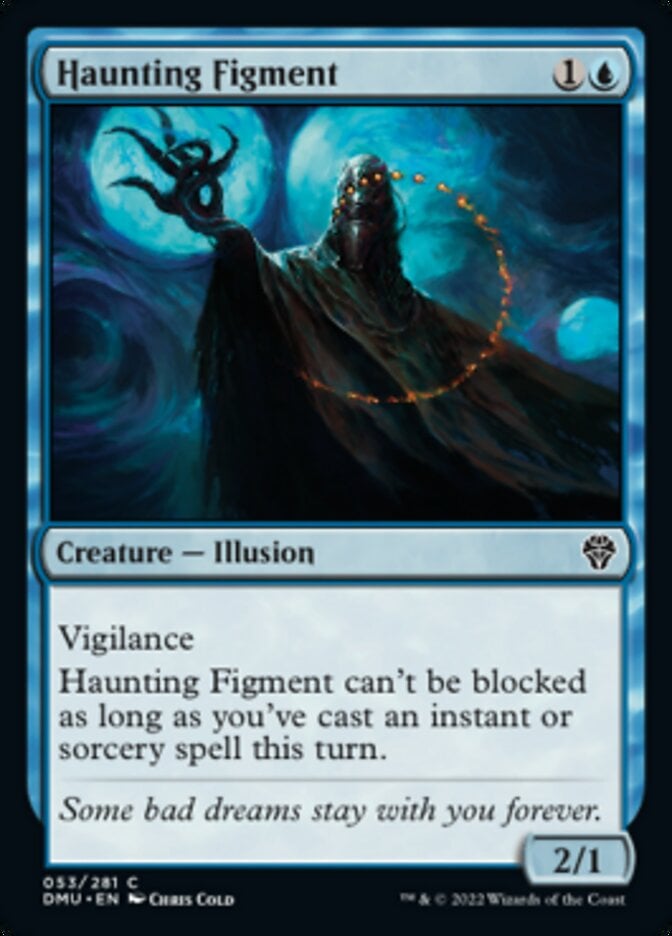
Rating: 4/10
Vigilance is pretty weird to see on a blue creature, having only appeared on a small handful in the past. That said it’s still upside and Haunting Figment being unblockable a bunch of the time only serves to make it more and more annoying as the game goes on, making it quite the handy 2-drop for a lot of blue decks.
Impede Momentum
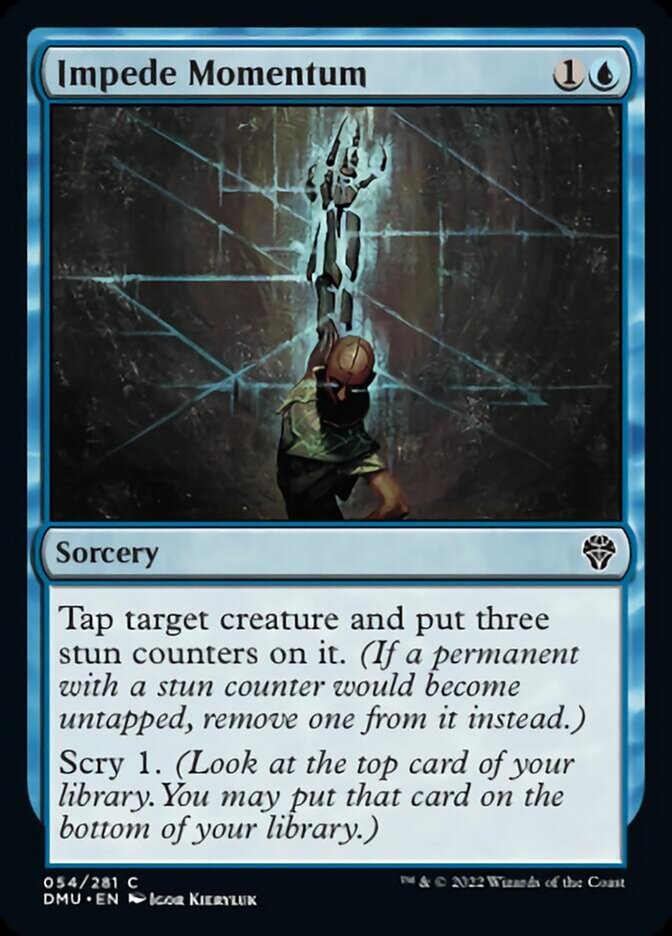
Rating: 4/10
Impede Momentum is a very nice card that’s only really possible thanks to stun counters. This still seems quite bad in control decks, but it looks very effective at getting big creatures out of your way and keeping your aggro going if you’re an aggressively slanted deck.
Impulse
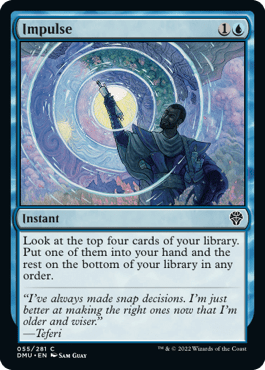
Rating: 3/10
You might be surprised at just how much better Impulse is than Anticipate, but that extra card makes a ton of difference. True, that doesn’t give Impulse an especially high grade, but that’s only because it’s not contributing to the board.
This card can and will be exceptional in a spell-heavy deck, you just won’t want it in many other spots. This is also a fantastic reprint that makes it legal in Pioneer and Modern, both of which are going to enjoy having it.
Joint Exploration
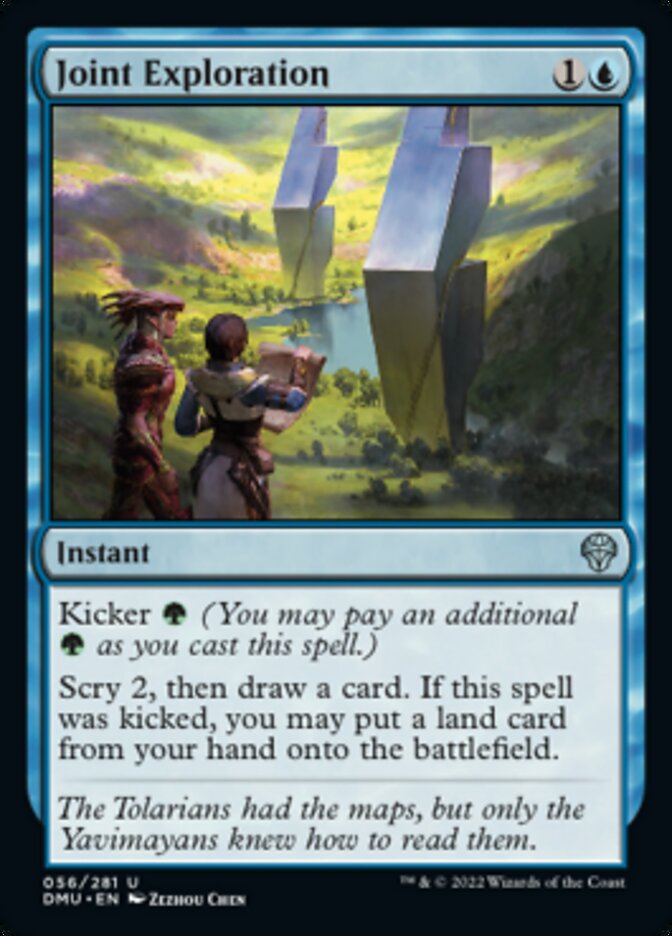
Rating: 3/10 without kicker, 4/10 with kicker
While Deliberate ended up being a fine card, it won’t be good enough for most decks. Joint Exploration should do just fine in a dedicated spells deck. Add in the kicker and you essentially have a 3-mana Growth Spiral, which is still a good deal.
While this isn’t the most exciting card in the world, it should be able to find a home.
Micromancer
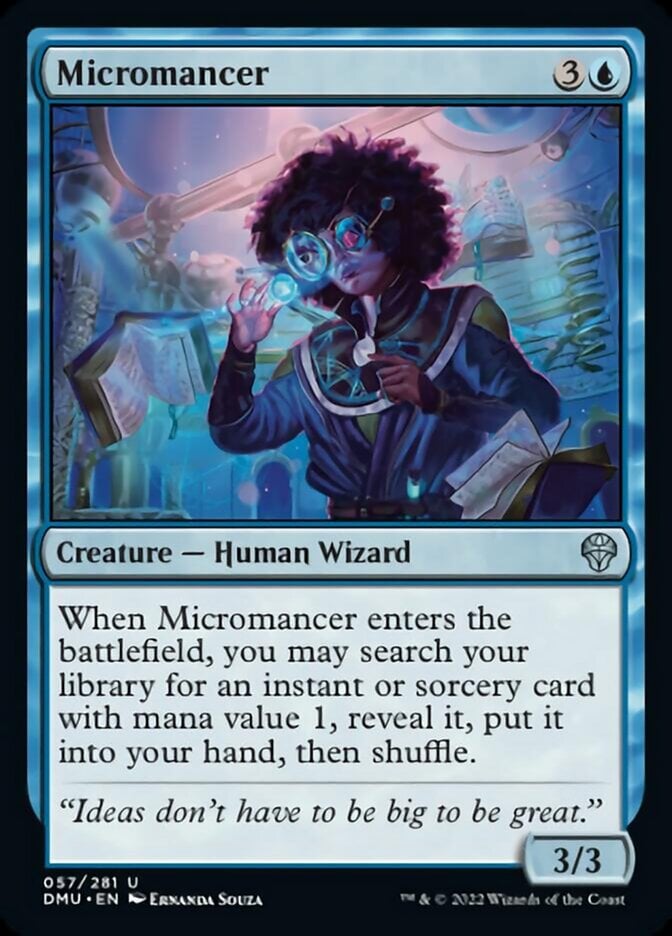
Rating: 3/10
There are a handful of 1-drop spells in the set that you can pick up, most notably Rona's Vortex and Cut Down, so Micromancer should be pretty good in the right deck. I’d want at least two targets in my deck before playing it and ideally about three or four, but once I have those I’m set.
Negate
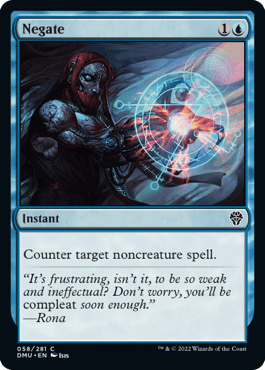
Rating: 2/10
Negate is back. As always, it serves as just a bit too narrow to be worth including in the main deck, but it should be a very effective sideboard card against the right matchups.
The Phasing of Zhalfir
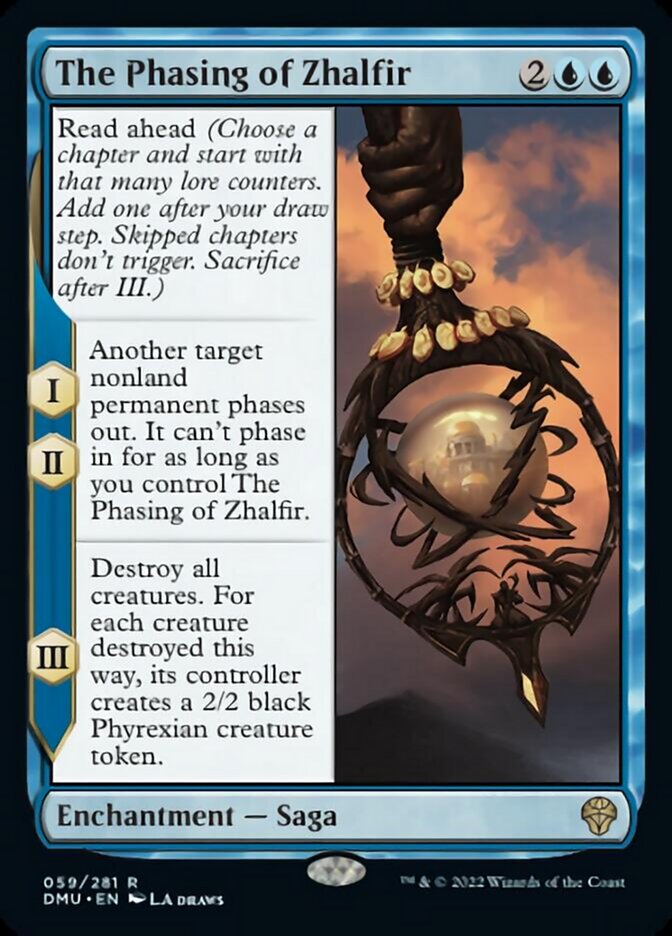
Rating: 2/10
A blue board sweeper naturally has to have a downside. Replacing each destroyed creature with a 2/2 is often too much of a downside to warrant clearing the board in the first place. You can start on one of the earlier chapters to save your creatures, but even good board sweepers are less effective if an opponent can see them coming.
The Phasing of Zhalfir is admittedly hard to evaluate since we just don’t have any good precedents to go on. While I doubt this card is strong enough to see much play, I could very well be wrong and am looking forward to seeing how it plays out.
Phyrexian Espionage

Rating: 4/10 without kicker, 5/10 with kicker
Divination is usually a reasonable Limited card, assuming that finding the time to cast it is possible. Phyrexian Espionage reminds me a lot of Probe, a card that was one of the better Dimir () cards in Invasion.
For a Divination to also have the flexibility of netting you an extra card, assuming that the format is slow enough to allow this card to be useful, it should perform very well.
Pixie Illusionist
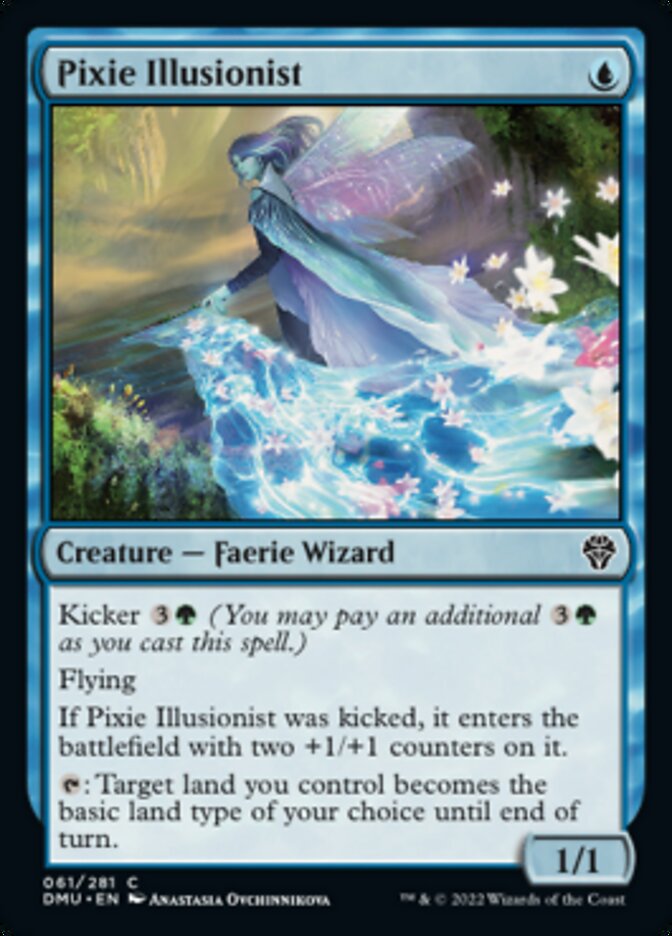
Rating: 3/10 without kicker, 4/10 with kicker
I remember learning about Faerie Squadron and being told how that was a good Limited card back in the day. I could never understand why the upside of getting to be a 3/3 flier for five made the card so good.
It’s just the fact that 1/1 fliers are great early but bad late, so having the option to make it bigger if you draw it late is really powerful. Tack on the Reef Shaman ability to help fix your colors and domain types should make for a really solid little common.
Protect the Negotiators

Rating: 2/10 without kicker, 5/10 with kicker
Counterspells that are forced to rely on the number of creatures you have in play have historically not performed very well thanks to how useless they are in the early turns of the game.. Unified Will ended up being a great card in Standard but was still a bit lackluster in the Rise of the Eldrazi Draft format.
Protect the Negotiators’s power lies in the kicker cost, where paying three total mana essentially gets you a 1/1 creature that counters a spell when it enters. That’s pretty good all around and doesn’t rely on an established board presence to make waves.
If you can leave this open on turn 3 then it can likely counter their 3- or 4-drop, putting you in good stead for the rest of the game. It’s also a strong play later when you are more likely to have some creatures out.
Rona’s Vortex

Rating: 3/10 without kicker, 5/10 with kicker
I’m normally a big fan of cheap bounce spells, but I much prefer them when I have the ability to bounce my own creatures to protect them from removal or tricks. But that doesn’t make Rona's Vortex bad, since costing one mana makes it playable on most turns and still has a number of good applications.
The kicker cost is a very welcome bonus if you have access to it, and having the option of either a cheap bounce spell or effectively a 4-mana hard removal spell makes for a very nice modal spell.
Shore Up
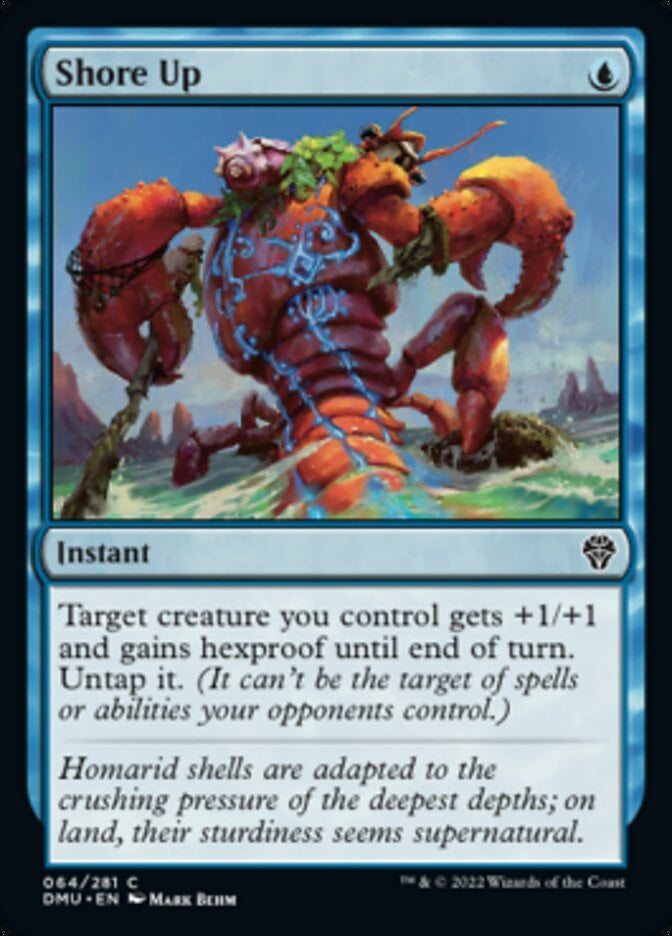
Rating: 2/10
I don’t typically like cards like Shore Up, and blue isn’t in the market for combat tricks in general. It definitely has its uses, but I think it’s bad enough that you can find a better combat trick and you never need to prioritize this over other spells.
Silver Scrutiny
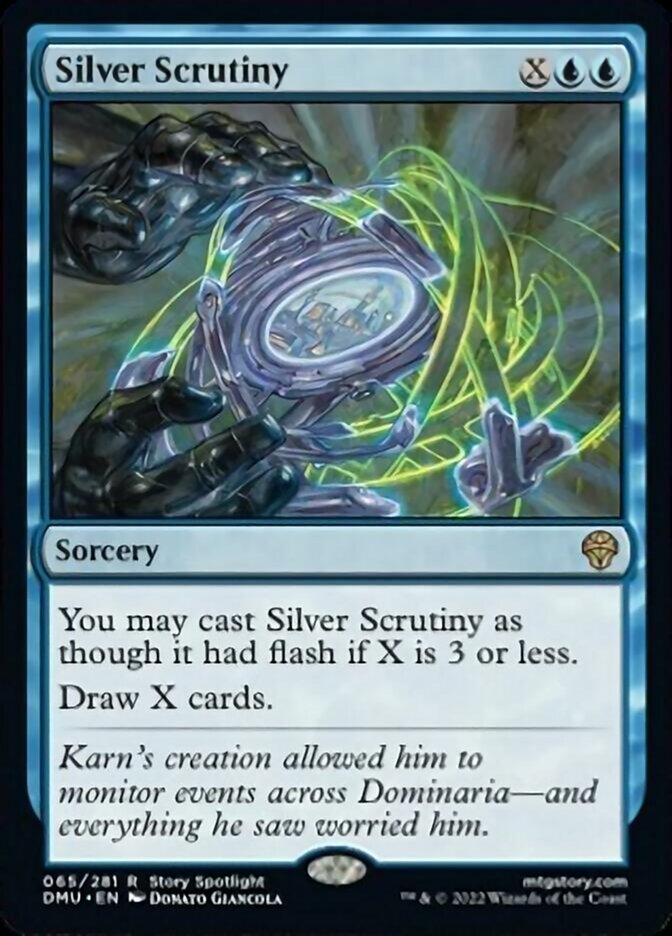
Rating: 5/10
It’s been a while since we last saw a good X draw spell. The difficulty with these is just that they’re clearly very powerful, but their entire ability to perform in a Limited environment is dictated by the speed of the format.
Silver Scrutiny will be a very powerful card if this format is slow and about winning games through grindy games and card advantage. But if the format ends up fast and about playing the board and playing aggressively, then it’s practically unplayable.
Soaring Drake
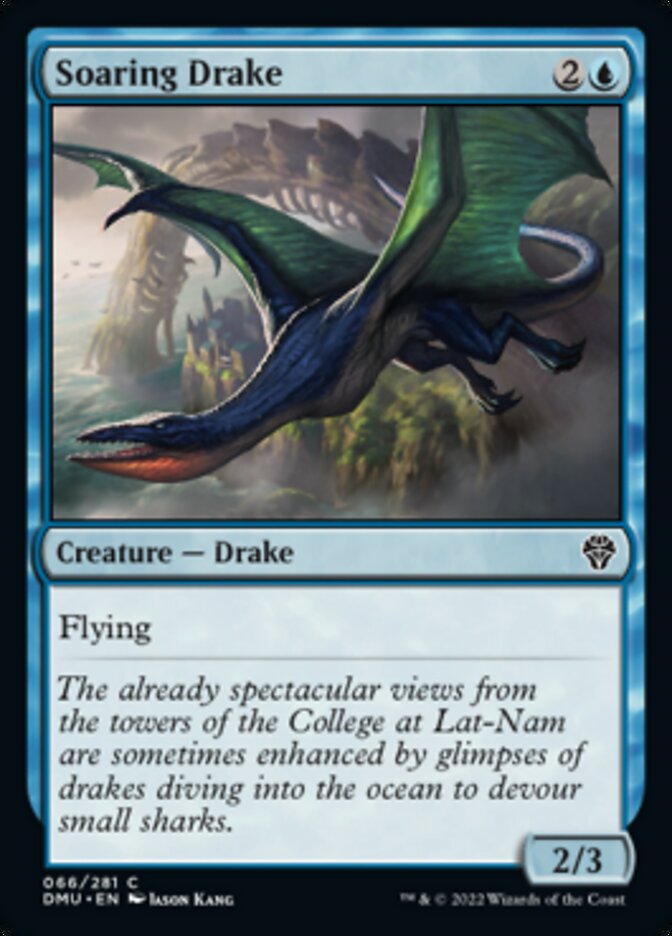
Rating: 5/10
There was a time when Wind Drake and Cloud Elemental was the standard sizes of common blue flying creatures. Now Soaring Drake makes history as the first strict upgrade over those cards while still being mono blue.
Cheap fliers are still pretty good, and this should be enough stronger than Wind Drake to be a very solid blue common.
Sphinx of Clear Skies

Rating: 9/10
A hard-to-kill threat that provides card advantage is pretty much the textbook definition of a bomb rare. You’re only going to have two land types in play which still lets you draw the best card from your top two in most decks.
While getting a free Fact or Fiction is pretty cute if you can get all five land types out, getting one card per hit is good enough to make Sphinx of Clear Skies a bomb.
Talas Lookout
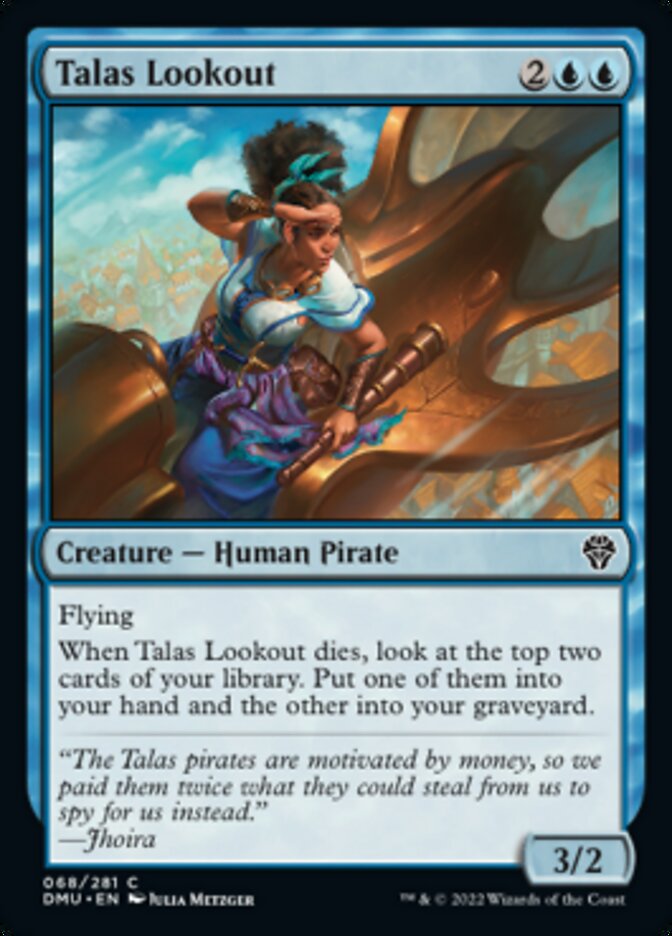
Rating: 6/10
4-drop fliers have been a little bit lackluster recently like we saw with Skyswimmer Koi, but one that draws you the best card from your top two when it dies is extremely powerful. I’d expect you can slot Talas Lookout into any blue deck to round out its curve.
Tidepool Turtle
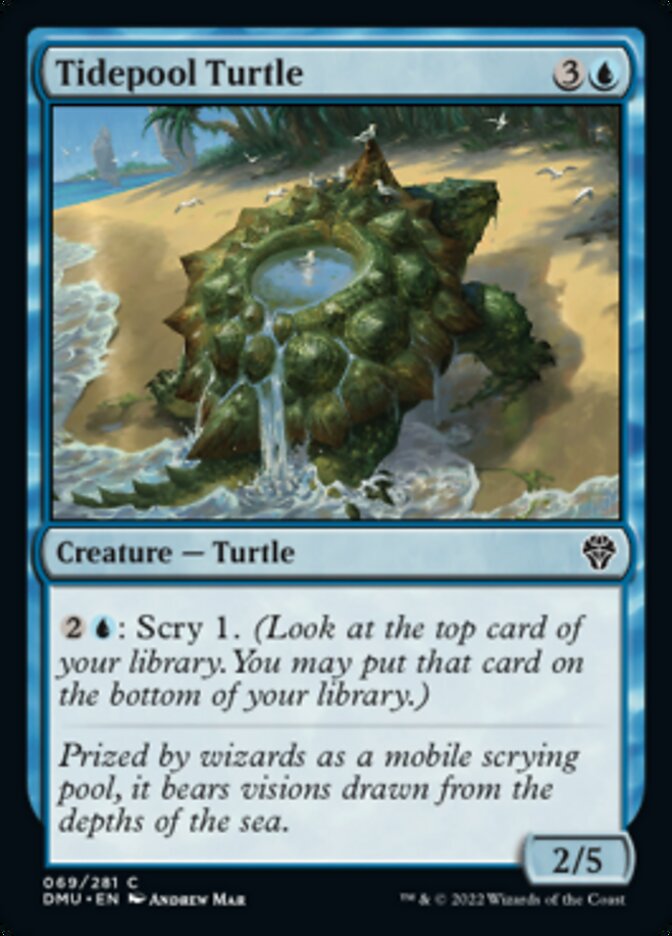
Rating: 3/10
Shelly’s back! Wishcoin Crab was a breakout star from Guilds of Ravnica as the blue decks always seemed to want a middle of the road defensive creature to hold off the assaults of the Boros () aggro decks.
This chonky turtle should do the job pretty well if they want a similar effect again, and even help you dig towards more spells. I hope Tidepool Turtle is good. If it is, the format will be slow and a lot of fun to play.
Timely Interference
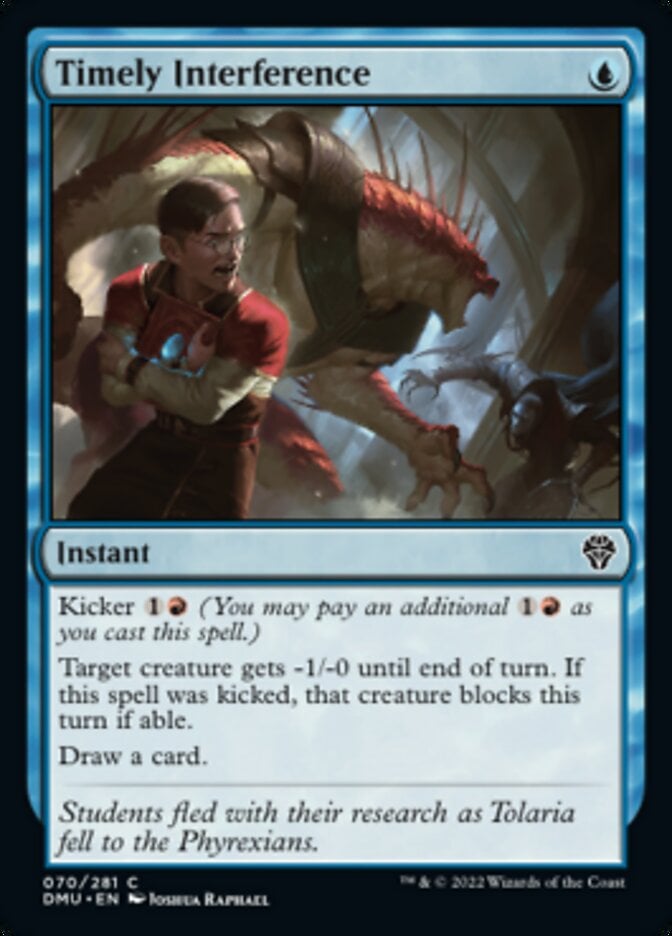
Rating: 4/10 without kicker, 4/10 with kicker
Although -1/-0 seems like a very small debuff, recent sets have shown us just how good these mediocre blue cantripping combat tricks can be. The red kicker is very situational since forcing a creature to block only tends to work when there aren’t any additional blocking creatures.
Timely Interference will be much more effective when used to ambush attackers or blockers.
Tolarian Geyser

Rating: 4/10 without kicker, 5/10 with kicker
Repulse is one of my favorite Limited cards. Although making it a sorcery reduces its effectiveness, Tolarian Geyser is still a very powerful ability to bounce a creature and draw a card. Tack on the life gain kicker mode and this becomes quite useful in stemming the bleeding against aggro decks as well as the usual modes.
Remember that one of the best ways to use these cards is to bounce your own creature, letting you reuse an enters the battlefield trigger or something similar. Hopefully, if you pick up this card you can find some sweet combos for it.
Tolarian Terror
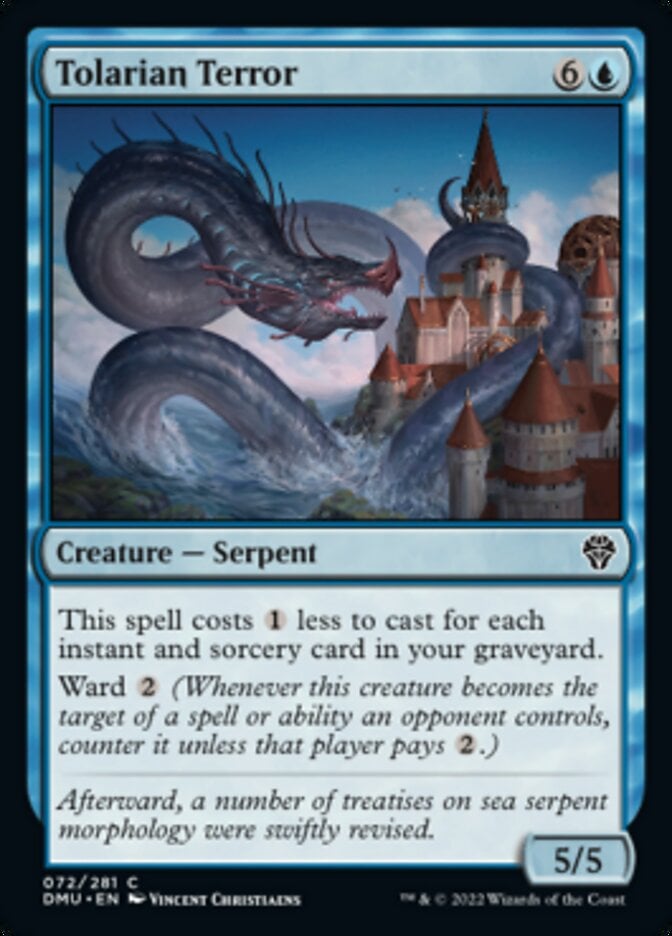
Rating: 5/10
You likely have a good number of instants and sorceries in your deck if you’re already in blue. Tolarian Terror seems like the easiest card in the whole cycle to enable since they’re designed to go to the graveyard.
As long as you have three spells in the graveyard this is a 4-drop 5/5 with ward, and at that point it feels pretty good to cast. It’s also very reasonable to expect that you can get the full discount on this from time to time. The potential to do that makes this a great common build-around.
Vesuvan Duplimancy
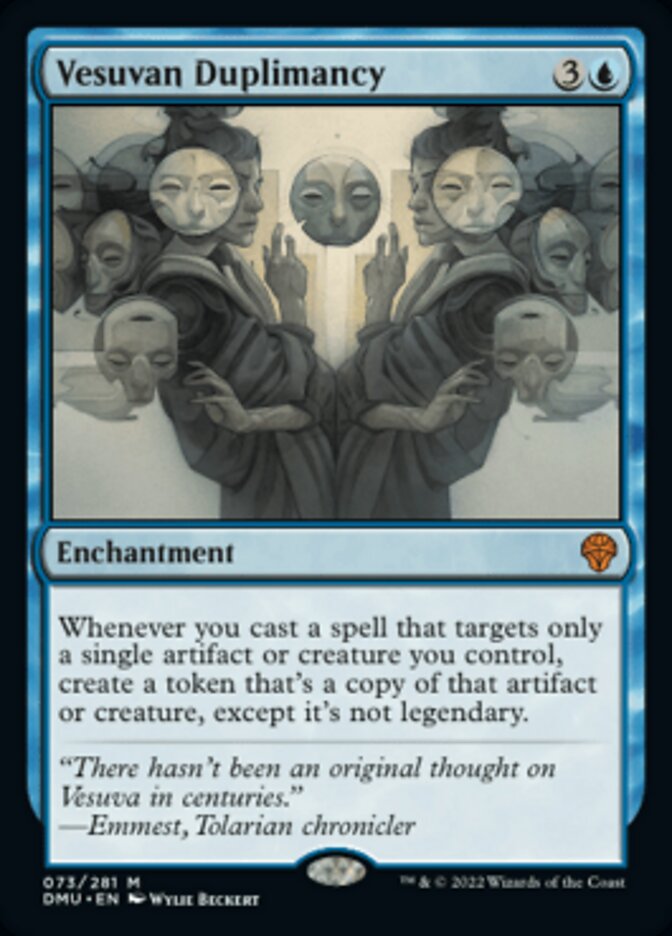
Rating: 2/10
These days you’re hard-pressed to find a reason to cast enchantments that do nothing until you do another thing. You can definitely justify it if that thing is something that you’re going to do a lot anyway, but to have a narrow trigger like this just seems bad to me.
Don’t get me wrong, the payoff is big enough that you’re rewarded for building around Vesuvan Duplimancy to some degree, but I don’t think there are going to be many opportunities to do so.
Voda Sea Scavenger
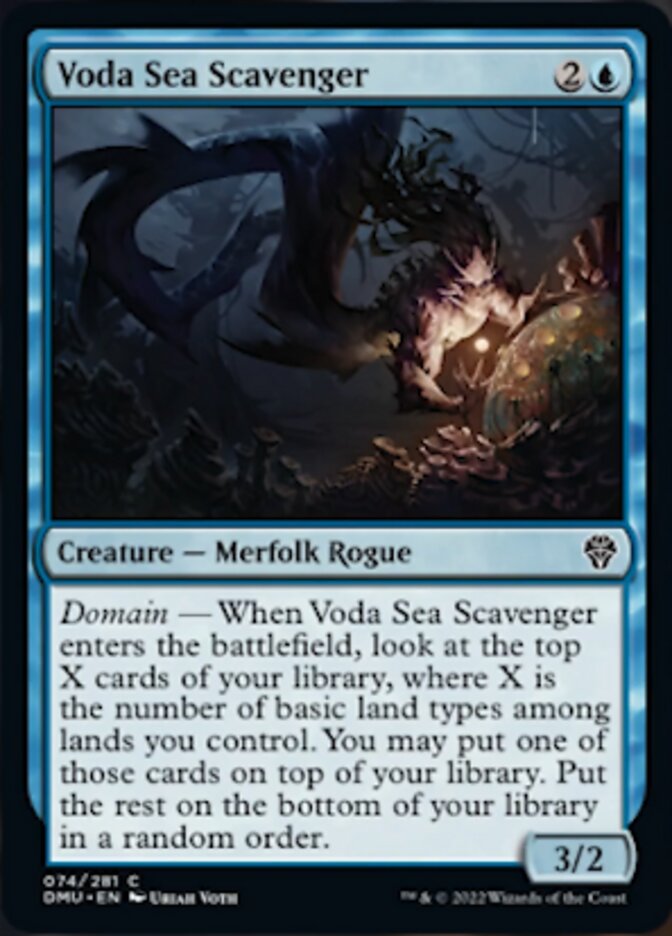
Rating: 3/10
Every color combination in New Capenna had access to Chrome Cat, and yet the card proved to be next to useless. Voda Sea Scavenger is essentially a scry 2 in most decks, which is of course a fair bit better than Chrome Cat.
But where this starts to shine is in decks that can support domain. If you have enough land types you’ll get to see enough cards that you’re extremely likely to find a good play for your next turn, which the right deck can probably make use of.
Vodalian Hexcatcher
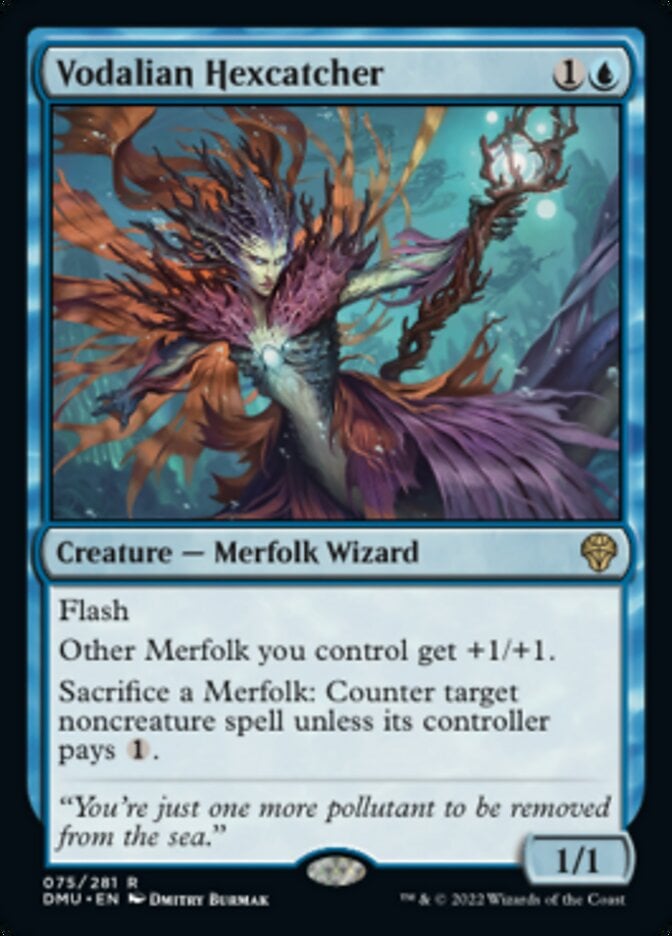
Rating: 2/10
While I’m excited to see if Vodalian Hexcatcher breathes new life into a Modern or Legacy merfolk deck, there just aren’t enough merfolk in this set to make this worth playing. Even if you had a couple I wouldn’t bother playing this at all.
The number of times this card has nothing to do are enough of a liability to want to avoid it.
Vodalian Mindsinger
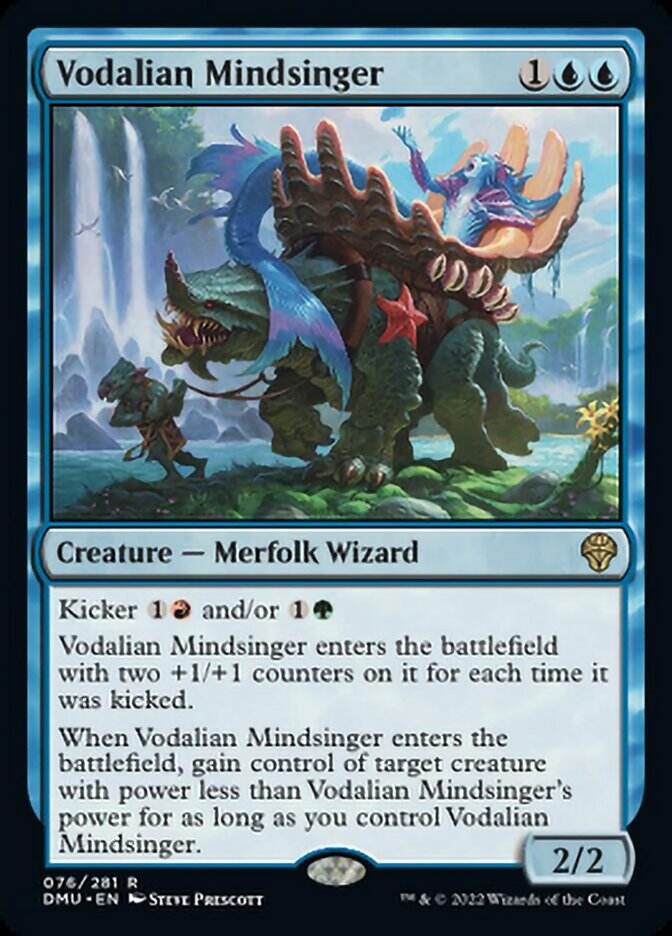
Rating: 4/10 without kicker, 9/10 with kicker
Vodalian Mindsinger can only steal 1 or 0-power creatures without the kicker, which while still powerful is a little too limiting. You really want either or both of the kicker costs to turn this into a ridiculous bomb rare.
Mindflayer is a very powerful card, and while there are still restrictions placed on what creatures you can steal, you should be able to steal the majority of creatures with both kickers at play and that still makes it a bomb.
Volshe Tideturner
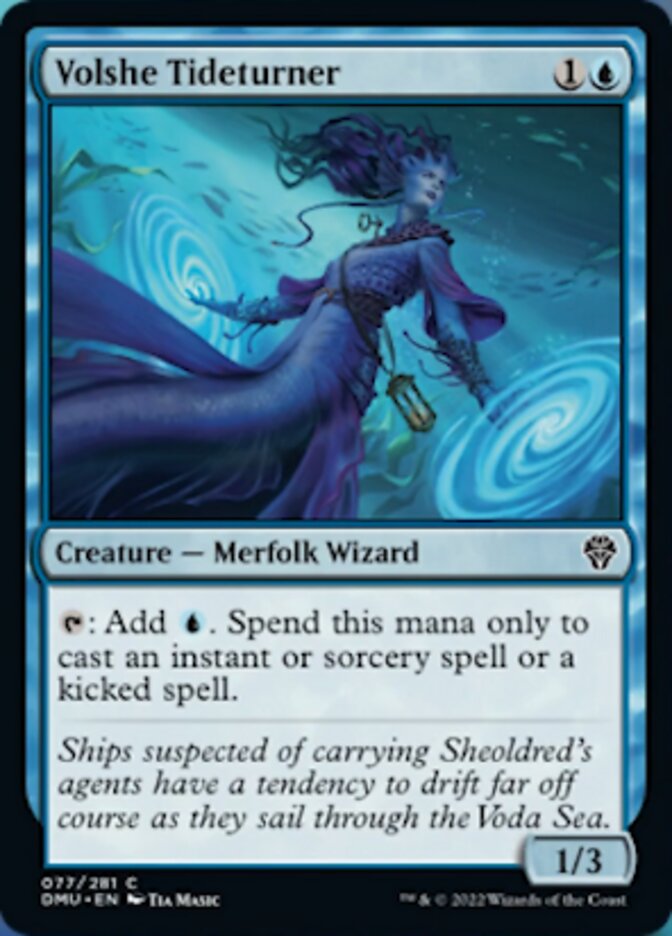
Rating: 4/10
Like Vodalian Arcanist in the original Dominaria, I expect Volshe Tideturner to be a very effective blue 2-drop. Most blue decks are bound to have enough instants and sorceries that this will always be useful as a mana dork.
Even if it isn’t needed, a 1/3 serves as a perfectly serviceable blocker.
Black
Aggressive Sabotage
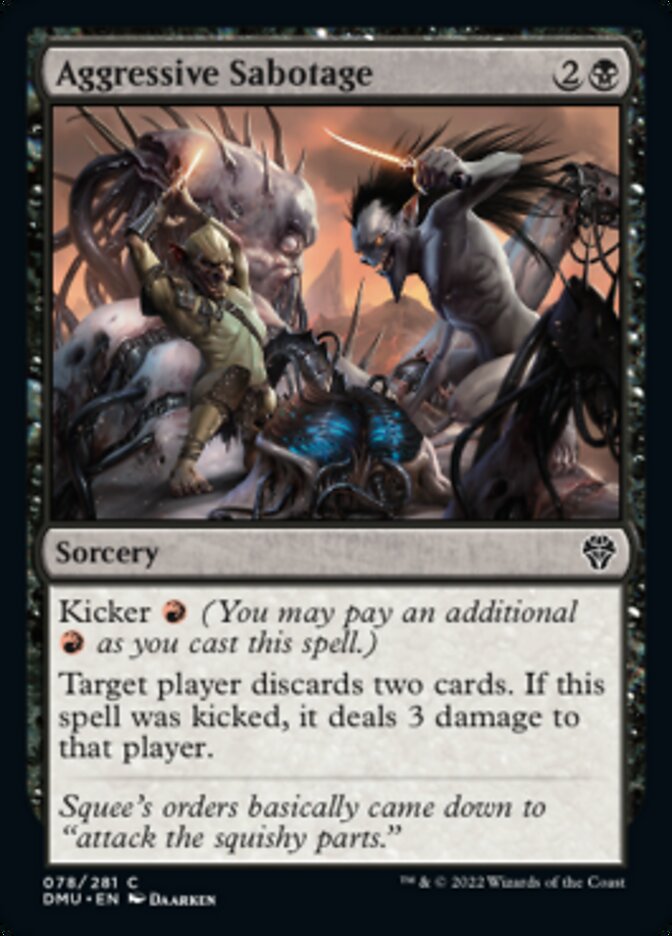
Rating: 3/10 without kicker, 3/10 with kicker
If your deck wants a Mind Rot, then you can’t go wrong with Aggressive Sabotage. The red kicker is really underwhelming, but a nice bonus that you’ll take if you happen to have it. It’s just not enough to make you want to play the card if you didn’t want a Mind Rot in the first place.
Balduvian Atrocity
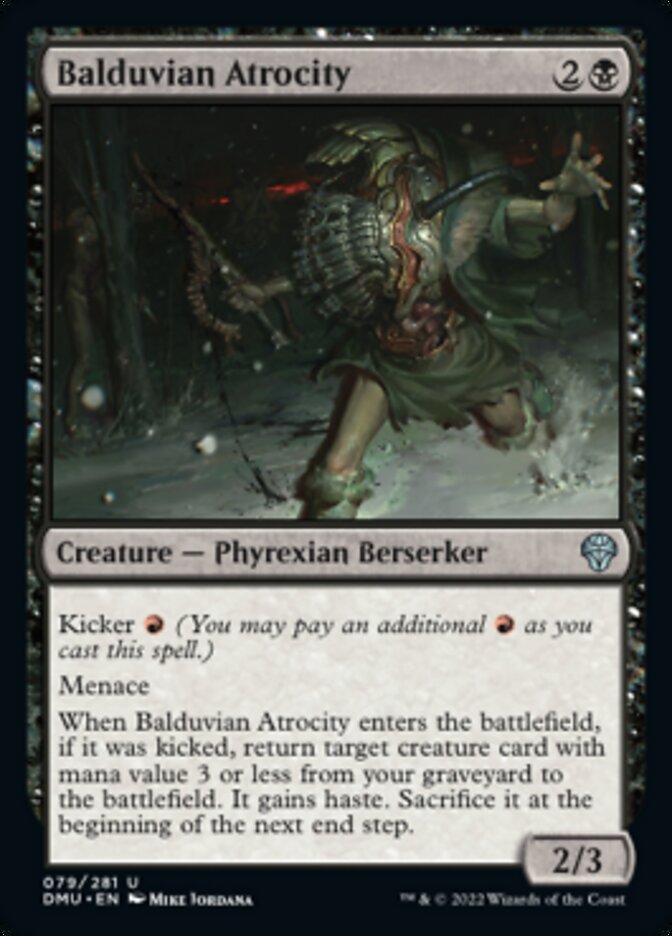
Rating: 3/10 without kicker, 4/10 with kicker
2/3 menace creatures for three mana can be very annoying, but that’s often all they are. The kicker cost is likely useful in sacrifice-themed decks, especially if you can reanimate a creature with a good ETB trigger.
Balduvian Atrocity has a lot of potential to overperform in the right deck, so definitely something to keep an eye on.
Battle-Rage Blessing

Rating: 3/10
I’m not usually a fan of black’s combat trick options, but a spell that makes your creature win any fight regardless of size is something to be interested in. I think Battle-Rage Blessing is likely worse than Bladebrand, but that turned out to be a great card in the right decks.
Battlefly Swarm
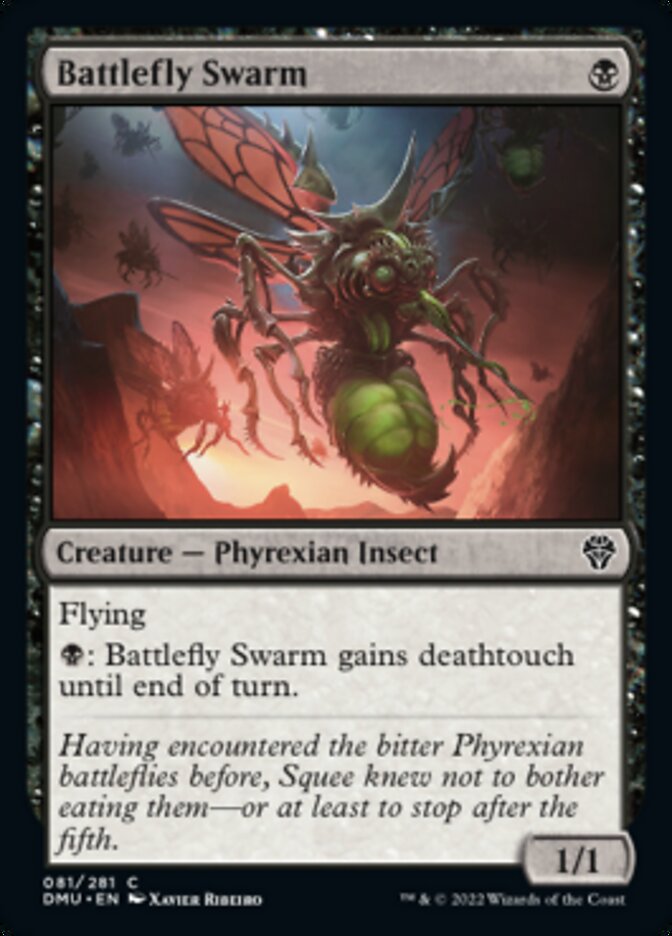
Rating: 4/10
1-drop fliers are great early and deathtouch creatures are good late so you should be happy to draw Battlefly Swarm at any point in the game, making it a really nice card for any black deck.
Blight Pile

Rating: 4/10
I think I’ve pointed this out in most of my set reviews, but I love 2-drop 3/3 blockers in Limited. The way they let you cause problems for aggro players is really satisfying, and Blight Pile not only does that but is also a decent payoff for the defenders matter theme that I’ll definitely be taking the time to draft at least a few times.
Bone Splinters
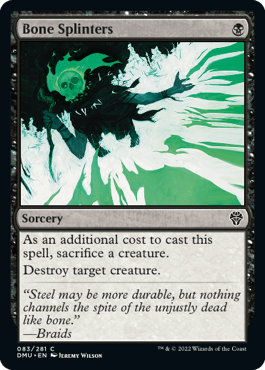
Rating: 5/10
Bone Splinters is a card we’ve seen time and time again, and it always seems to do some work. Costing one mana makes it really easy to cast, especially since you sometimes want to cast it in the same turn as a Threaten effect or some other kind of card.
The simplicity and efficiency of this card are what score it the most points. And with there being a sacrifice theme running through black in this set, a lot of decks are going to want to prioritize it.
Braids, Arisen Nightmare

Rating: 7/10
I suppose the question here is, are you happy to sacrifice a nonland permanent to draw a card and hit for two damage? If so, then Braids, Arisen Nightmare looks really strong. Black has a sacrifice theme built into it in this set, so I can imagine Braids acts as a good enabler for that strategy.
Your opponent can always choose to not sacrifice a thing, but beware that you don’t get to draw a card if they have a throwaway permanent of the same type. I imagine that’s fine since you should get some nice value as long as you have good fodder to feed to Braids.
Braids’s Frightful Return
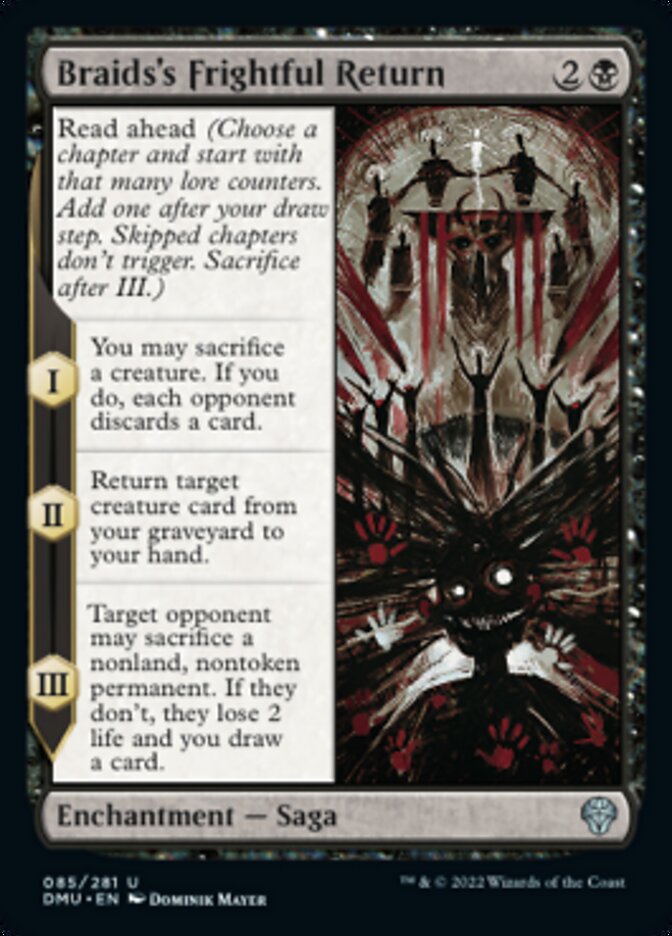
Rating: 5/10
I’m really not that interested in the first chapter of Braids's Frightful Return unless I have something rubbish in play that’s easy to sacrifice, so most of the time I’ll skip it. But the other two chapters are pretty great.
I don’t think your opponent is very likely to choose to sacrifice anything to chapter three, meaning this will more often than not be a 3-mana spell that lets you Raise Dead a creature, draw a card, and hit for two damage. I’d say that’s a pretty good deal overall.
Choking Miasma
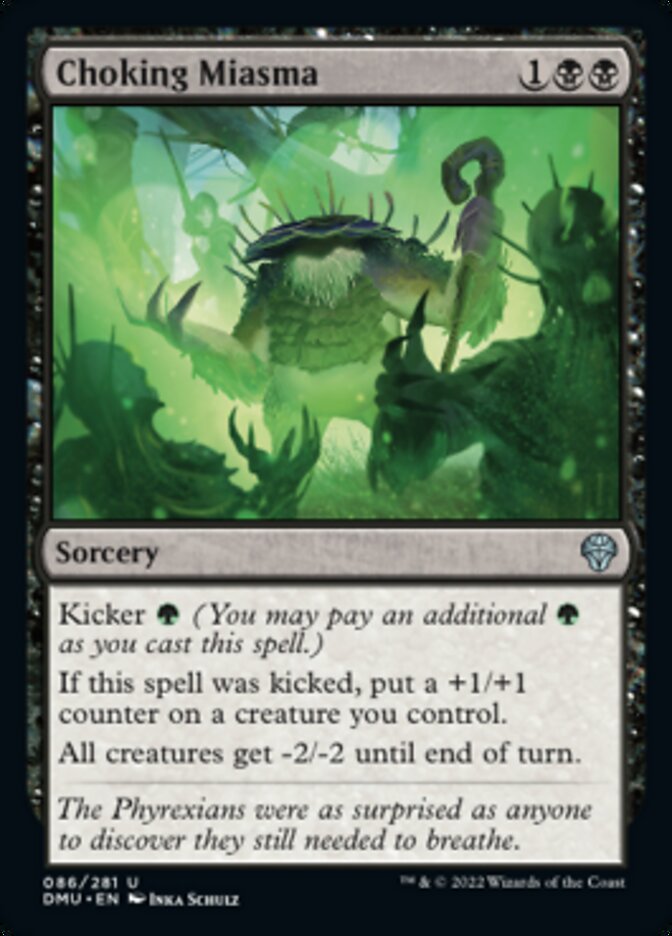
Rating: 5/10 without kicker, 6/10 with kicker
Infest effects tend to be quite strong, and they perform even better against aggro decks. It’s very possible that Choking Miasma will be better off starting in your sideboard, but there are some matchups where it will straight up win the game for you.
The kicker cost is a little weak, but it lets you play out a creature or two knowing that you can put an extra one of them out of range when you cast this.
The Cruelty of Gix
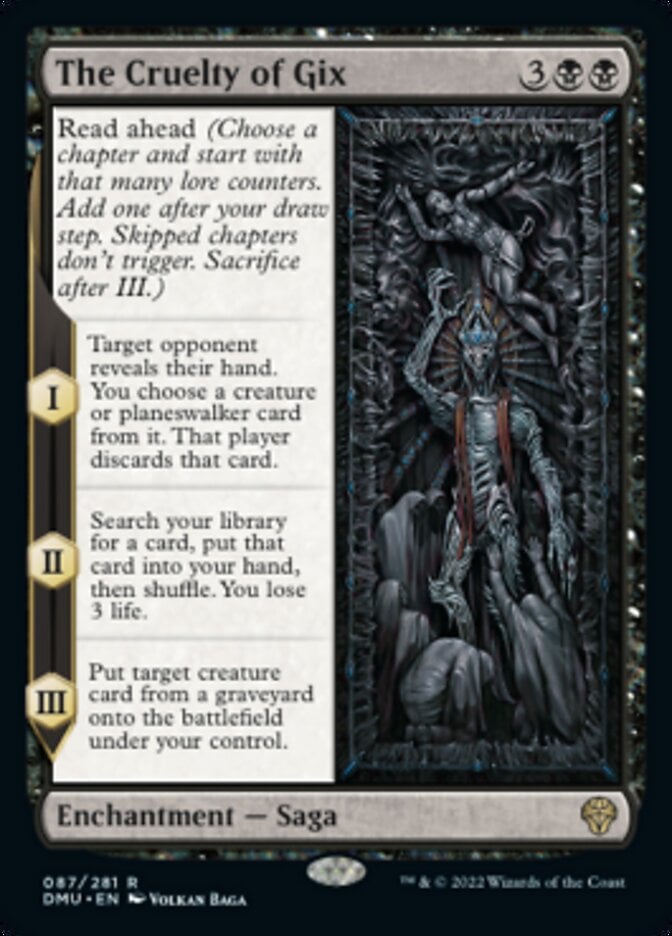
Rating: 7/10
All three chapters of The Cruelty of Gix are pretty weak for the amount of mana you’re spending, but getting all three (or a subset of them together) sounds like a good deal to me. Coercion into Grim Tutor into Zombify all for five mana isn’t a bad deal and I think the fact that you get all of them should be enough to make this card good.
If you don’t have time to waste not playing to the board, you always have the failsafe of just skipping to chapter three and reanimating a creature immediately. I think you’ll be happy with this more often than not.
Cult Conscript
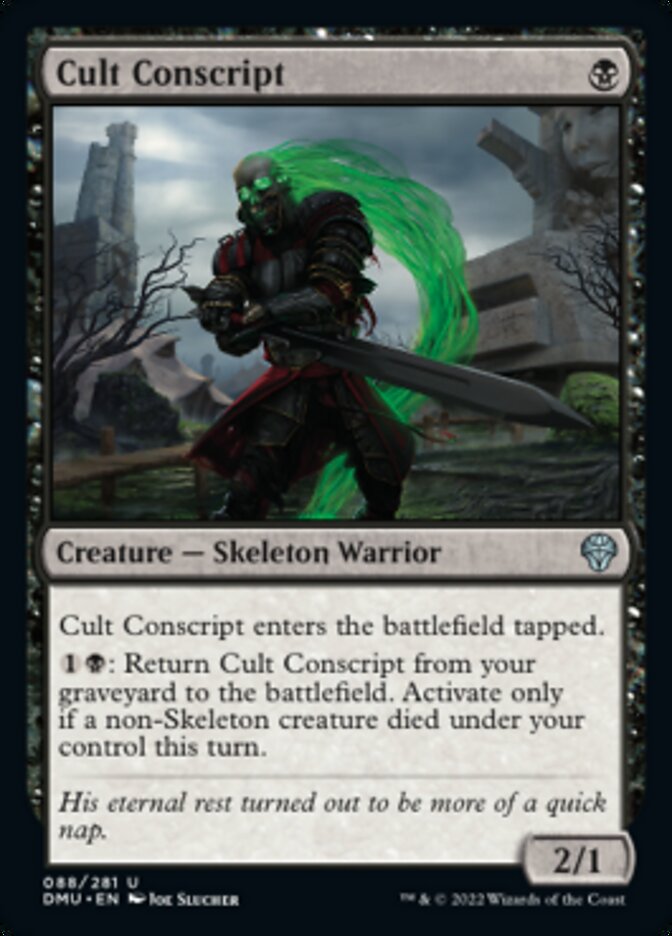
Rating: 6/10
Cult Conscript has to be one of the better variations of this card that we’ve seen in a long time. It may enter tapped but it can still block, and the ability to buy it back is really easy to get going.
Any other creature dying lets you get this back without spending any cards. This should be well suited for most black decks, not just aggressive ones, which is usually the downside of cards like this. If you have no way of exiling one then it’s likely very annoying to play against.
Cut Down
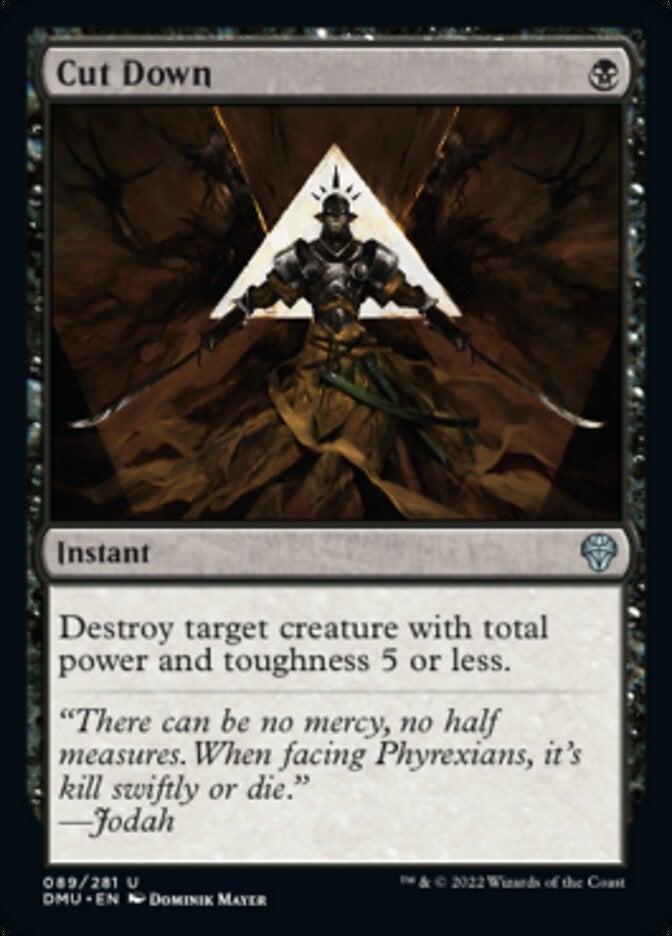
Rating: 5/10
Cut Down is a remarkably unique design for a removal spell, but one that’s only useful for killing cheap creatures. You should be able to kill pretty much all 1- and 2-drops and most 3-drops, but the inability to kill anything bigger really restricts the playability of the card.
At least -X/-X spells have the ability to shrink creatures during combat, but this has to outright kill a creature. The first copy will be welcome in any black deck, but successive copies will be considerably less useful.
Defiler of Flesh
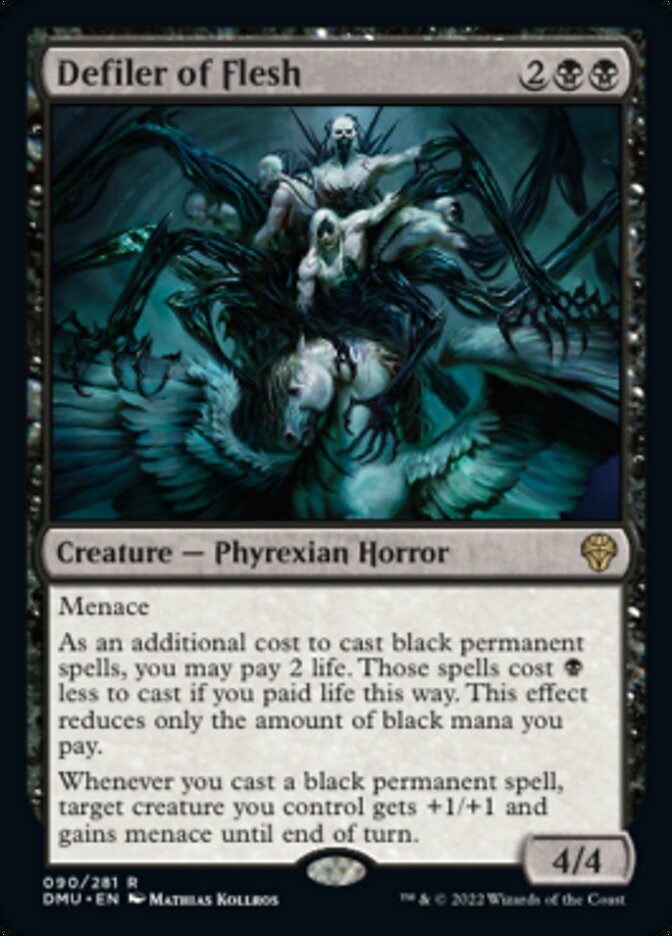
Rating: 7/10
As one of the two cheaper Defilers, you naturally expect the power level to be toned down a little. Granting a +1/+1 bonus plus menace is really strong and this along with being a big menace creature itself should really help you push through large chunks of damage in a race.
But this being only a temporary bonus makes Defiler of Flesh much worse when you’re playing a slower deck. That said your control decks still aren’t going to be turning down a 4-mana 4/4 with a bunch of upsides.
Drag to the Bottom
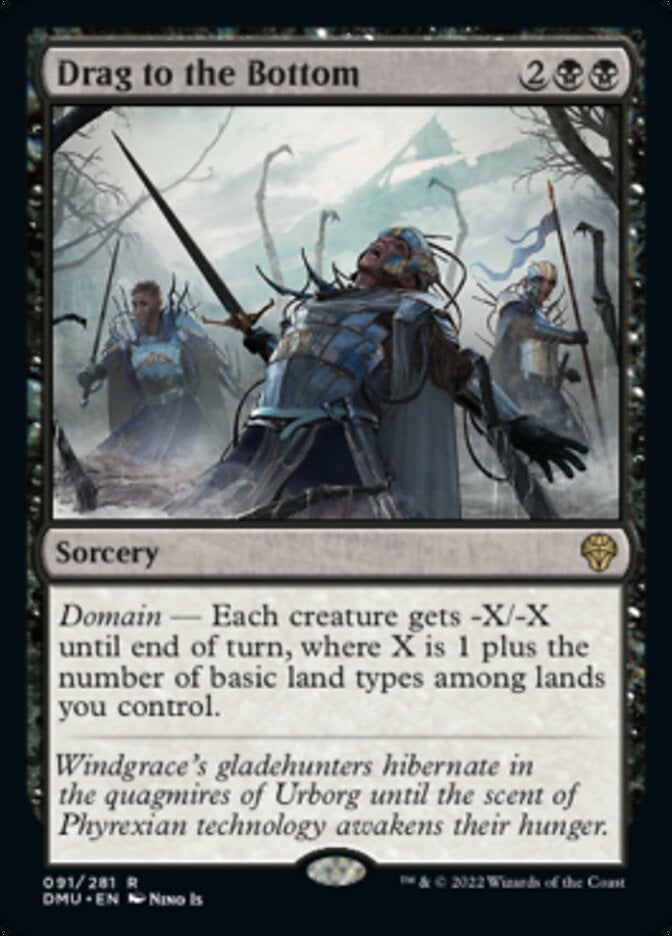
Rating: 7/10
-3/-3 is the use case for Drag to the Bottom, which isn’t all that great, but it should clear up most mid-game creatures. And taking this up to -4/-4 or higher makes it very powerful if you’re playing a domain-heavy deck.
I’d just look at this as a good black board sweeper that incentivizes you to splash a color or two to help you kill bigger creatures.
Eerie Soultender
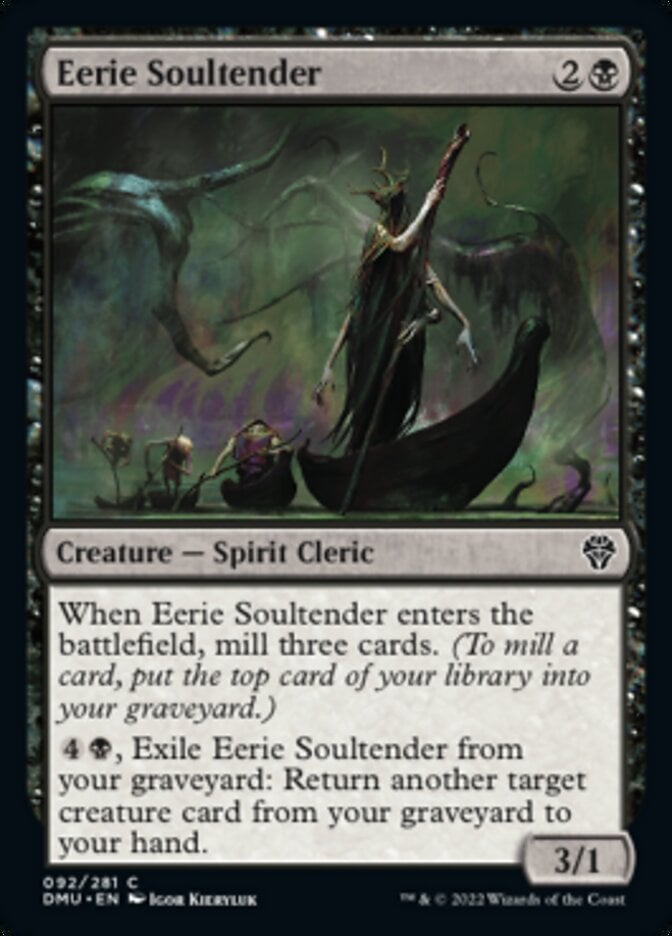
Rating: 4/10
There aren’t a lot of self-mill incentives in this set, so it’s a little weird to see Eerie Soultender both enable self-mill and pay you off for it. A creature that can be played, traded off, and then provides some free value, later on, is a card I’m very interested in, regardless of how much my deck wants to interact with the graveyard.
Evolved Sleeper
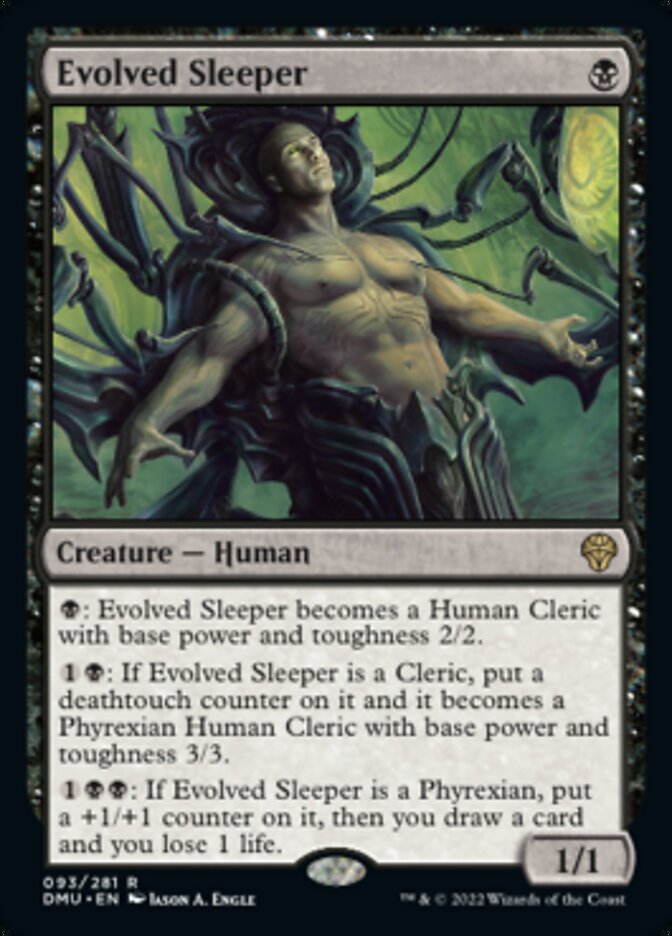
Rating: 9/10
This latest evolution, pun intended, on the Figure of Destiny design, is possibly the best we’ve seen yet. You can turn Evolved Sleeper into a 3/3 deathtouch for only four mana, and then you can keep paying three mana to draw cards and grow the sleeper even further.
While paying mana to draw cards has gotten worse in recent Limited sets, those creatures, like Triskaidekaphile, weren’t big enough to also be threats on the board. And if this goes undisturbed it will probably go on to win the game too.
Extinguish the Light
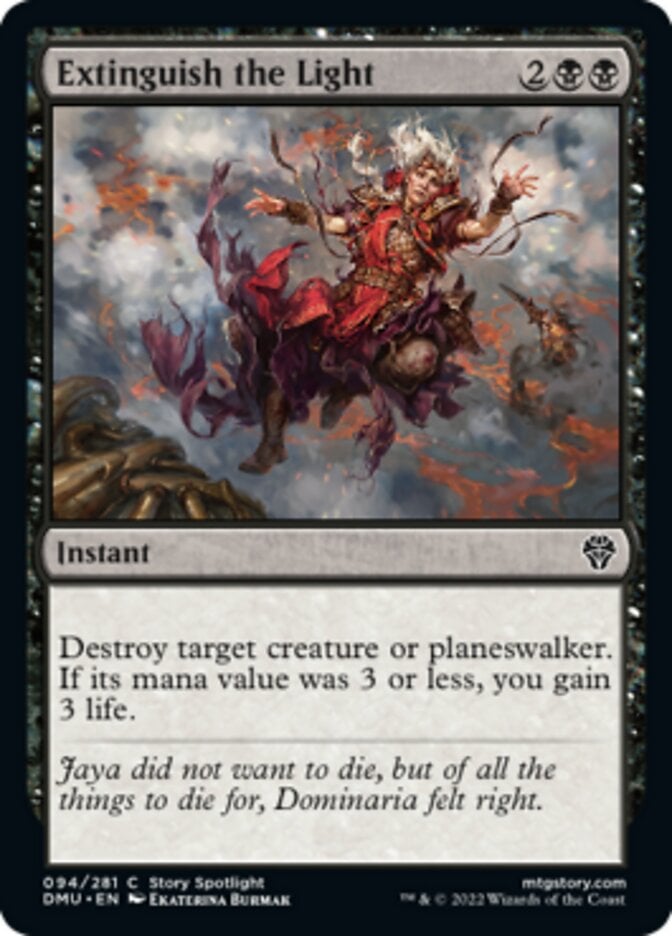
Rating: 6/10
RIP Jaya, you shall be sorely missed. Naturally, her demise had to be turned into the set’s common removal spell. And just like all similar cards in previous sets, Extinguish the Light ought to be one of the best cards in Dominaria United, if not the best, black common.
Even better, it normally feels bad if you spend four mana to kill something that costs less than four. But if you’re forced to do so then the life you gain from this spell should help to at least make up for the loss in tempo.
Gibbering Barricade

Rating: 4/10
Gibbering Barricade is a pretty hefty wall that usually takes some serious work on the part of the aggro deck to get past. While you generally prefer your sacrifice outlets to be cheap to activate, we’ve seen in previous sets that when the upside is getting to draw a card, you don’t mind paying a little more.
If Spark Reaper and Soulreaper of Mogis can be good while hardly ever attacking, then so can this.
Knight of Dusk’s Shadow
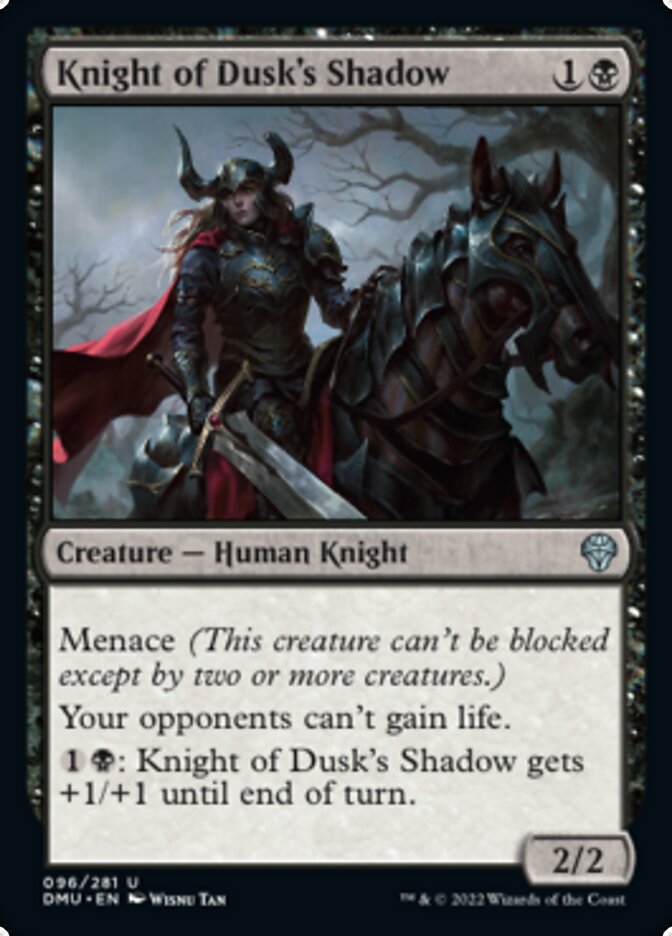
Rating: 6/10
Knight of Dusk's Shadow is going to be a monster if played on turn 2. A 2/2 menace is just too impractical to block early on and as I said with this card’s White Knight counterpart earlier, the threat of activation on its ability should be more than enough to deter your opponent from blocking it.
Menace is a much worse ability than first strike on this card so its power level is a bit limited, but it should be an absolute house no matter what.
Liliana of the Veil

Rating: 7/10
If you’ve followed any level of competitive Magic for at least a few years, you’re bound to be familiar with WotC’s most powerful Liliana card ever. But you may not be familiar with how it plays out in Limited. The answer is that Liliana of the Veil isn’t the powerhouse that you know from its days in Constructed, but it’s still very reasonable.
Very similar to a Gatekeeper of Malakir, what you want to do with this Liliana is immediately use its -2 to Edict a creature. After that its +1 is very safe to use if you have a spare land card, then all of a sudden you have access to another -2.
Continually using this planeswalker’s +1 is sometimes going to be a very bad prospect for you, so I’d say you want to aim to at least use it once to get two Edict effects out of it, and that’s not very hard to accomplish. If you can manage that, Liliana’s power will speak for itself.
Monstrous War-Leech

Rating: 2/10 without kicker, 4/10 with kicker
Vanilla creatures really need to be something special to be worth playing, but I’m not that happy with a creature that has a good chance of being much smaller than what you want out of a 4-drop. Even when you kick Monstrous War-Leech you’ve invested five mana total in a vanilla creature that’s realistically only going to be a 6/6 at best, but could be a 0/0 at worst.
The value of this does go up if you have a deck that wants to mill itself, but I don’t think we’ll be seeing it much outside of that.
Phyrexian Rager
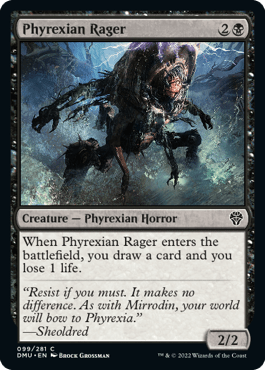
Rating: 6/10
I thought that my wish of getting Phyrexian Rager back in this set was a mere fantasy, but I suppose given the ridiculous mistake of Inspiring Overseer in the last set, we can be permitted a similar card in another color.
Phyrexian Rager is an excellent card in all decks. The life loss is very much worth it to draw a free card. On top of just being a good card, it can also be flickered and is great to return from the graveyard. It’s just an extremely flexible card with a lot of applications.
Phyrexian Vivisector

Rating: 4/10
I’m pretty much always going to be happy with a 2-drop 2/2 that has a nice upside. One that pays me off for doing what black was already looking to do like Phyrexian Vivisector is even better.
Phyrexian Warhorse
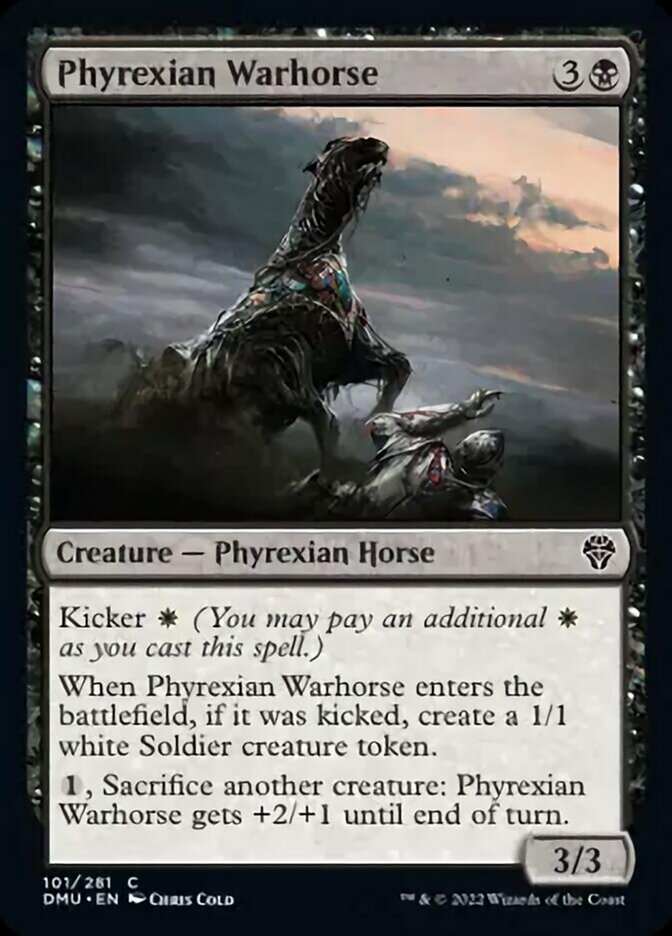
Rating: 4/10 without kicker, 5/10 with kicker
I’ve mentioned it a few times already, but the threat of activation is the key to why Phyrexian Warhorse is so powerful. With three other creatures in play and three open mana, you can attack with this and your opponent can’t exactly block with a 5/5 unless they’re happy for you to sacrifice your throwaway creatures and win the fight.
The fact that you can sometimes kick this and get a free 1/1 token to sacrifice is also pretty good. While this is no Nantuko Husk, it should be just as annoying to play against and a good enabler for a sacrifice deck.
Pilfer
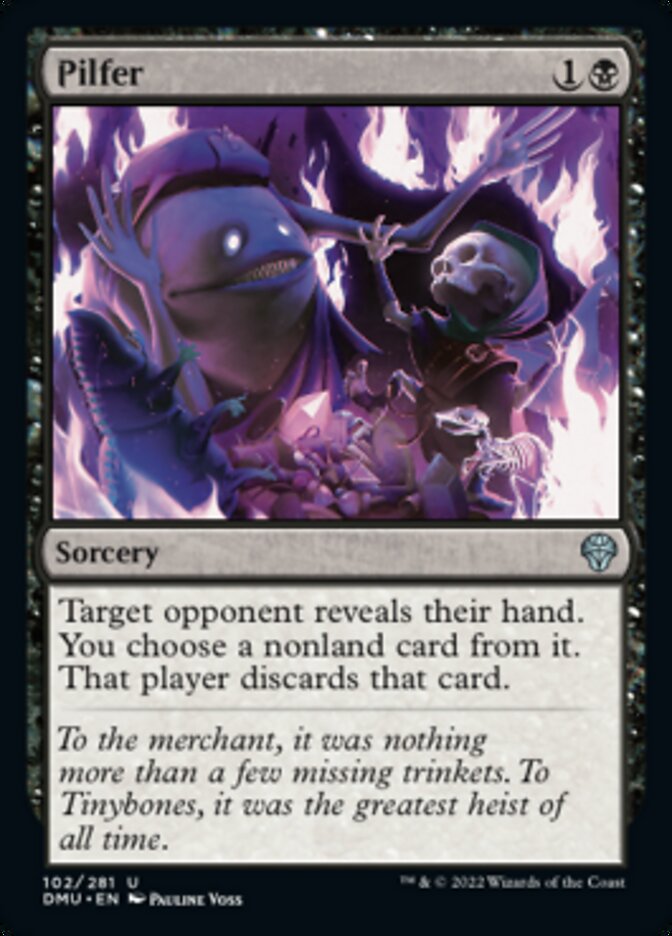
Rating: 4/10
Two mana is a nice sweet spot for Coercion effects, and since Pilfer grabs any nonland card with no restrictions or downsides, this seems good enough. It’ll be better as a sideboard card, but starting one in your main is probably fine.
The Raven Man
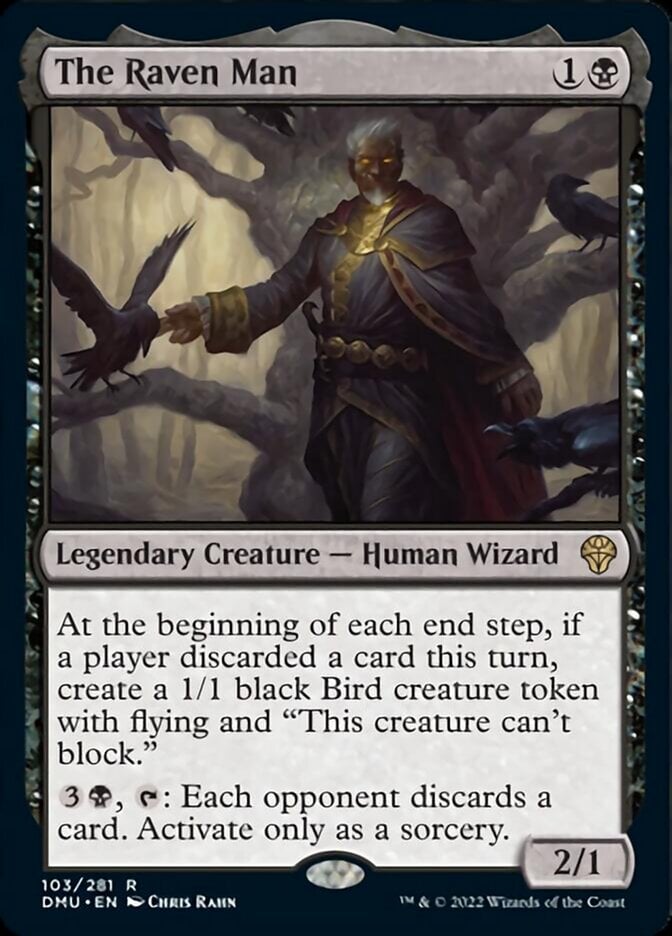
Rating: 6/10
One of Magic’s newest antagonists really does some work here. It’s not too difficult to get a few discard effects into your deck to trigger The Raven Man’s ability, especially since it triggers off you discarding your own cards. The activated ability can get silly when a game goes long.
What’s weird is that tokens that can’t block aren’t all that good in a control deck, but the activated ability isn’t wanted in an aggro deck. So where does this go? I think you’ll be happy with this wherever you put it, but this weird discrepancy between its effects might prove to reduce its playability.
Sengir Connoisseur

Rating: 7/10
Creatures don’t tend to die quite as often as you might expect, but you can have some control over that. You can sacrifice your own creatures, and of course, it triggers when you use most removal spells.
Overall, Sengir Connoisseur looks very strong. Starting out as a 3/3 with flying is a little bit under the rate you expect for a 5-drop, but this should be able to quickly grow to a 4/4 or a 5/5 which is very much above the rate. Every now and again it even gets bigger than that and then it starts to take over games.
Shadow Prophecy
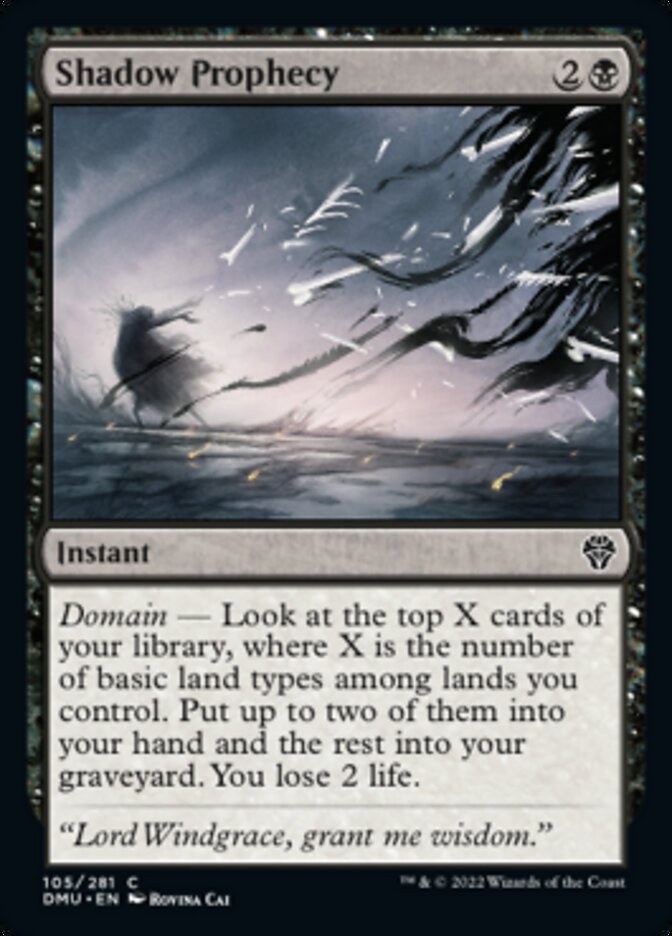
Rating: 5/10
Shadow Prophecy should always be at least a 3-mana draw two, which I’m already happy with. Hell, I’m happy with it costing four mana. The fact that it scales up with each extra land type you have beyond the first two makes this a ridiculously powerful draw spell.
At four land types, you’re casting the first half of Memory Deluge for just three mana. It also fuels your graveyard, which is generally a plus. I like everything about this card and have high expectations for it.
Shadow-Rite Priest
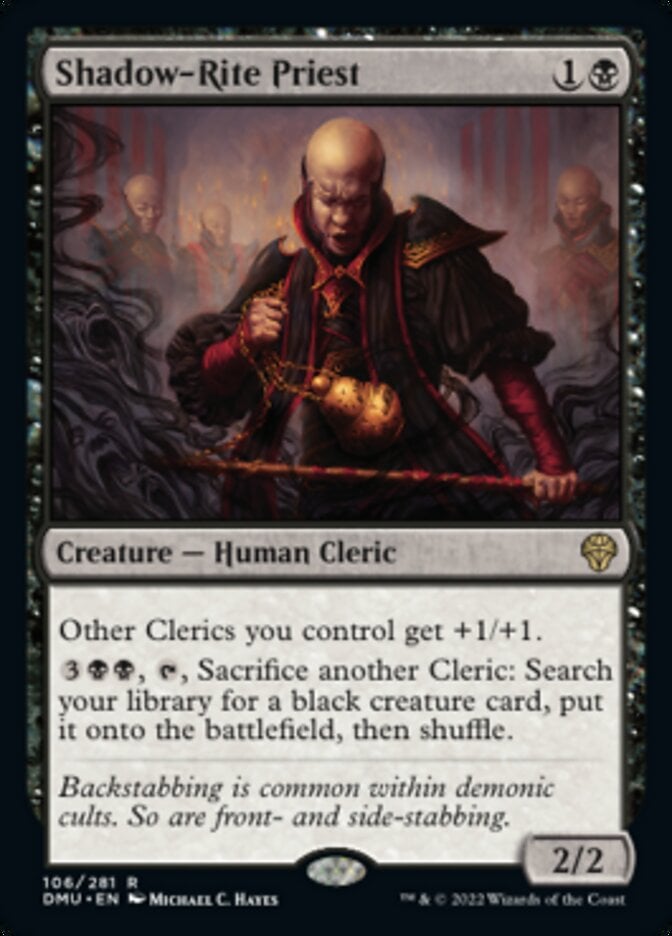
Rating: 3/10
There’s only one other cleric in black and a few in white, which makes me wonder why Shadow-Rite Priest is the black lord of choice. At the end of the day this isn’t completely terrible even if it’s just a black Forest Bear, and every now and again you can make use of its abilities. But I’m not impressed.
Sheoldred, the Apocalypse

Rating: 9/10
Sheoldred, the Apocalypse is back. While its mana cost has almost halved since we last saw it in New Phyrexia, it’s no less annoying.
Sheoldred’s base stats are absolutely fine for a 4-drop and are big enough that landing it on turn 4 will be extremely hard for an opponent to deal with. The keys to her are of course its triggered abilities, mainly the one that hits the opponent for two whenever they draw a card.
That’s a ticking time bomb that demands an immediate answer or you die. And if you think it’s fine and you’ll be able to just race it, well it also gains her controller at least two life every turn, which is just absurd.
Sheoldred may only cost four mana but it’s likely to dominate most boards if played early enough. And it provides a sense of late game inevitability that few other cards can offer.
Sheoldred’s Restoration
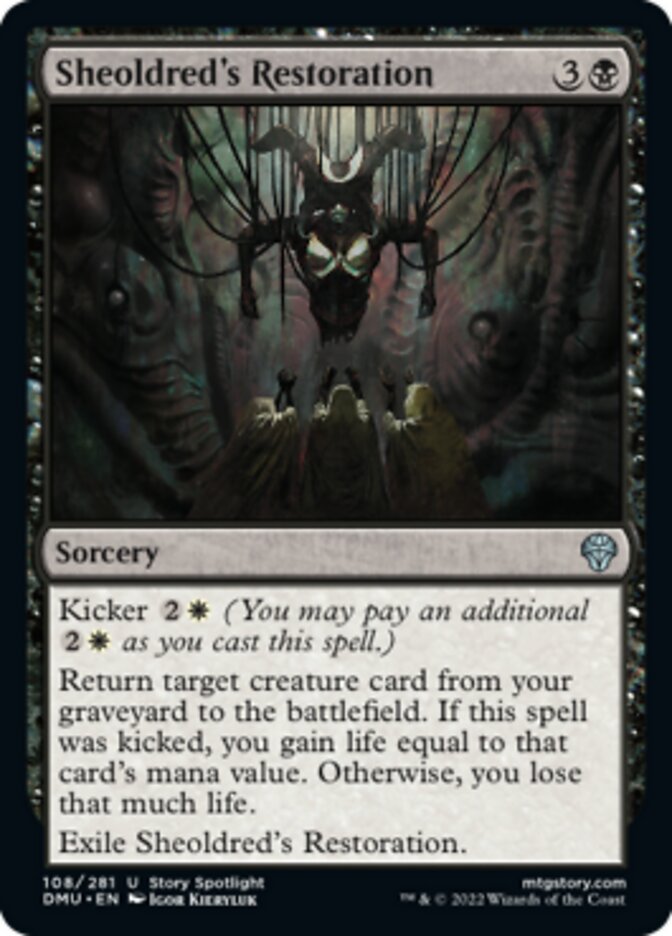
Rating: 1/10 without kicker, 1/10 with kicker
What I don’t understand is why you have to lose so much life. Reanimate obviously has to make us lose life because it costs one mana, but what advantage are you actually getting in exchange for losing what’s likely to be about four or five life to get a good creature back?
Even if you can kick Sheoldred's Restoration, seven mana for a reanimation spell is far too much. I just think this card is terrible.
Splatter Goblin
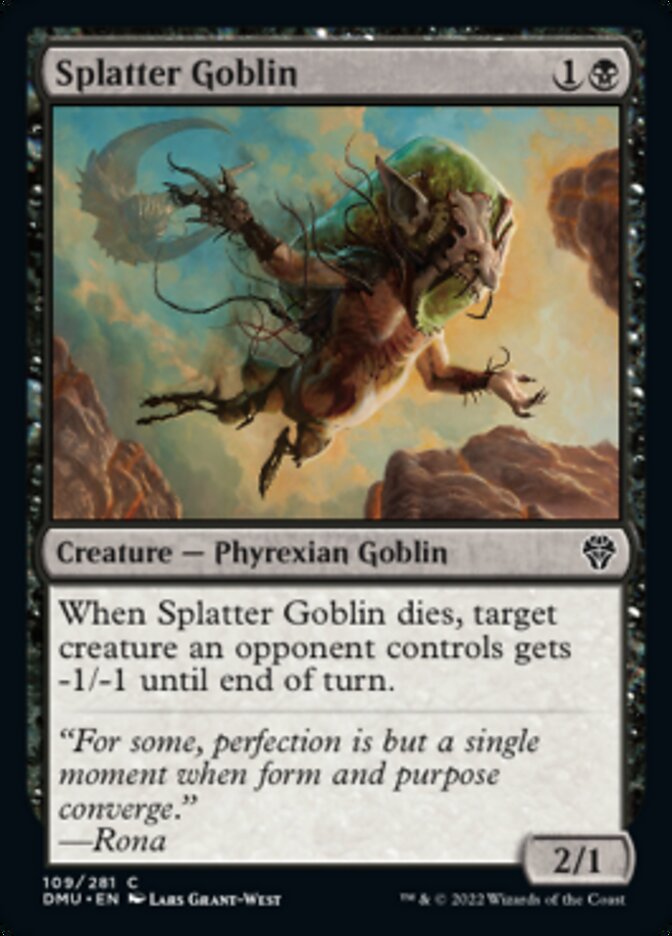
Rating: 4/10
Decks always need 2-drops these days, and one that can trade up and kill threes and fours like Splatter Goblin is high on my list of good creatures.
Stronghold Arena

Rating: 5/10 without kicker, 6/10 with kicker
We’ve seen some good versions of this kind of effect recently with cards like Furious Rise being very effective at providing card advantage to aggro decks. Stronghold Arena is probably the first one we’ve seen with basically no restrictions on it, which is what exchange you make for needing to lose life.
But as anyone who’s played enough with Dark Confidant will point out to you, you tend to hit lands quite often. So the life loss isn’t as painful as you might think. I think this will play out well and while you definitely don’t need the kicker costs to make it good, spotting you a bit of life upfront is definitely good enough to make use of it.
Tattered Apparition
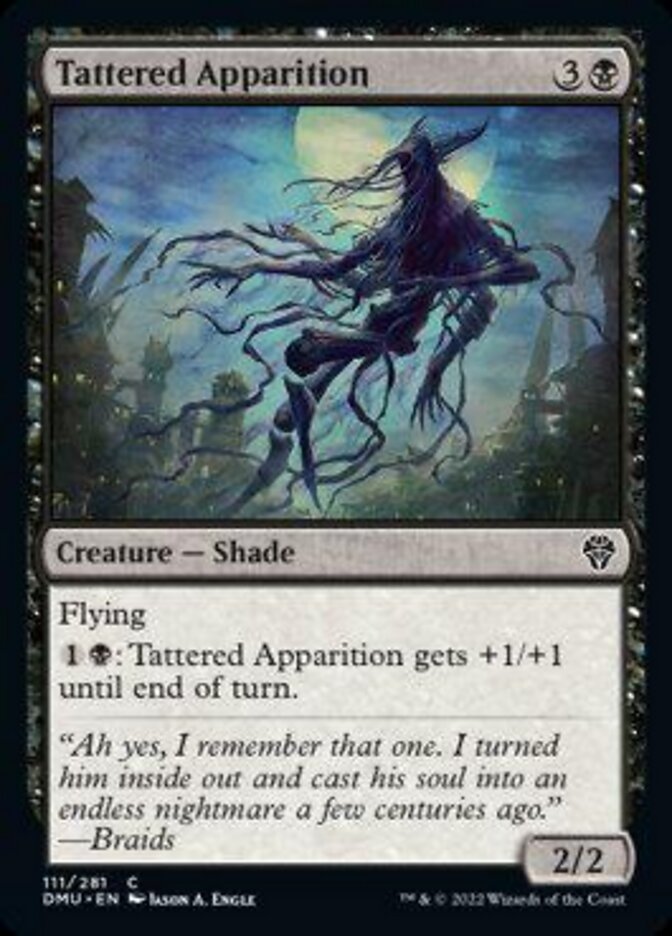
Rating: 3/10
Shades used to perform really well depending on how cheap their abilities were. While Tattered Apparition is fairly inexpensive, the 4-mana investment to only start on a 2/2 flier is a bit of a tough pill to swallow. But some slower decks will be fine playing this from time to time.
Toxic Abomination
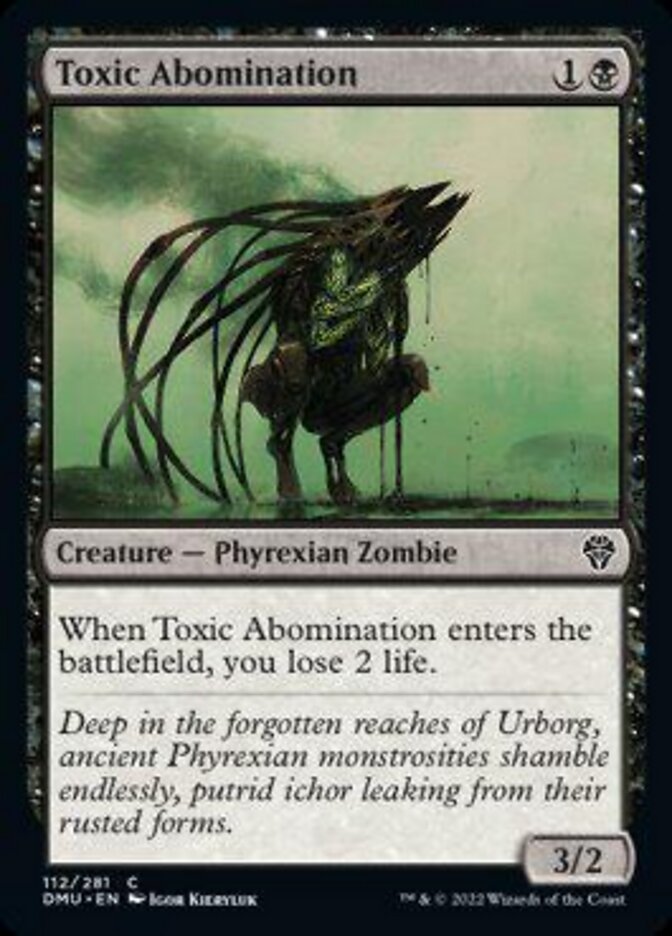
Rating: 3/10
Aggressive black decks should be pretty happy with Toxic Abomination, but losing two life on entering is a pretty steep cost that is often too much of a liability for slower decks to handle.
Like Crooked Custodian in the last set, I’d expect this to stay in those faster decks.
Tribute to Urborg
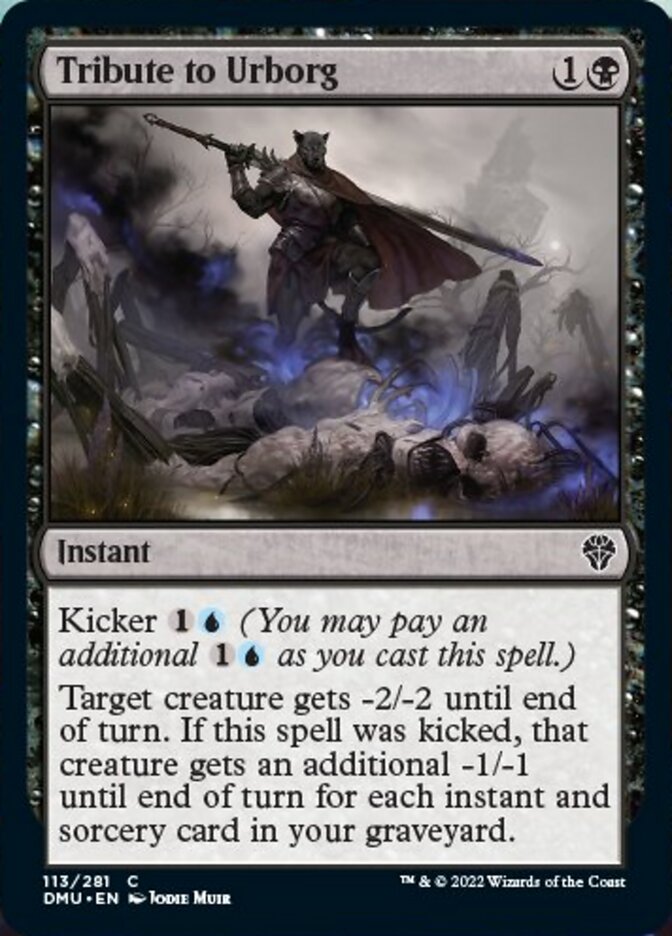
Rating: 4/10 without kicker, 6/10 with kicker
A -2/-2 trick should be more than enough to kill a lot of small creatures and kill bigger ones in combat. Add in the kicker cost that should be able to scale up the spell enough to kill anything and you have a very flexible removal spell in Tribute to Urborg.
The blue kicker should work as a treat as long as you have plenty of spells in your deck, and most creatures should be in range of it.
Urborg Repossession
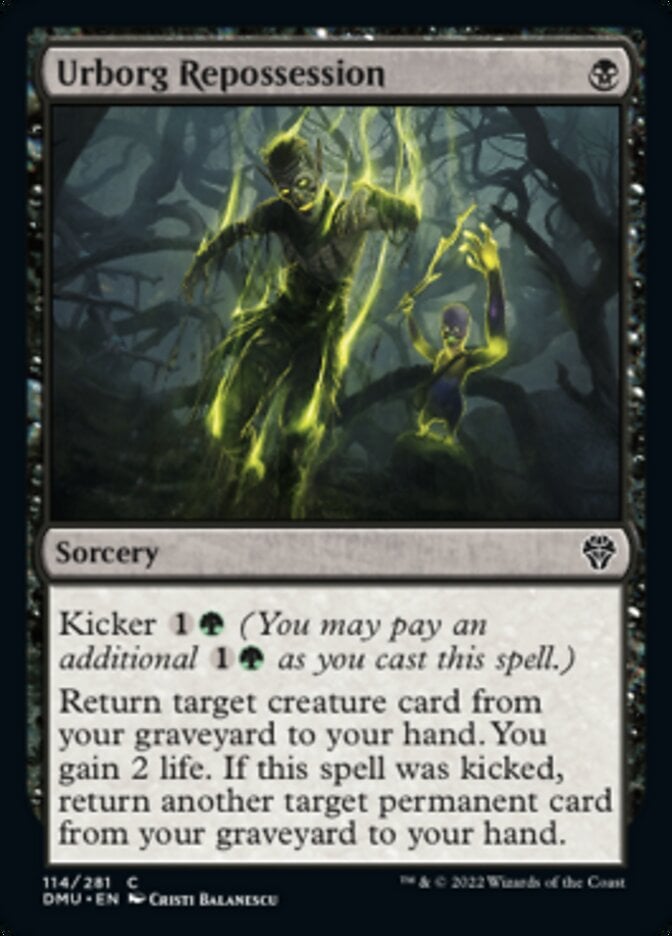
Rating: 4/10 without kicker, 5/10 with kicker
Raise Dead effects are decent, especially as Urborg Repossession gains you some extra life to boot. Much like Blood Beckoning from Zendikar Rising, being able to kick this to get back two cards adds a ton of flexibility that makes this an attractive prospect for most decks.
Writhing Necromass
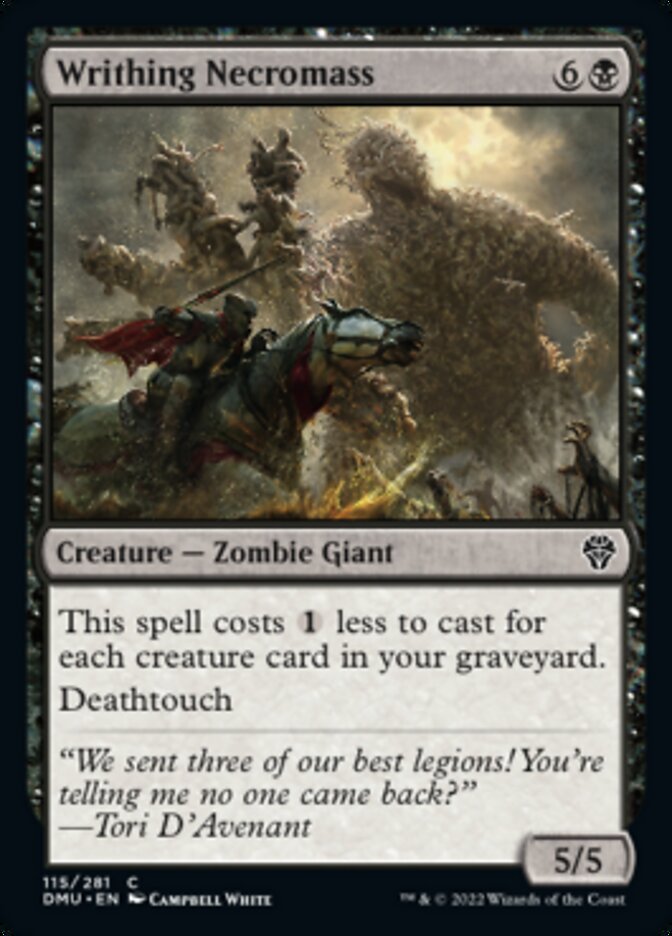
Rating: 4/10
There are a few ways to self-mill in the set but not a lot of payoffs. While Writhing Necromass is one, I doubt you’re going to get this down to less than three or four mana most of the time. At that point it is good, but it’s just a big vanilla creature since deathtouch is one of the most useless abilities that a big creature can have.
Red
Balduvian Berserker
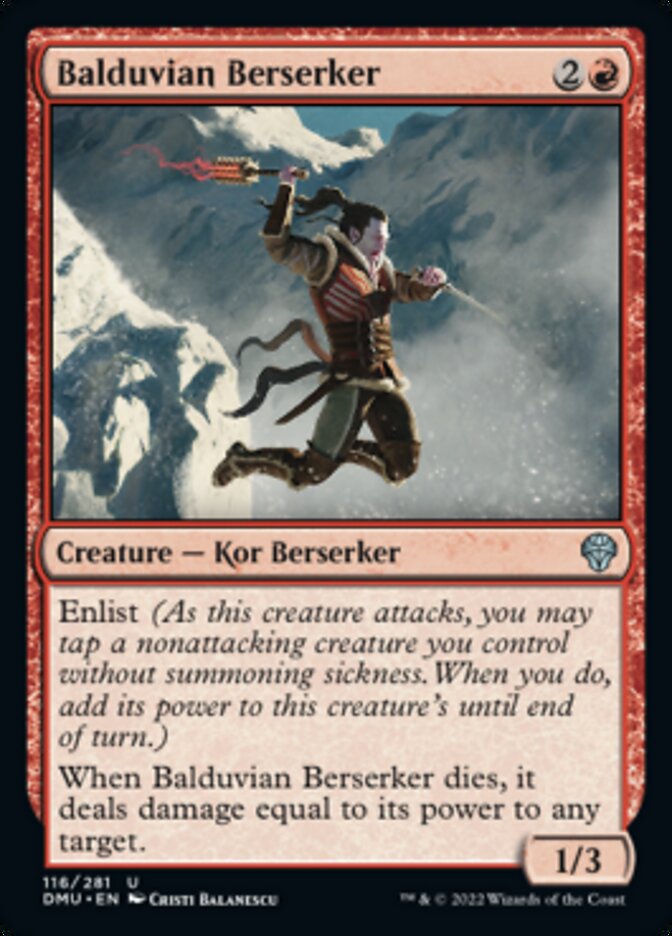
Rating: 7/10
Creatures with this ability to deal damage when they die usually only deal one damage or is extremely hard to increase the power to do more. You rarely see a version that has a built-in way to increase its own power, making Balduvian Berserker a really potent attacker.
If you attack with this as a 3/3 or a 4/3, is your opponent really going to trade off and lose an additional creature? If they do, I’d say you’re pretty happy with your easy two-for-one.
Chaotic Transformation

Rating: 0/10
Just, no. Chaotic Transformation is designed for Commander and does next to nothing for us in Limited. Let’s just move on.
Coalition Warbrute
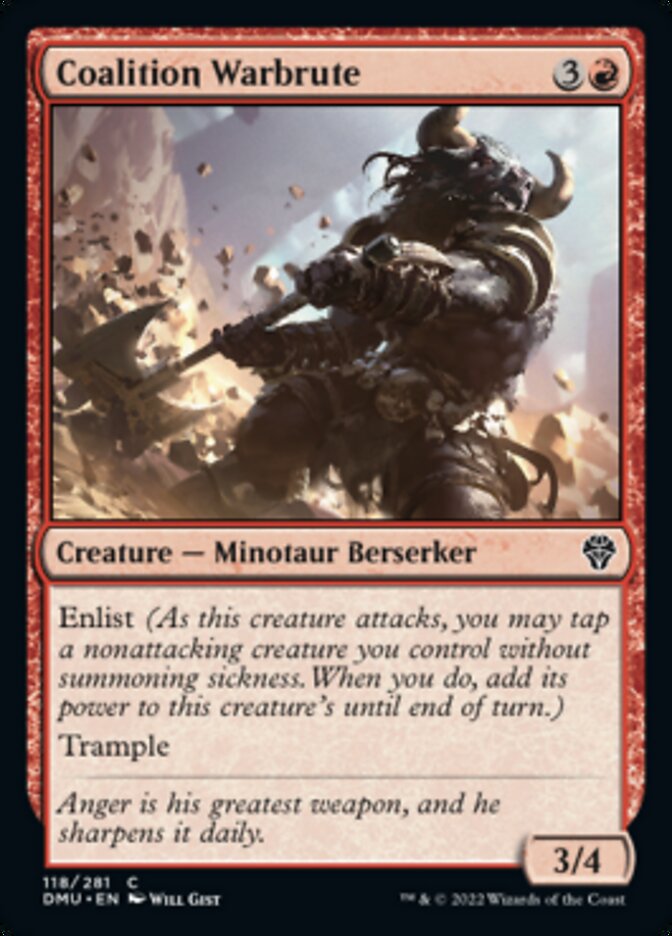
Rating: 5/10
Coalition Warbrute is an incredibly big creature almost on its own. If you enable enlist then it’s often going to come in swinging as a 5/4 or 6/4 trample, and for four mana you’ve piqued my interest.
Defiler of Instinct

Rating: 8/10
Another 4-mana Defiler and the cast trigger is something you’re very interested in unlike with its black counterpart. Killing off small creatures or finishing off bigger ones post-combat is a very potent ability, and a huge first strike creature is really difficult to get into combat with too.
The whole package is here on Defiler of Instinct, and I expect it to be one of the better ones in the cycle.
Dragon Whelp
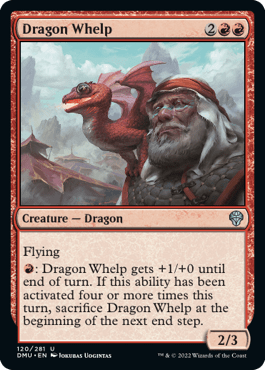
Rating: 6/10
Ah, another great returning classic. Dragon Whelp is a card from all the way back in Alpha that we last saw in Core Set 2010. This dragon plays out incredibly well and while you can’t use its firebreathing ability too many times in one turn, that isn’t likely to matter too much since a 5/3 flier is still a great deal.
Not to mention that you can always dump a load of mana in for one final swing, and having that potential makes for a good card overall.
The Elder Dragon War
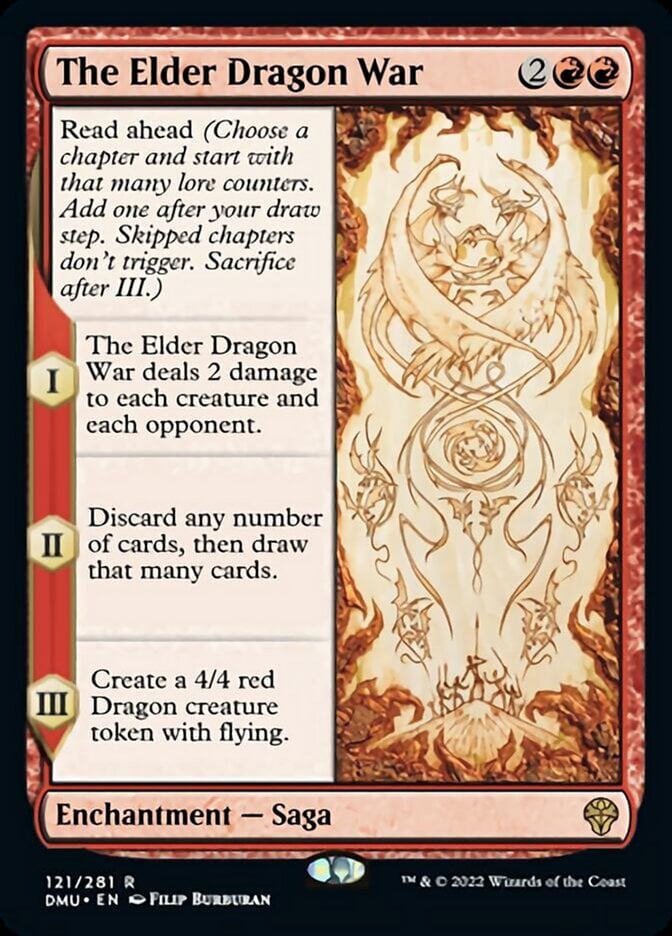
Rating: 9/10
I love the flexibility that read ahead gives sagas, and The Elder Dragon War is a perfect example of that. If you look at chapter three as being the absolute worst this card will ever be, it’s four mana for a 4/4 flying dragon. That’s already very good, you don’t even have to bother with the first two chapters.
But sometimes you can play this on turn 4 and kill a couple of small creatures, then you also get your 4/4 at the end. Sometimes you’ll top deck it later when you have some useless lands to throw away (knowing this is in your deck is definitely an incentive to hold onto some excess lands too), in which case this draws you a bunch of new cards and still gives you a 4/4.
Oh, this can also just kill your opponent when they’re on two life. Excellent card with a ton of play options to it, very much worthy of bomb rare status.
Electrostatic Infantry
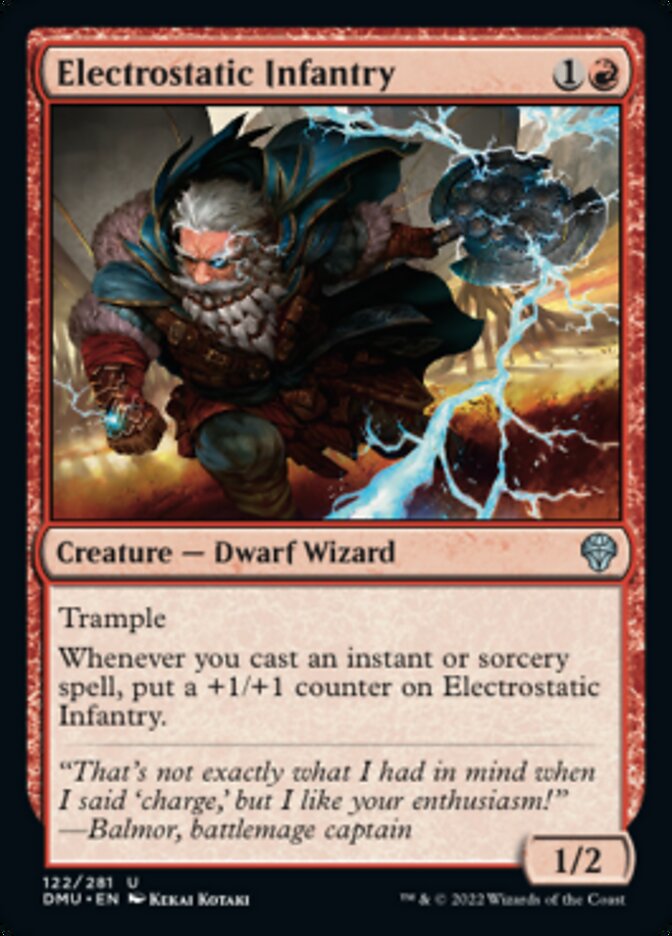
Rating: 4/10
Electrostatic Infantry is a decent payoff in a deck centered around instants and sorceries, but one that starts out as far too weak to be an attractive prospect anywhere else. If you’re doing the thing then you clearly want payoffs and you can’t go too wrong with this.
Fires of Victory

Rating: 6/10 without kicker, 7/10 with kicker
The power of Fires of Victory scales down the later the game goes on. You’re far less likely to have a lot of cards in hand the later the game goes on, but the ability to kill virtually any creature in the early turns of the game makes this an appealing removal spell.
Being able to kick it turns it into a pseudo-Annihilate and the card draw helps the card keep its damage output high in later turns. All-in-all, a nice little package.
Flowstone Infusion

Rating: 5/10
Flowstone Infusion is a really nice variation on Shock that harkens back to the Flowstone cards from Dominaria sets of the past that always gave +X/-X boosts. Most of the time this is just used as removal, but you do have the option of using it as a combat trick of sorts too, giving it a little bit of extra flexibility. That’s always a good thing.
Flowstone Kavu
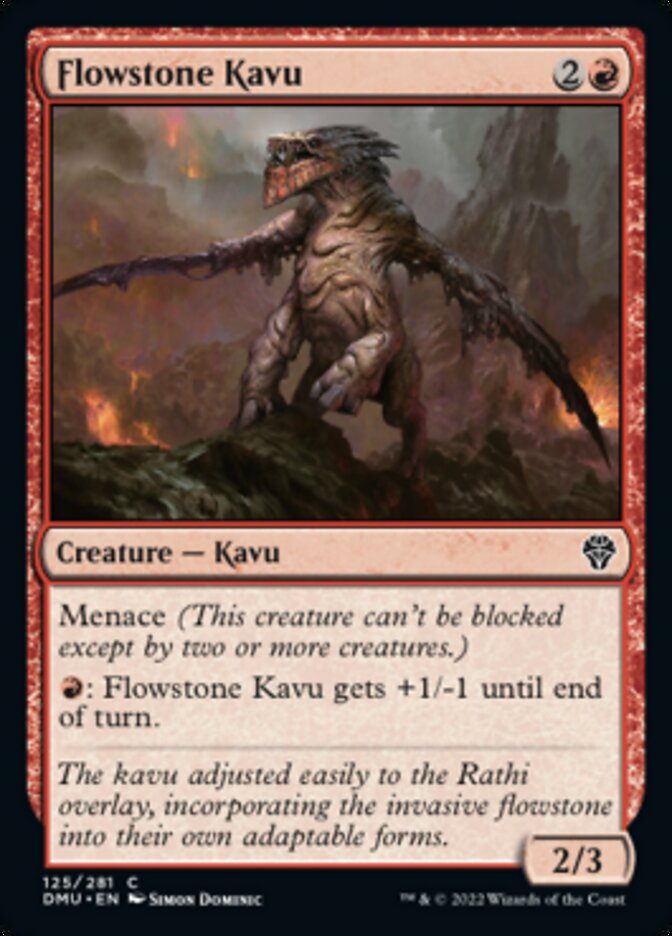
Rating: 4/10
The fact that Flowstone Kavu warrants a double block before the opponent knows how big it makes it a really annoying creature to deal with. It’s also a cheap four power creature for enlist abilities, which I think adds up to a decent little package.
Furious Bellow
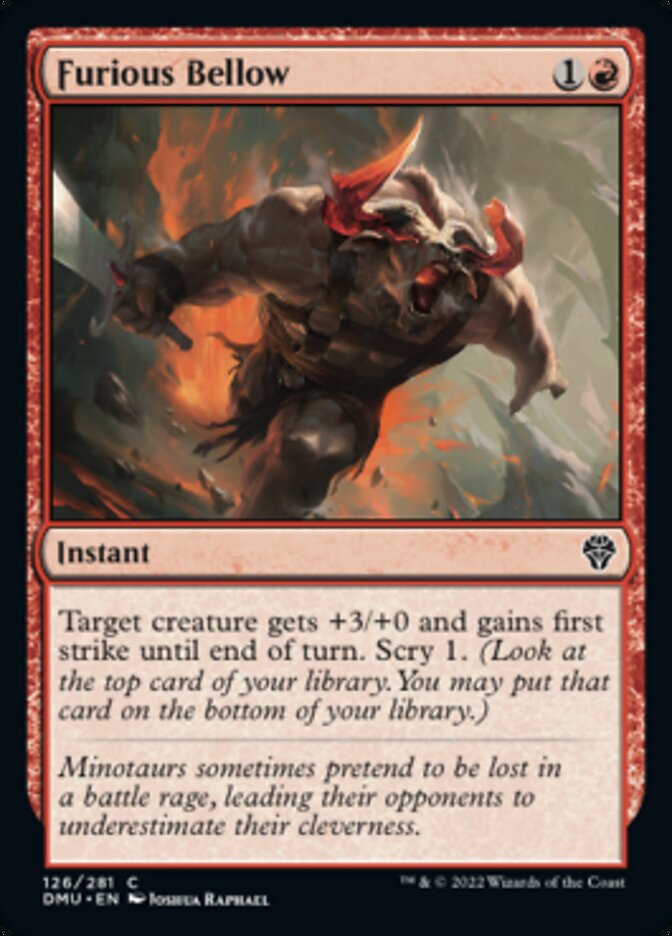
Rating: 4/10
I’m not sure that Sure Strike needed a strict upgrade, but hey, we have it now. Furious Bellow is one of the better red combat tricks that you get a lot and it should be just as good in this set.
Ghitu Amplifier
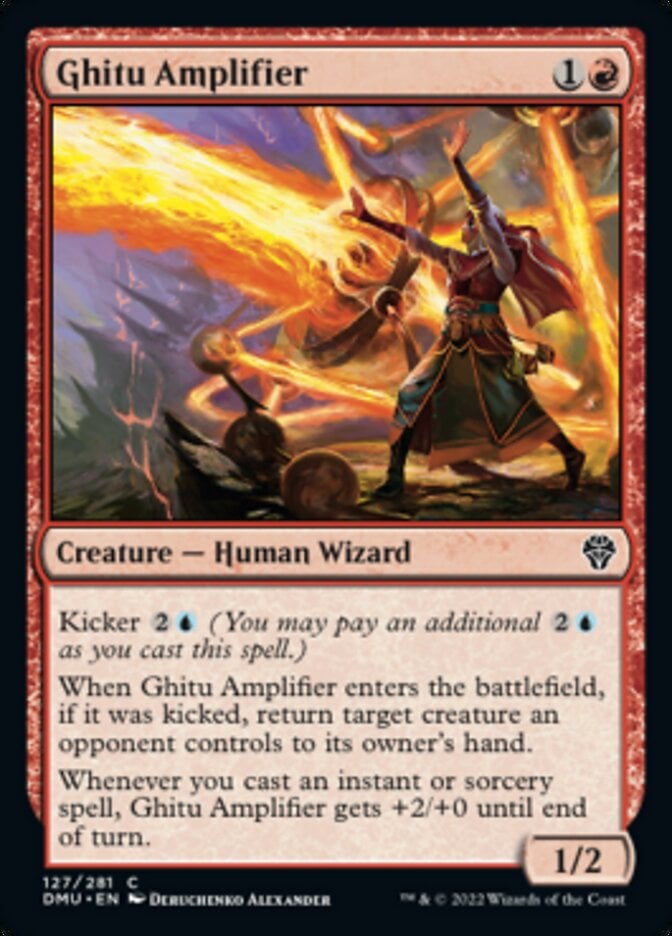
Rating: 2/10 without kicker, 5/10 with kicker
Ghitu Amplifier on its own is very mediocre. Wee Dragonauts is really only good because it flies, so the fact that it can barely even attack without a spell being cast isn’t particularly good.
But add in the kicker and you’re looking at what is probably a solid creature, kind of like an Ogre Savant. I’d just want access to blue before I included it in my deck.
Goblin Picker
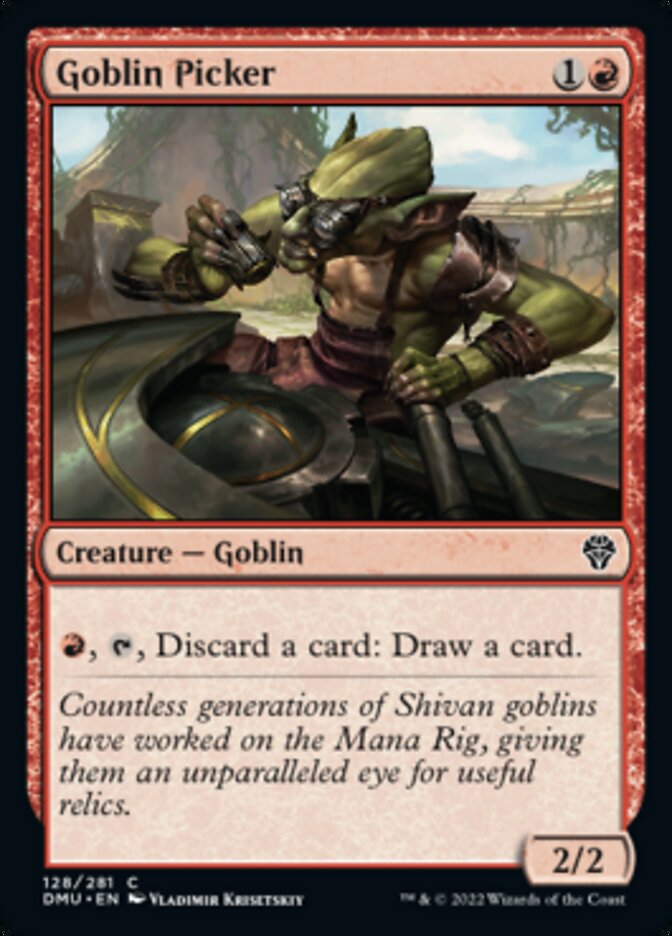
Rating: 5/10
Even if you have to pay mana for it, a Rummaging Goblin is pretty powerful. Especially if you also get it on a better-sized creature. Goblin Picker a 2-drop that’s good early and good late, so you don’t need much more than that.
Hammerhand

Rating: 5/10
I say this in a lot of my set reviews: auras suck. You really shouldn’t play them. Now, let me explain why Hammerhand is so good.
If an aura gives you some kind of immediate impact then it goes from being unplayable to really kind of good. Not only are you making a creature a little bigger, but stopping a creature blocking for a turn can really help you to make a huge swing. And not only with the creature you’re enchanting, but with everything. If you have a board of 2/2s and your opponent has a single 4/4 out, you’re not going to attack. But then Hammerhand drops in and lets you make a big attack.
When we first saw this in Core Set 2015 it was a game changer and even saw play in Standard. I’m expecting to lose quite a few games to this over the course of this format.
Hurler Cyclops
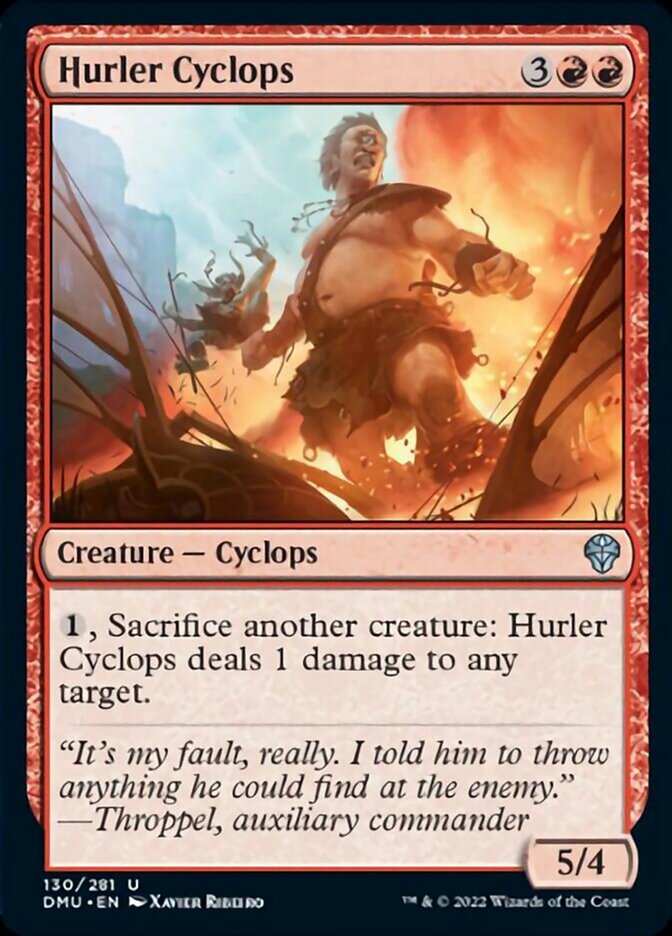
Rating: 5/10
Sacrifice outlets are usually cheaper than Hurler Cyclops, but at five mana this still packs a punch. Hitting for one damage is the sort of effect you’re usually looking to repeat over and over again, which is going to be exactly what you want in the right deck.
Costing one mana to activate is also spot on since costing any more than that would really limit the plays you could make with the card.
Hurloon Battle Hymn
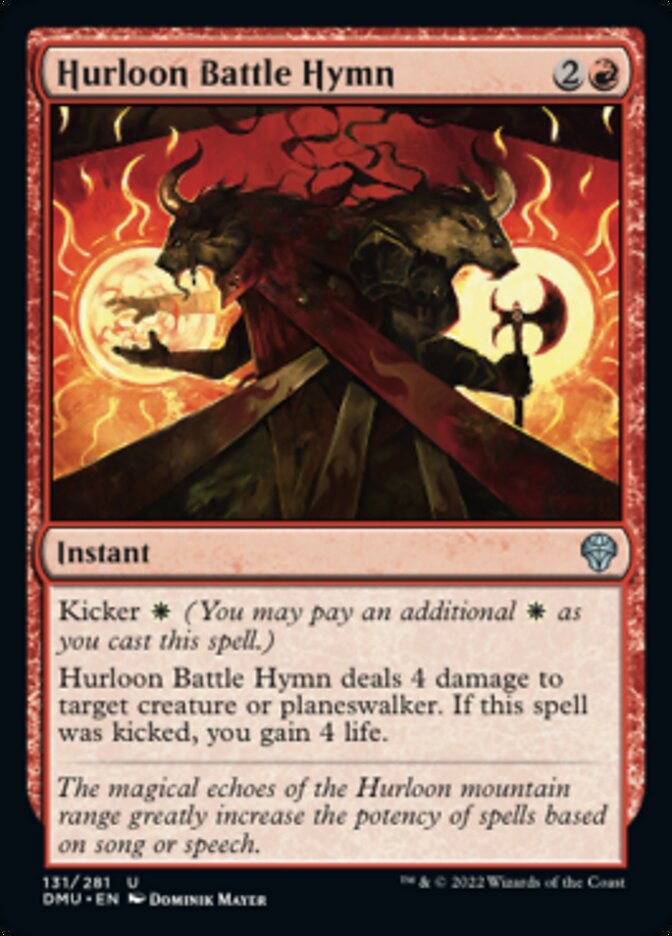
Rating: 6/10 without kicker, 7/10 with kicker
Gotta love a simple four damage for three mana. There’s not much else to say really.
Removal is good in Limited, and Hurloon Battle Hymn is a very good removal. Throw in the kicker and you basically have a Warleader's Helix, which is even better at stopping aggro decks from killing you.
In Thrall to the Pit
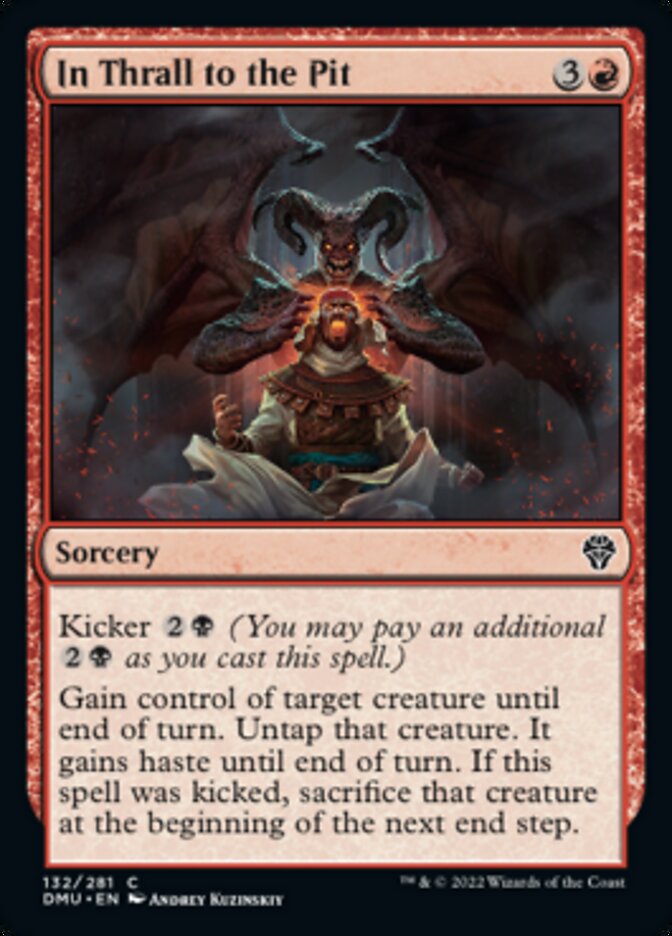
Rating: 4/10 without kicker, 6/10 with kicker
We see Threaten effects in basically every set these days and these effects tend to shine when a set has a pretty strong sacrifice theme like this one does. Add in a kicker mode where In Thrall to the Pit gets to turn into hard removal and you have a format staple on your hands.
Jaya, Fiery Negotiator
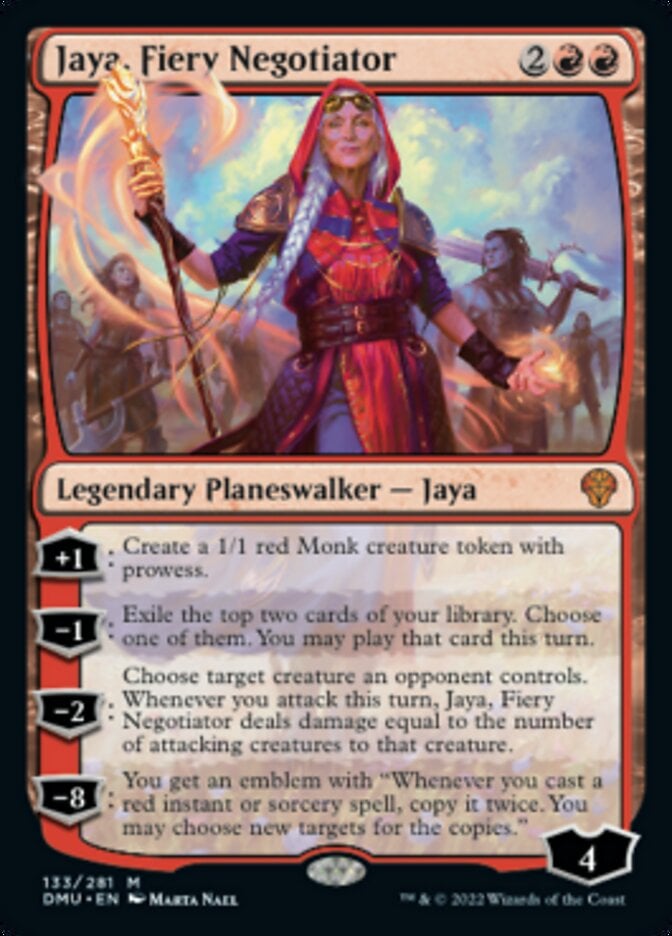
Rating: 10/10
It’s really hard for a 4-ability planeswalker to not be a straight-up 10 as long as the abilities aren’t embarrassingly awful (coughnew Karncough). Jaya, Fiery Negotiator does it all.
Its +1 creates a creature token to protect it, its -1 draws you a card, and its -2, while situational, still removes a creature from the board. It’s all the best kinds of planeswalker abilities on one card, and Jaya also only costs four mana.
Excellent. A+. 10/10. Let’s go to the next one.
Jaya’s Firenado
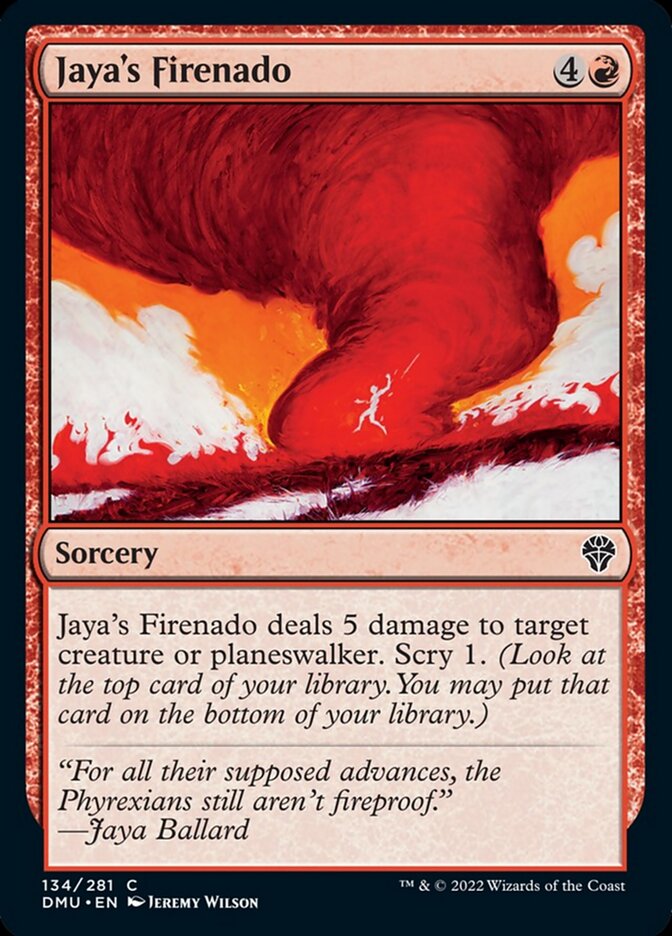
Rating: 4/10
These 5-drop burn spells tend to be okay, but not something you ever need to take highly. You’ll be happy with one Jaya's Firenado in your deck, but the second or third copies become too slow and clunky.
Red has plenty of other good options to remove creatures so make sure to pick up a variety of them.
Keldon Flamesage
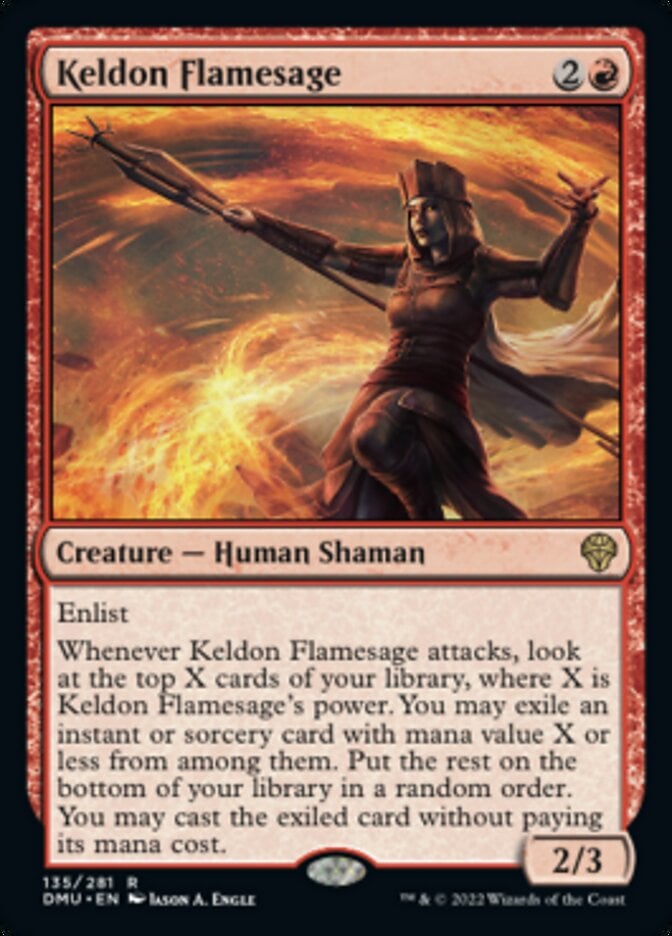
Rating: 6/10
The problem I can see with Keldon Flamesage is that you really want to use its enlist ability, which means you want to have more creatures in play. But then you want there to be a bunch of instants and sorceries in your deck to make it more likely that you hit something.
Those details all seem to be conflicting with each other and while I don’t think that makes the card bad, it’s something that may become a bit of an issue from time to time. Regardless, you’re off to the races if you hit just one card off it, drawing a card and getting a big mana discount on it.
Keldon Strike Team

Rating: 3/10 without kicker, 6/10 with kicker
Maybe I’m overvaluing Keldon Strike Team just a little bit, but I love cards like this that give you three whole creatures for the price of one. And giving them all haste will often be such a beating out of nowhere that I expect this to be a big common in the format.
While the basic mono-red card is kinda weak, I really want to be playing this in Boros where I can make full use of the kicker cost for when I make alpha strikes.
Lightning Strike
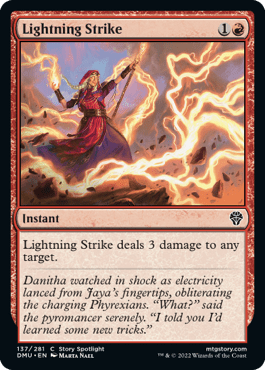
Rating: 7/10
Lightning Strike has always been great and will continue to be great. It’s back to common again, so we’ll be seeing it quite a bit.
Going to the face means this should always be relevant no matter what stage of the game you’re at. Either you can kill a creature or push for an alpha strike that can be completed with a quick bolt to the face. Burn spells are good, and this is one of the simplest ones around.
Meria’s Outrider
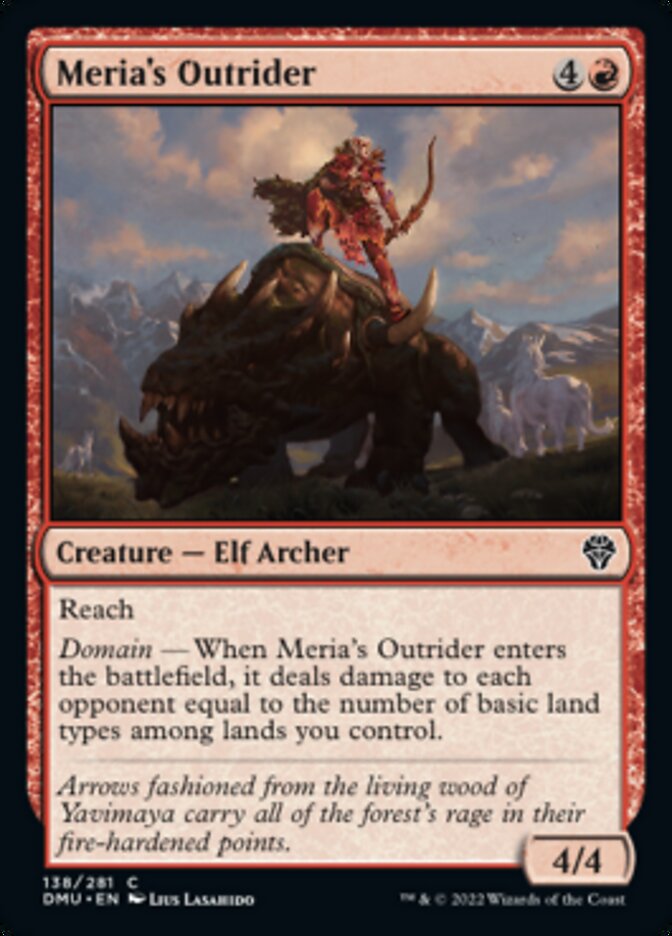
Rating: 2/10
Even with the ability getting you a nice shot of damage to the face, Meria's Outrider is just too underwhelming on raw stats to be worth it. If you’re a domain deck that can literally get five damage out of this every time then its value goes up, but your typical 2-color deck should probably stay clear.
Molten Monstrosity

Rating: 4/10
You only need a 3-power creature on the board for Molten Monstrosity to be a 5-mana 5/5 with trample, which is exactly the rate you’re looking for. Sometimes you might get it even cheaper, but this card is likely a very average creature when that balances out with the risk of it costing too much because you have no creatures out.
Phoenix Chick

Rating: 6/10
Getting Phoenix Chick on turn 1 is going to feel like one of the most unfair opening turns in the whole format. All of its abilities are telling you to be aggressive, so that’s exactly what you should be doing.
You shouldn’t play this at all if your deck is slow and controlling, but this ought to be incredible in any deck capable of attacking strongly.
Radha’s Firebrand
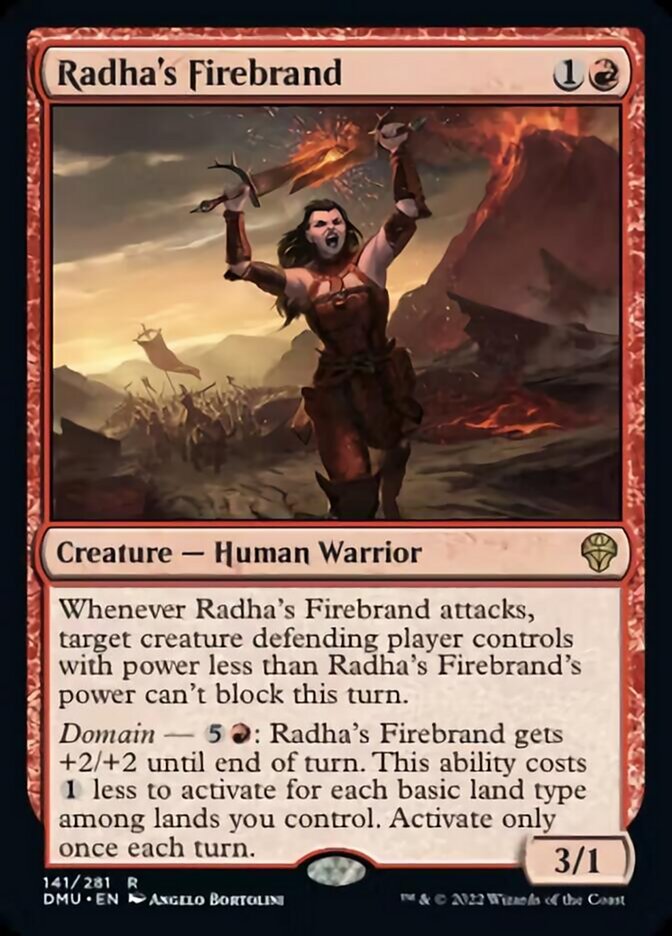
Rating: 7/10
Earthshaker Khenra was a powerful card back in the day and Radha's Firebrand feels very reminiscent. The activated ability often costs four mana, and turning this into a 5/3 works really nicely with its first ability too.
This is still a card that you only really want if you’re playing an aggressive deck, but when you do it's an excellent card that's really tough to deal with. Remember that a good option when playing this is to stop a smaller creature from blocking and force your opponent to trade off something more valuable.
Rundvelt Hordemaster
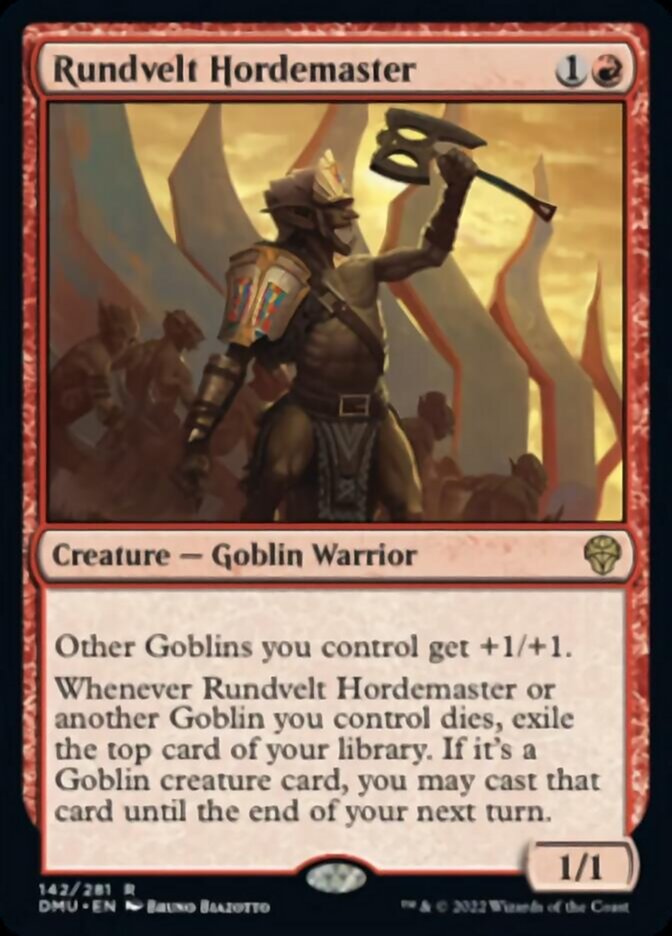
Rating: 1/10
While there are some other goblins in this set, this lord’s ability only really works when you have enough of them to have some on board and enough in your deck to find with the triggers. Sadly that’s not going to work out so well. And since Rundvelt Hordemaster doesn’t function too well on its own, it’s a no from me.
Shivan Devastator
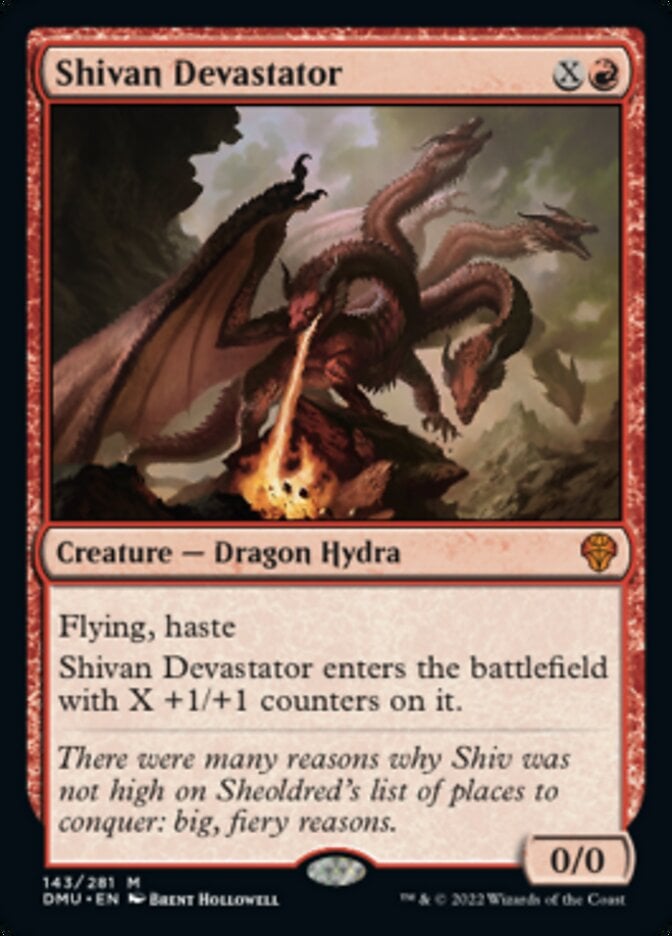
Rating: 9/10
Big haste fliers have a long history of being incredibly annoying and incredibly swingy, and now you have one that can be annoying at every point in the game. If you have to cast Shivan Devastator as your 4-drop on your curve, it’s pretty good at that.
If you’re late in the game, have a bunch of mana available, and you top deck this? Yeah, it’s really damn good then too. Oh, and it’s also splashable. Awesome.
I’m hesitant to give it a 10, but it could very well be one due to pure flexibility.
Smash to Dust
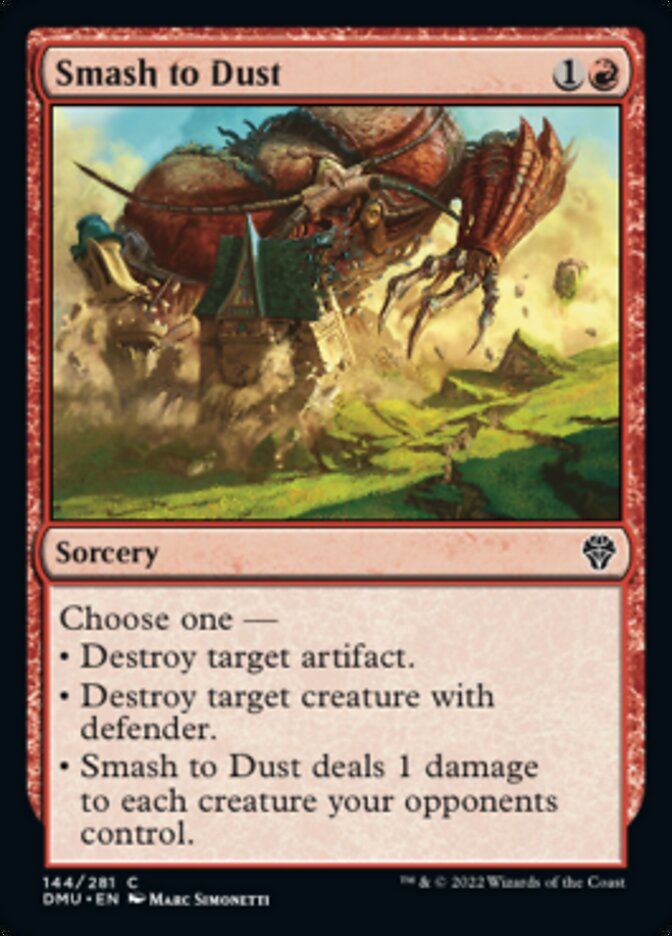
Rating: 2/10
Smash to Dust is a really sweet modal spell with three incredibly narrow but relevant modes to choose from. None of the modes are good enough for this to be a main deck card, but it’s without a doubt a good sideboard card that I’ll always want to pick up.
Sprouting Goblin
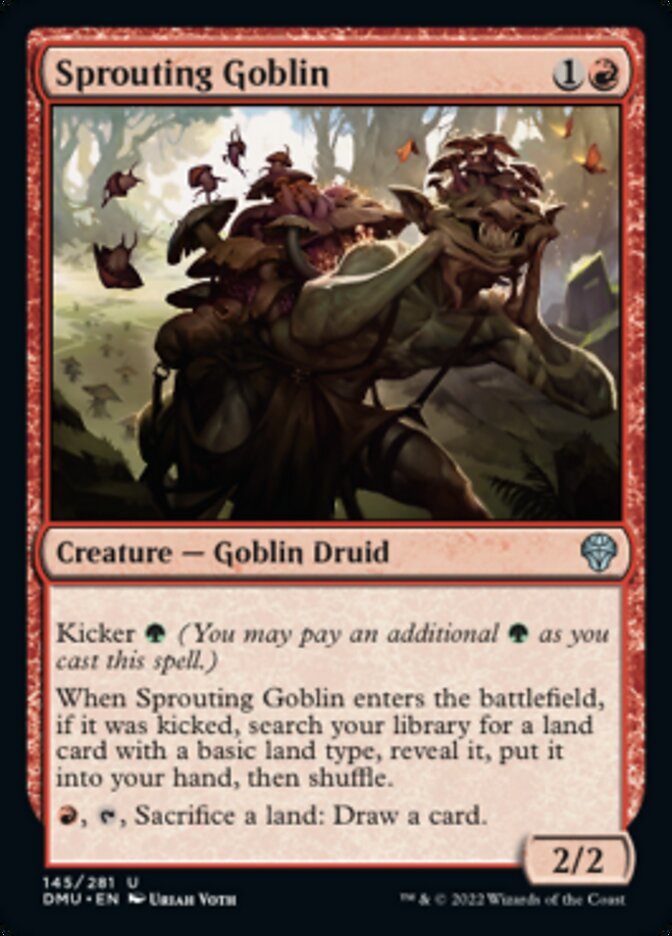
Rating: 4/10 without kicker, 5/10 with kicker
If you ignore the kicker cost, Sprouting Goblin is still a 2-mana 2/2 that has a very relevant late-game ability. You’re never unhappy to draw it. With the kicker you effectively have a multicolored Civic Wayfinder, which is a very good card, but one that’s worse if it needs to be multicolored.
If you’re splashing a third color or playing a domain deck then this card’s value goes way up. I just hope you’re heavy in red and green to make use of it.
Squee, Dubious Monarch
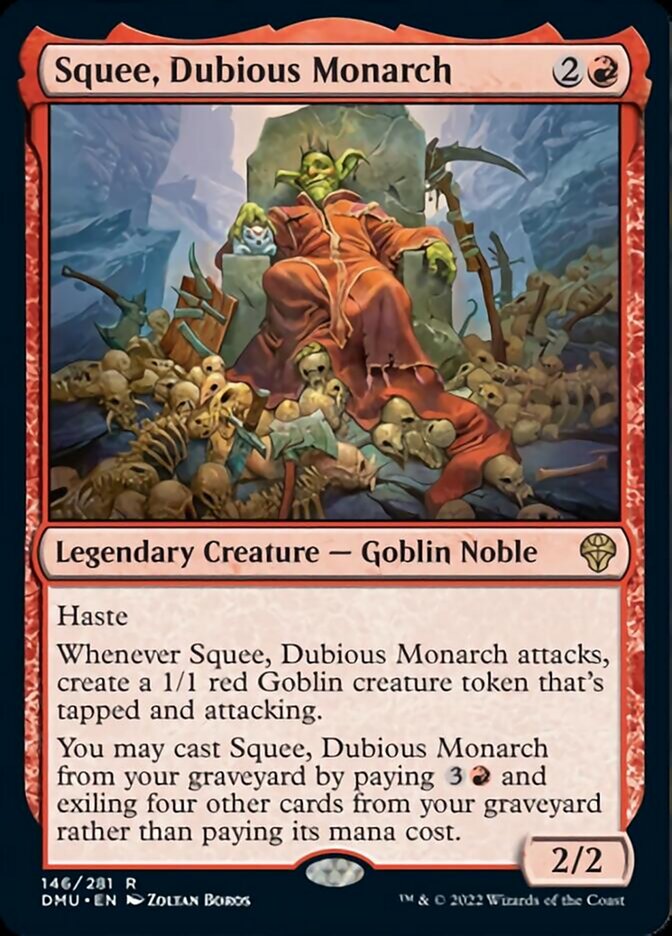
Rating: 8/10
2/2s aren’t necessarily that easy to attack with, but Squee, Dubious Monarch’s latest iteration really rewards you for doing so. As we saw in Theros: Beyond Death, the escape mechanic is absurdly powerful.
Getting your first escape card was always an important rule when drafting, and this being around means you should always try to pick it up and have an inevitable threat that hits fairly hard every time. This ability should be enough to make this card a very potent threat.
Temporal Firestorm
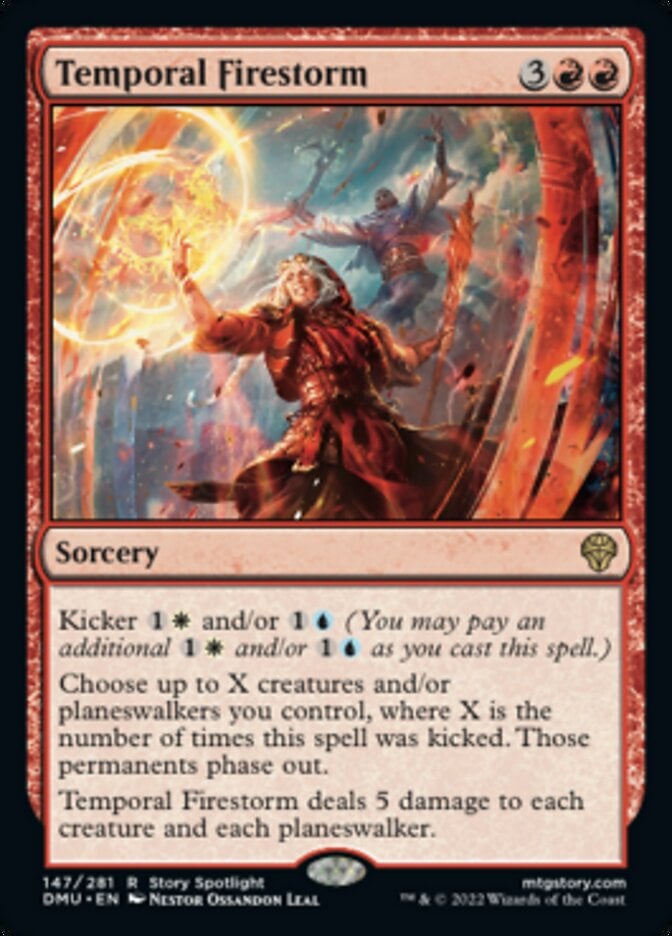
Rating: 7/10 without kicker, 9/10 with kicker
Red board wipes always seem to be effective enough, even if they can’t touch the biggest creatures. If you have Temporal Firestorm then at least you know not to overextend onto the board and you can let your opponent run into it. Throw in the kicker and this is going to be on another level.
Like Hostile Takeover from New Capenna, you have the ability to save one or two of your creatures from the fiery onslaught. Although this play costs seven or nine mana depending on what you can afford, a board sweeper that has any kind of flexibility to become one-sided is something that warrants more than a second look.
Thrill of Possibility

Rating: 3/10
Another reprint that you’re probably pretty familiar with by now. As a card that doesn’t affect the board, you have to be careful including too many cards like Thrill of Possibility in your deck, but one is usually fine. This becomes a very effective way to draw into more spells if you have a deck dedicated to instants and sorceries.
Twinferno
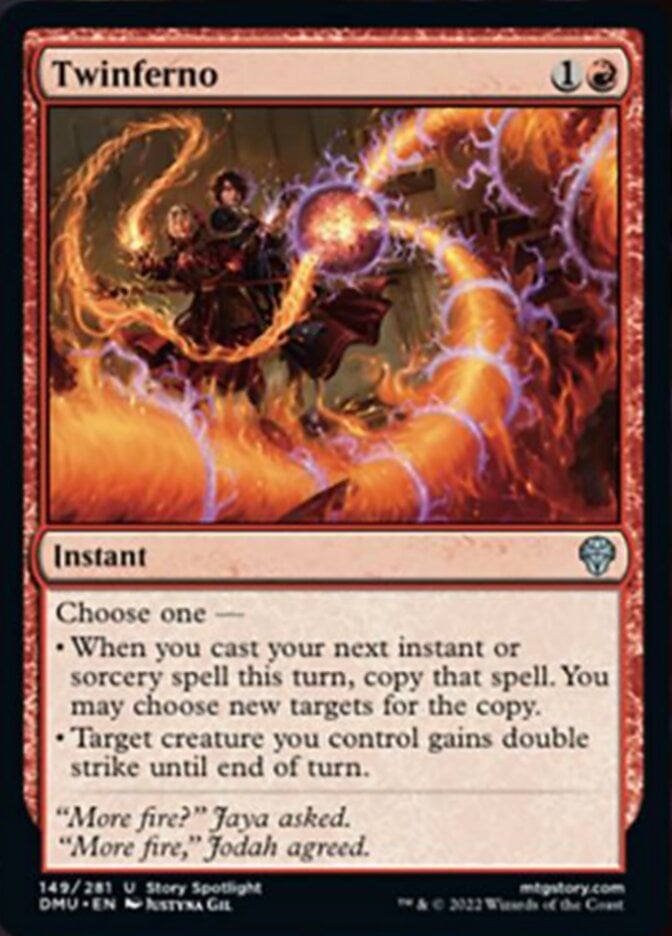
Rating: 1/10
Modal spells are normally good because having the option of either of them makes for a good mix, even if both modes are narrow in application. But the issue for me on Twinferno is that, while both modes are narrow, the same deck isn’t likely to want both.
When you consider that and look at each mode separately, you just don’t want this at all. Copy spells couldn’t even find a home in the set built around instants and sorceries, and combat tricks that only give double strike without a power buff of some kind always fall by the wayside.
I think it’s generally going to be better to avoid this.
Viashino Branchrider

Rating: 3/10 without kicker, 4/10 with kicker
The issue that 1/1 haste creatures for one mana always have is difficulty scaling into the late game, the same issue that 1/1 fliers tend to have. Luckily Viashino Branchrider has too nice abilities that give it that ability to scale, meaning that you should be fairly happy to have this creature attacking on turn 1 and still being big enough to trade up later in the game, even in decks that aren’t the most aggressive.
Warhost’s Frenzy
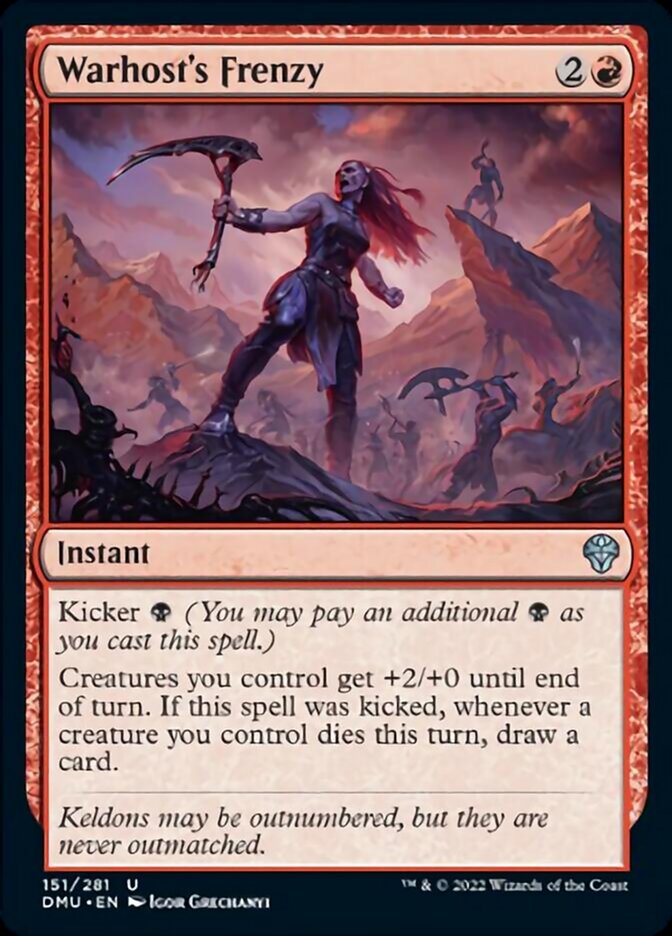
Rating: 2/10 without kicker, 4/10 with kicker
Trumpet Blast effects usually need a little bit more to be good enough for play, as recent versions have figured out by tacking on an extra card in some way. Warhost's Frenzy is a nice version where the right setup will actually have you drawing multiple cards from it if you can afford the kicker cost.
While the ability to set up a bunch of blocks on bigger creatures (or attacks into bigger creatures that are likely to block), casting this with its kicker to trade up and draw a bunch of cards, sounds amazing, it also sounds incredibly unlikely to happen. So while this has a lot of potential, it’ll be average at best most of the time.
Yavimaya Steelcrusher
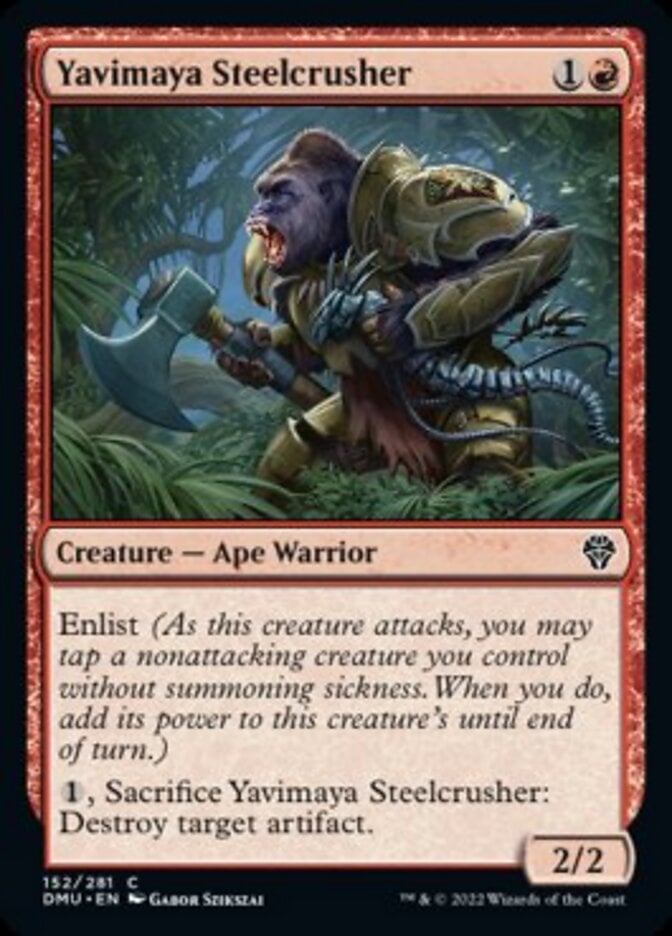
Rating: 4/10
Gone are the days when 2-drop 2/2 vanilla creatures were good enough. While we do place a premium on 2-drops these days, we also expect a little extra. Thankfully you have one here with two very big upsides.
Being able to sacrifice Yavimaya Steelcrusher and kill an artifact is a very useful ability to have around, and there are some very powerful ones that need answering. Enlist gives this the ability to attack into much bigger blockers later in the game, making it a great 2-drop that scales as the game goes on.
Yotia Declares War
Without any archetypes that really care about artifacts, I don’t see why I’d ever want Yotia Declares War. In a vacuum I can make an Ornithopter, tap it to deal damage to something, and then turn it into a 4/4 for just one turn. That feels incredibly weak to me and I just don’t see it without an archetype to support what this wants to do.
If you happened to have a greater than average number of artifacts in your deck then the second ability is very attractive, but otherwise just ignore this.
Green
Barkweave Crusher

Rating: 3/10
The fact that Barkweave Crusher, unlike many of the others we’ve seen, doesn’t do much without enlist, is enough to make me dislike it. Looking down the set list green seems to have enough green commons that I don’t think I want to bother with this.
Bite Down
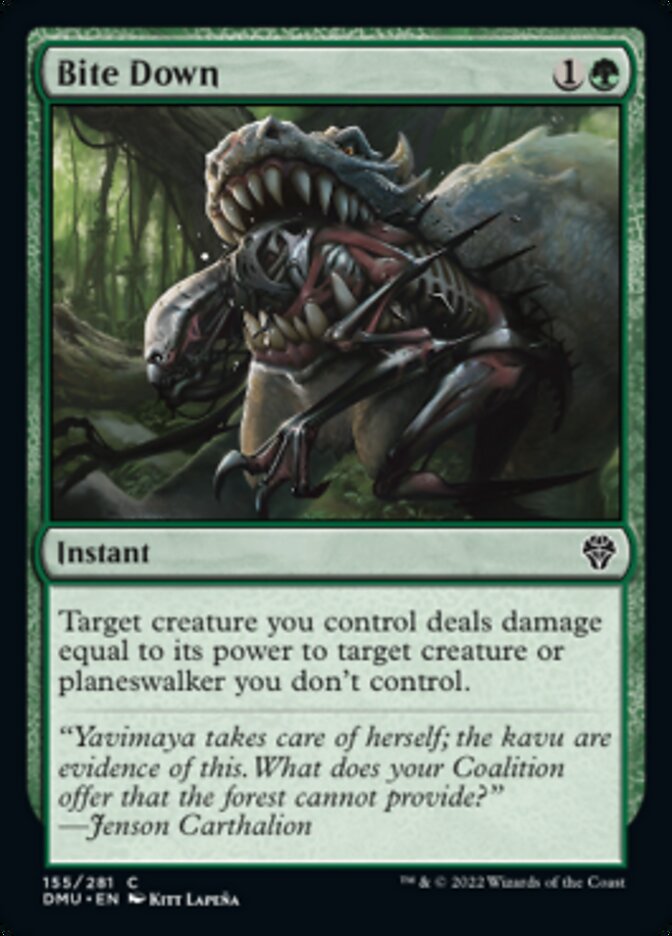
Rating: 6/10
Like Master's Rebuke before it, we’ve seen that when your “bite” spells are instants they’re incredibly powerful. Bite Down is the best way that green has to remove creatures and it’s definitely something you should be picking highly.
Bog Badger
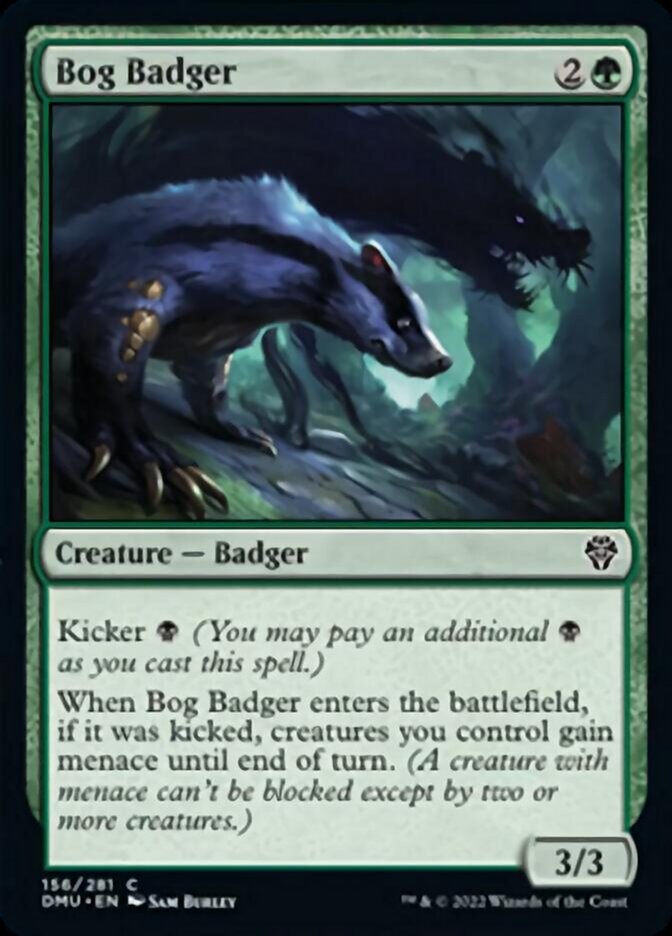
Rating: 3/10 without kicker, 4/10 with kicker
Vanilla 3/3s for three are fine, but they tend to get outclassed these days. Still, you could certainly do worse if you need something to fill the curve.
If you have the option of kicking Bog Badger, then giving menace to your team ought to be painful for your opponent. Especially since green has access to bigger creatures that they’d prefer to be chump blocking if they needed to. But it’s not such a huge effect that it pushes the card beyond the average level.
Broken Wings
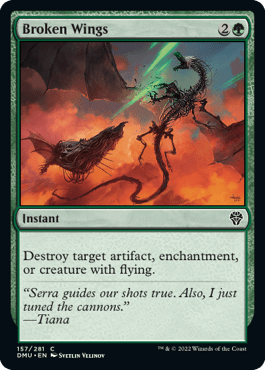
Rating: 2/10
Broken Wings is one of the most versatile sideboard cards you can get in a Limited set, and this is bound to be no different. Given that it can kill flying creatures I’d probably start one in my main deck in a Sealed event and look to any others I had for sideboarding.
You usually don’t want to start it in Draft, but I’d still try to pick one towards the back end of a pack to make sure I have it for post-sideboard games.
Colossal Growth

Rating: 1/10 without kicker, 3/10 with kicker
Vanilla combat tricks are okay, but I think we’ve gotten used to expecting something a little more. But if you get to kick Colossal Growth, giving +4/+4 and trample can be a huge deal.
+4/+4 should be more than enough to win you a fight and trample is incredibly good at helping you push through damage and keep your chances of racing alive. Colossal Might was a neat little trick back in the Shards of Alara days, and this seems like it can do some work too.
Deathbloom Gardener
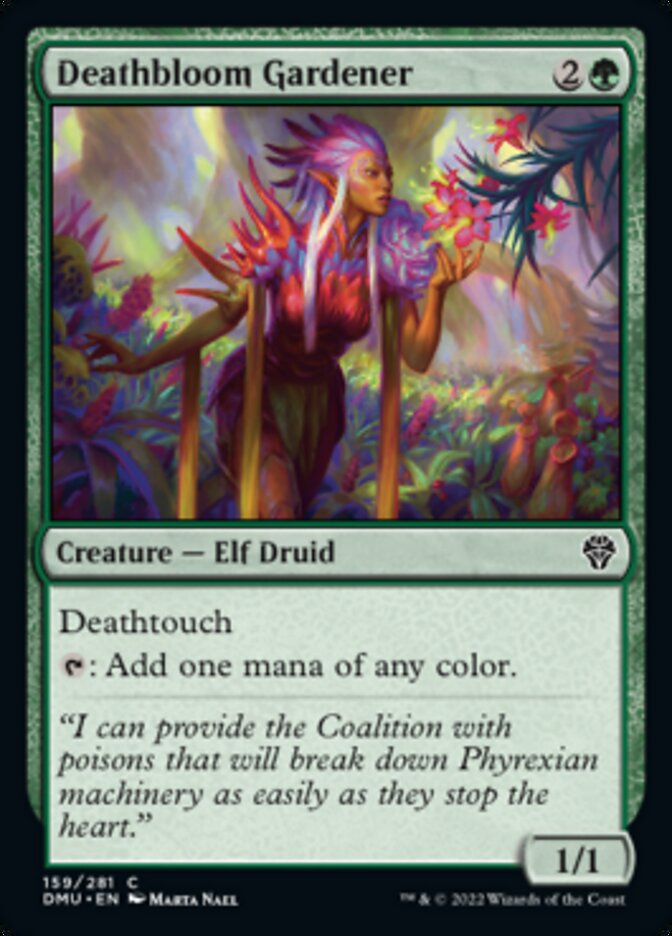
Rating: 3/10
While I’m a fan of mana dorks, they’re a bit expensive at three mana and I don’t think giving them deathtouch is the kind of upgrade we’re looking for to make that worth it. Still, Deathbloom Gardener does help you cast 5-drops a turn earlier if your deck has a bunch of them.
Defiler of Vigor
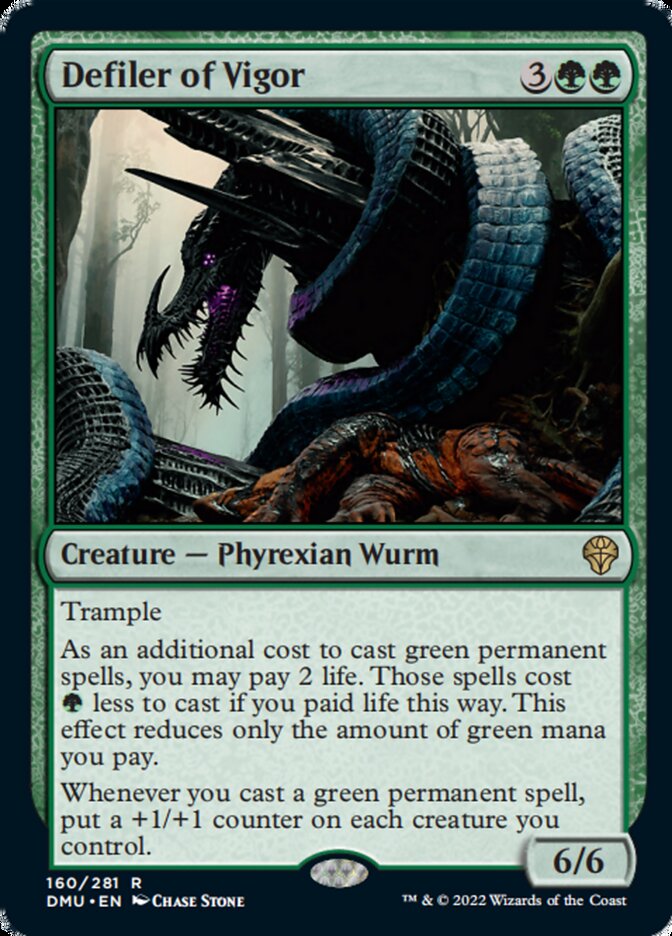
Rating: 9/10
Most likely the most backbreaking of all the Defilers, Defiler of Vigor has one of the more relevant abilities spreading around potentially a lot of +1/+1 counters. Not only that, it’s the most devastating to hit the board.
Five mana for a 6/6 trample is an absurd rate. Its ability even grows itself, making it very quickly become an even more out-of-control threat.
Elfhame Wurm
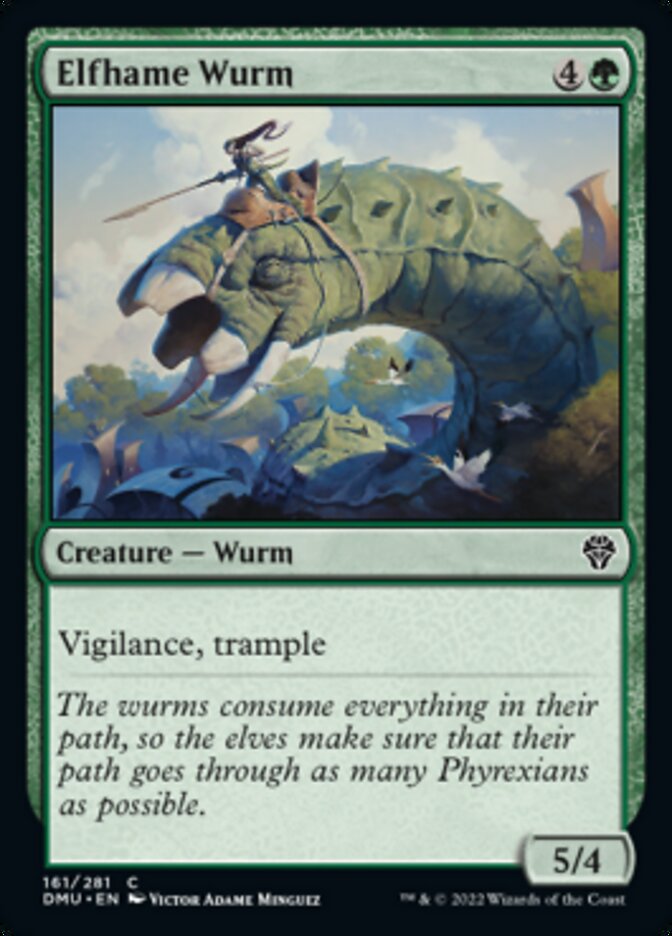
Rating: 4/10
If I’m paying five mana for a big chonky wurm, then it had better do enough to warrant that. Funnily enough you ended up playing Grizzled Outrider more often than expected, so throw in vigilance and trample and I think you have a fairly decent card in Elfhame Wurm.
Elvish Hydromancer
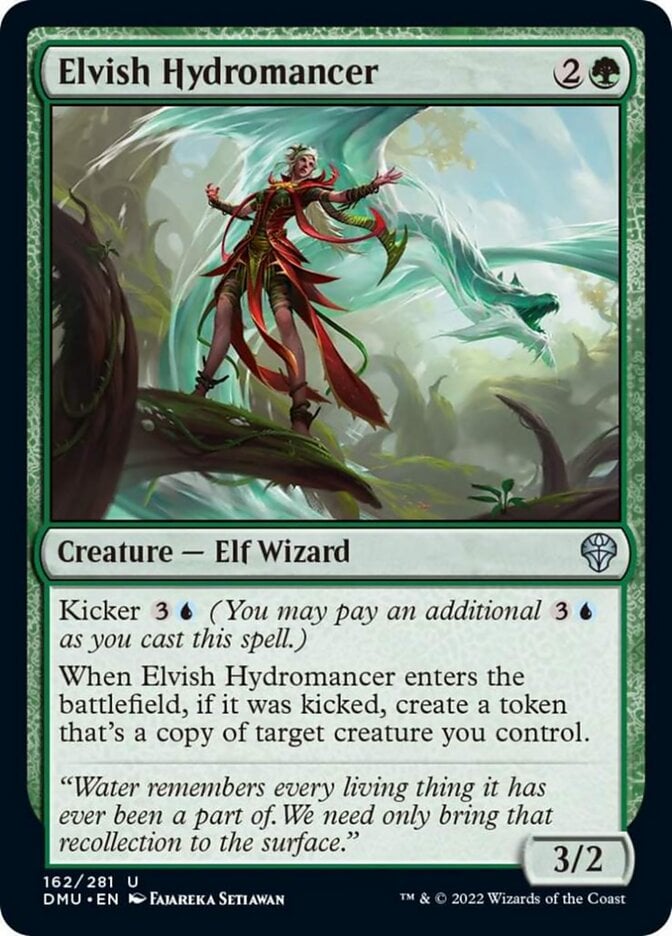
Rating: 2/10 without kicker, 6/10 with kicker
You’re not interested in vanilla 3/2s for three, so you really want the kicker cost to pay you off on Elvish Hydromancer. It’s a very powerful effect to make a copy of one of your creatures as long as you’re making something of a decent size.
If you’re lucky you can copy your sweet bomb rare and really run over the game. But at least the fail case is you get to have it copy itself and make a pair of 3/2s for seven mana, which honestly isn’t the worst since you’ve only used one card.
I think this is very much worth taking a punt on if you have both colors.
Floriferous Vinewall

Rating: 4/10
Although I’d rather guarantee getting a land, the odds of not finding one in the top six are really low. Plus there’s the upside of potentially finding a dual land.
Floriferous Vinewall ought to be a nice card for the defenders decks in particular, but I’d still be happy with this in any green deck that wasn’t looking to be fast and aggressive.
Gaea’s Might

Rating: 1/10
Most decks should only be able to get a +2/+2 out of Gaea's Might, which isn’t good enough. You need to be a domain deck if you want +3/+3 or greater, which is just not going to want combat tricks so I doubt this is good enough.
There are a ton of combat tricks in this set and the others look a lot better to me.
Herd Migration

Rating: 8/10
It looks like domain won’t be that hard to achieve with a cycle of common dual lands and a bunch of random mana fixing. Herd Migration is easily one of the best payoffs for that deck giving you 15/15 in total stats across five creatures if you have all of the land types.
Not only that, having basic landcycling also helps it enable the domain deck very well. When a card is simultaneously a great enabler and great payoff for the same archetype, that equals an incredibly powerful card in my mind.
Hexbane Tortoise
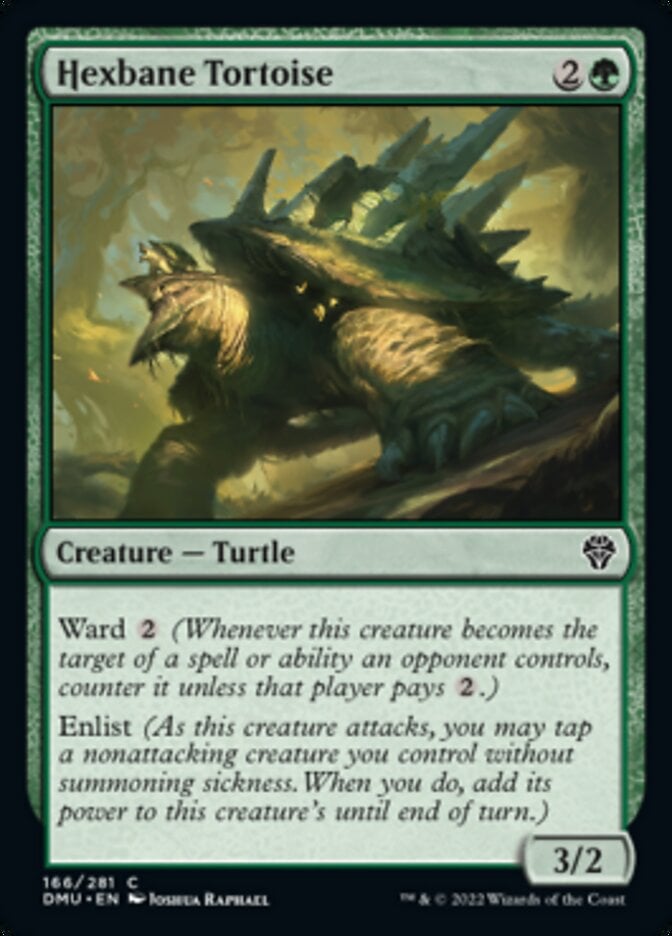
Rating: 3/10
Ward seems pretty irrelevant on a creature that has no way of preventing itself from trading with 2-drops in combat. Enlist not raising toughness is key on Hexbane Tortoise because no matter how big it gets or how hard it is to kill with remove, always risking a trade down is just too much of a liability for me.
Leaf-Crowned Visionary

Rating: 4/10
While this final lord is too weak to do anything by itself, Leaf-Crowned Visionary has one of the stronger abilities out of all of them and there are quite a lot of elves to trigger it. While you need at least a few elves if you plan to play this, they shouldn’t be too hard to find. And the card is worth playing if you get to trigger this even once.
Linebreaker Baloth

Rating: 6/10
Enlist on an already big green creature is interesting, and you have a big incentive to grow Linebreaker Baloth up to a 7/5 or 8/5 and hit really hard since it really can’t be chump blocked.
The line of unblockability tends to play out really well as we’ve seen on past cards like Enraged Ceratok, so I expect this to be a great top end in an aggro deck or a great play in midrange decks.
Llanowar Greenwidow

Rating: 8/10
You don’t really need to sell me on a 4/3 trample-reach creature for just three mana. In fact, I’d expect you to be offering me some kind of downside to balance it out. Instead, you’re offering me a ridiculous ability that lets me buy it back for a turn? Yes, please.
I’ll happily pay the six mana that Llanowar Greenwidow is likely to cost and if I happen to have other types of land out then I get a nice little discount too. Awesome, awesome card.
Llanowar Loamspeaker
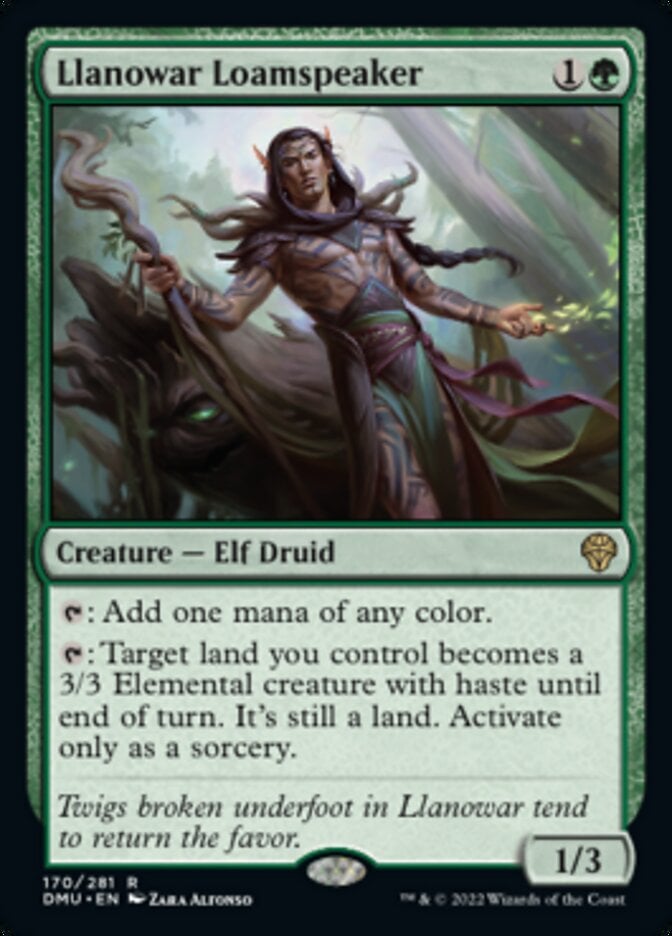
Rating: 7/10
2-drop mana dorks always tend to perform well in Limited. Llanowar Loamspeaker is perfect for hitting all the weird off-color kicker costs that you might have since it lets you fix any color.
Throwing lands at your opponent as 3/3s also makes it a very relevant threat in combat if you draw it late. I love when mana dorks are capable of that, and this one looks like it won’t disappoint.
Llanowar Stalker

Rating: 3/10
Foundry Street Denizen is one of the cards that surprised me the most. When it first came out I thought, “there’s no way this card is good.” And then it ended up being a great card in both Limited and Standard. I don’t see Llanowar Stalker working out quite so well.
Green has far less of an ability to play a bunch of small creatures and enable this. If you pair it with red or white’s token generators then the card probably has a home. But it’s not a good card at all if you don’t have any good ways of enabling it.
Magnigoth Sentry
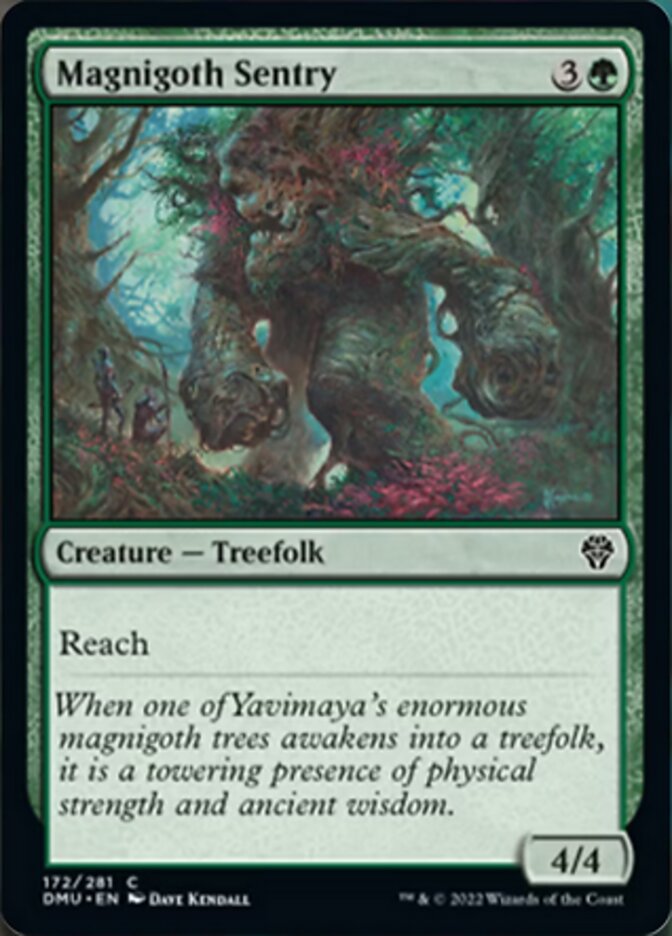
Rating: 4/10
You can’t get much simpler than Magnigoth Sentry. 4/4s for four with an extra keyword are simple bread and butter Limited cards for green decks, and this one is very welcome to the party.
Mossbeard Ancient
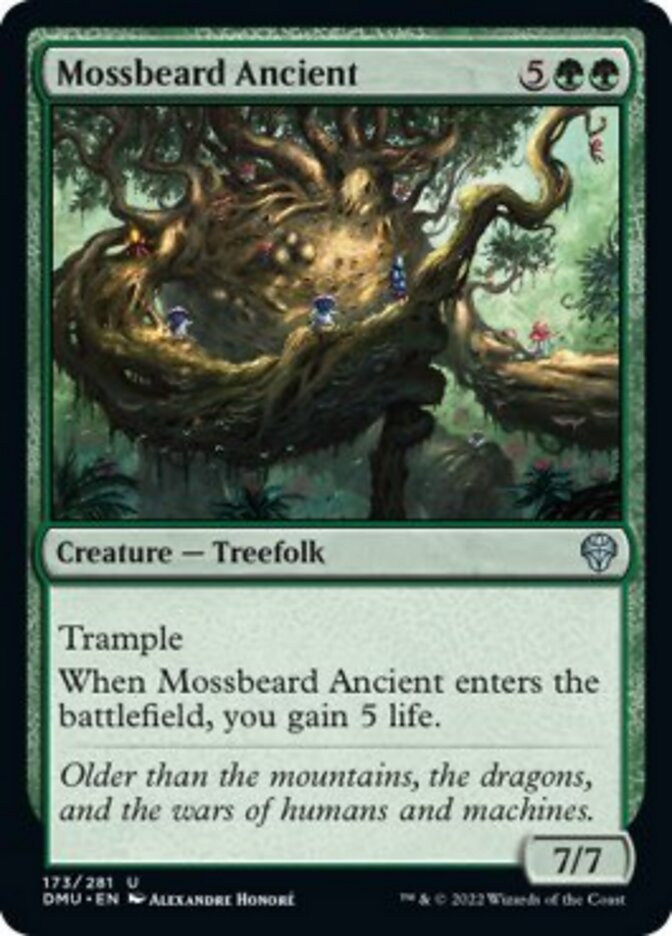
Rating: 5/10
Honey Mammoth got itself extra chonky for this set. Seven mana is harder to hit, but trampling and gaining five life will presumably prove to be big enough upgrades that Mossbeard Ancient is worth trying to get to.
Nishoba Brawler

Rating: 5/10
The base rate on Nishoba Brawler is that it’s very likely a simple 2/3 trample for just two mana, which is an exceptionally good rate. Throw in other land types and you start getting a huge threat that likely demands an answer and can even give veteran zoo creatures like Woolly Thoctar a run for their money.
Quirion Beastcaller
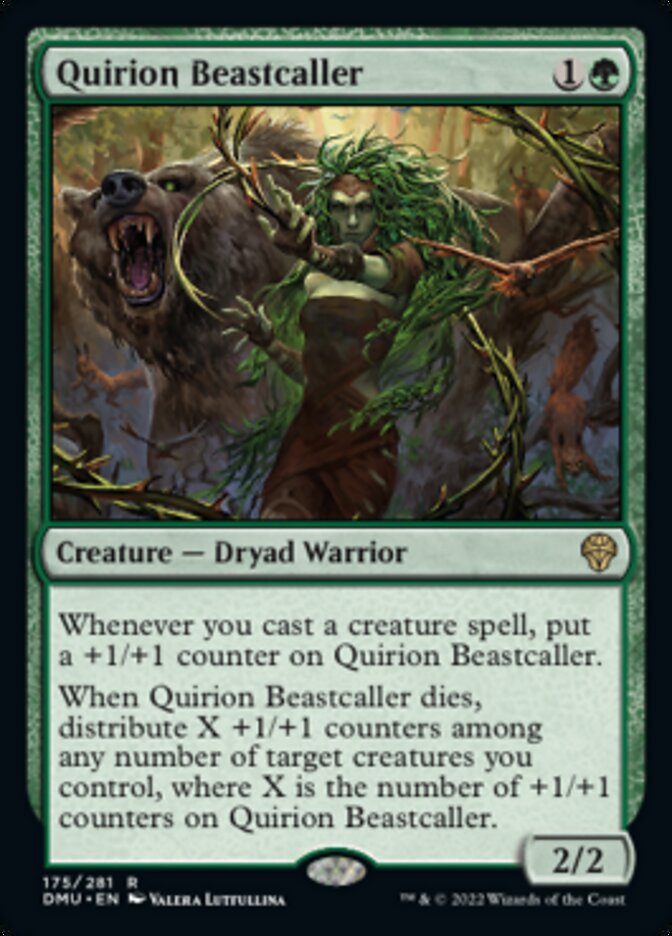
Rating: 8/10
The usual downside with Quirion Dryad-style cards is that they just don’t reward you often enough, or they don’t start large enough to make up for it. But here you have a creature that starts out as a 2/2 and triggers whenever you cast creature spells? What deck have you drafted that doesn’t play creatures?
Quirion Beastcaller is absolutely absurd. The modular-esque ability takes it even further, so having this die won’t waste all the triggers you got. This is one of the best opening plays I’ve seen so far and should completely dominate a game if it’s left unchecked.
Scout the Wilderness
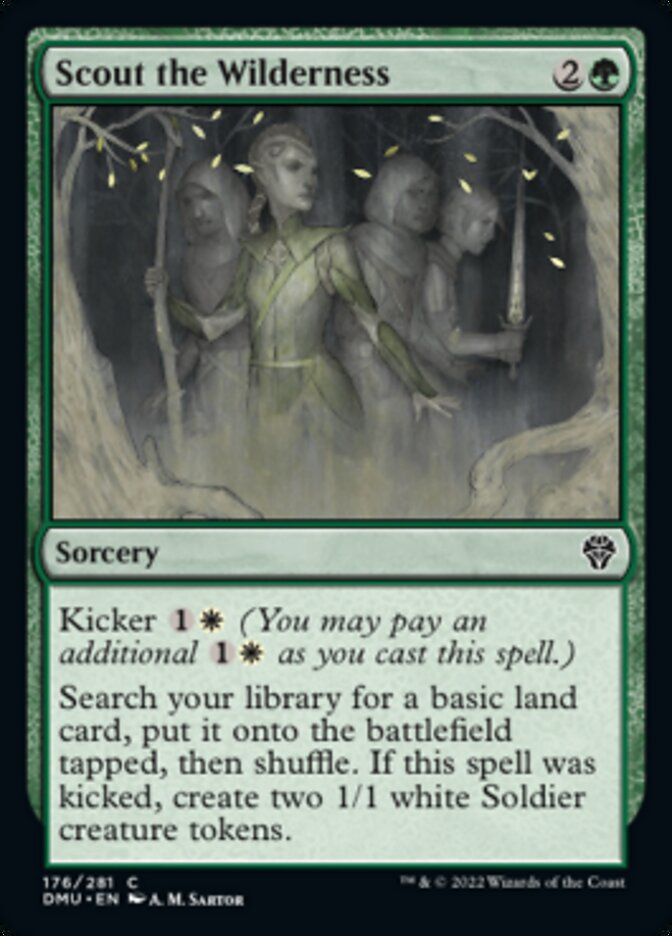
Rating: 1/10 without kicker, 2/10 with kicker
As much as I want ramp spells to be good, the hard truth is that at they’re too strong at two mana and they suck at three. Even in a set where you actively want to be splashing, casting 3-mana sorcery just isn’t the way you want to do it.
You at least have a nice bonus if you get Scout the Wilderness’ kicker off. But you’ve still cast a 5-mana spell that did very little beyond making two 1/1s, which is hardly the most impactful play you could be making.
Silverback Elder
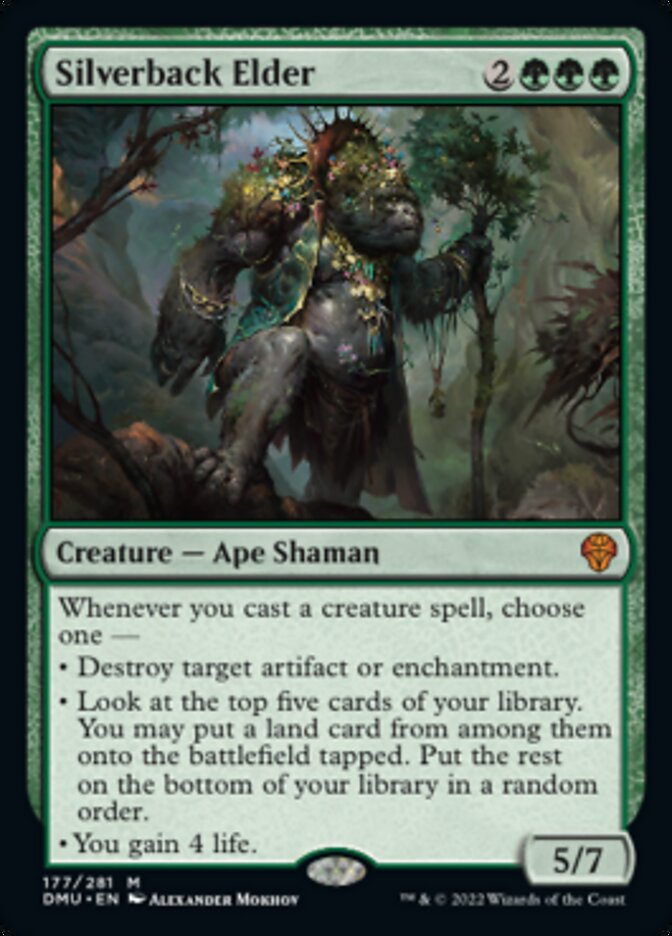
Rating: 7/10
I keep reading Silverback Elder and expecting it to do more than it actually does. A triple green mythic rare that doesn’t do anything until you do something later isn’t all that impressive. It is really big, so you’ll probably have enough time to cast more creatures. The payoffs you get for doing so are fine, but nothing that’s going to take over a game for you.
Gaining life is probably the most important one since it helps you to stay alive for longer. But nothing here helps you press an advantage, like making more creatures or drawing more cards. This creature is fine overall, just not as powerful as it looks like it could be.
Slimefoot’s Survey
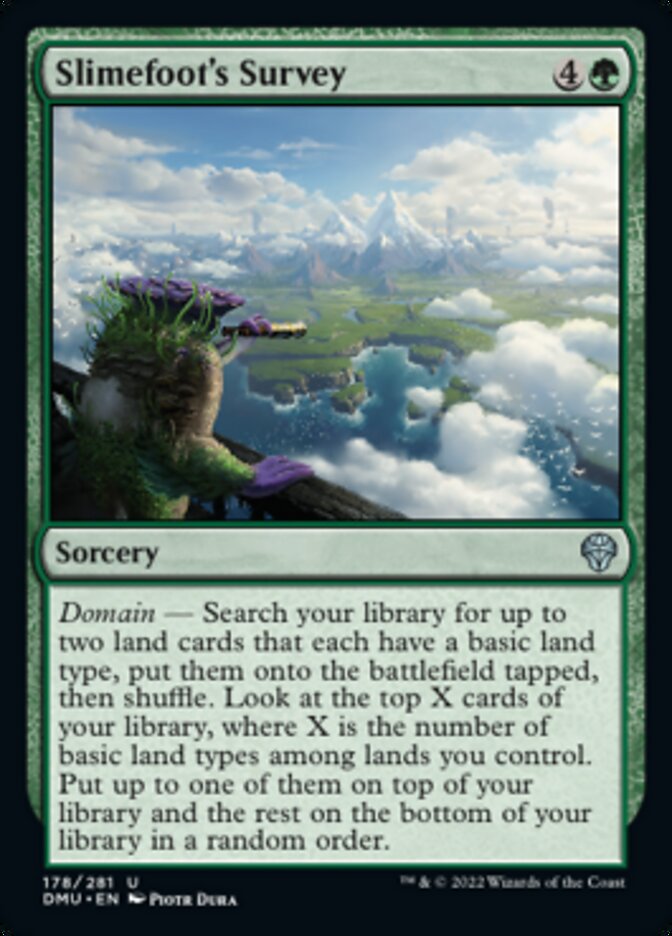
Rating: 1/10
For me to be interested in Slimefoot's Survey I’d really want to be drawing the card you find off the last part of the ability. As it stands, yeah, I can fix two land types that I might be missing in my domain deck. And I’m sure there’s a chance I’ll want that, but only setting up my draw step isn’t enough of an upside for me to want to cast a 5-mana sorcery that does nothing to affect the board.
I want these ramp spells to be good, but they just aren’t.
Snarespinner
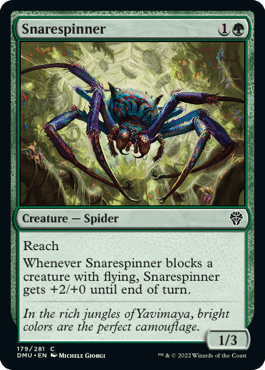
Rating: 4/10
We’ve seen Snarespinner before, and it’s always performed well. While Snarespinner won’t be welcome in your fast and aggressive decks, being a 3/3 blocker against fliers is excellent in control and midrange decks that just need answers to those.
Strength of the Coalition
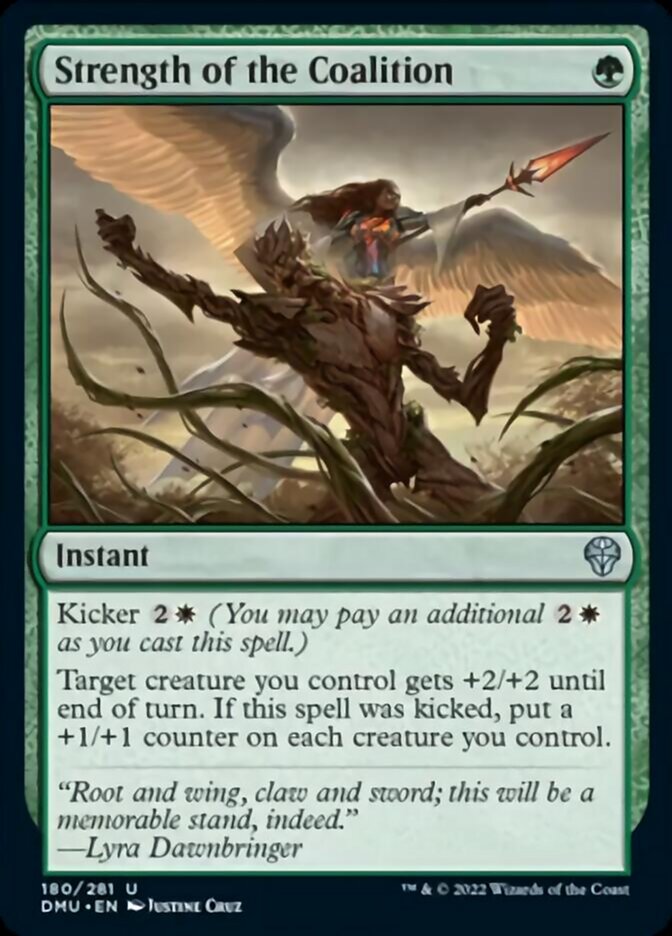
Rating: 2/10 without kicker, 4/10 with kicker
A generic +2/+2 trick is fine if you need it, but you probably want something more out of your spells than that. Well, if you can kick Strength of the Coalition then you get a really strong mode that you’ll probably be able to make good use of since you’re playing white.
Selesnya () does want to go wide thanks to white’s token makers. Putting +1/+1 counters on your whole team is likely to be very strong and even if you only have a couple out. Combat tricking multiple creatures at once opens up the possibility of big two-for-one tempo swings.
Sunbathing Rootwalla

Rating: 4/10
Like I’ve said a lot, you really can’t go wrong with a bear that has an upside. The fact that Sunbathing Rootwalla threatens to be a 7/7 in a domain deck is pretty funny. And even if it can only grow into a 4/4 or a 5/5 elsewhere that still means it’s a solid, average playable.
Tail Swipe
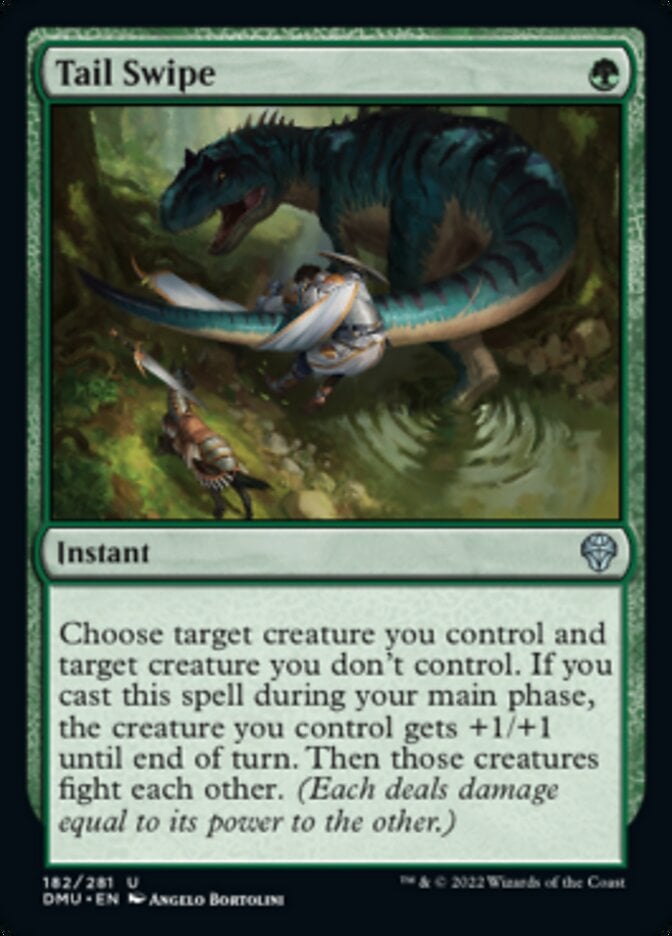
Rating: 6/10
We’ve come a long way since the days of Prey Upon and Hunt the Weak. Tail Swipe has them combined into one card with the ability to cast at instant speed if you don’t need the +1/+1 to win the fight.
Green removal typically sucks, so you should relish the moment and enjoy it while it lasts when you get good removal spells like this.
Tear Asunder
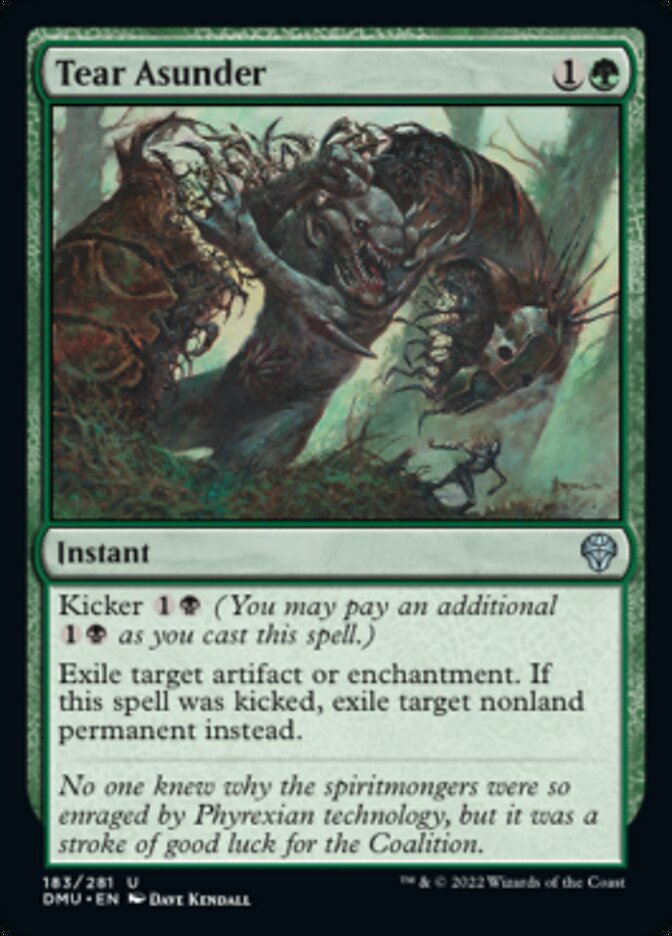
Rating: 1/10 without kicker, 7/10 with kicker
Even if Naturalize now exiles, it’s not good enough to start in the main deck. But a spell that exiles any target is a ridiculous removal spell that’s easily first pickable. This is easily the biggest delta between ratings that I can give since the kicker turns Tear Asunder from crap sideboard material to top tier removal that every deck wants. Just unbelievable.
Territorial Maro

Rating: 4/10
Mark Rosewater’s back, and he hits pretty hard this time!
You can only play Territorial Maro in a domain deck, but if you do then it can be a nice 8/8 or 10/10. Sadly a lack of any keywords like trample really limits how strong this can be, but I’m sure that it should still perform fine even if it’s getting chump blocked turn after turn.
Threats Undetected

Rating: 1/10
I don’t think it’s worth spending three mana to draw two cards that your opponent chooses for you. Sure, you pick what goes in the pile, but is your opponent really going to pick the 4- and 5-power creatures in the pile when you also picked crappy 2- and 3-power ones?
I don’t see Threats Undetected going well, and green decks in this format likely can’t afford to spend their mana not adding stuff to the board.
Urborg Lhurgoyf

Rating: 6/10 without kicker, 7/10 with kicker
It’s pretty easy to make some comparisons to Tarmogoyf, so since WotC are baiting me into it I’ll oblige.
Tarmogoyf’s power usually comes from the fact that paying the two mana for it is well worth it if it’s consistently a 3/4 or bigger. Creatures tend to trade off less often than you might think, but black does have a bit of self-mill to help this along as well as Urborg Lhurgoyf’s own kickers.
I don’t think it’s hard to set up a scenario where you hold onto this until the graveyard is a bit more full and then drop this as a cheap 4/5 that grows bigger as the game progresses. There will be some long games where you top deck it and it’s a 9/10 or something stupid.
It’s not likely to survive if you play it on turn 2. But if all you have to do is wait a bit and consider it to be a card for later in the game then I think it’s a pretty good deal.
Vineshaper Prodigy

Rating: 3/10 without kicker, 6/10 with kicker
I love the flexibility that Vineshaper Prodigy provides. I’m not all that happy with a 2/2 vanilla creature these days, but if my excellent 4-drop can be played as a Forest Bear in a pinch, then that’s a mode I’m very happy to get on top of what is very similar to the busted Sarulf's Packmate.
The Weatherseed Treaty
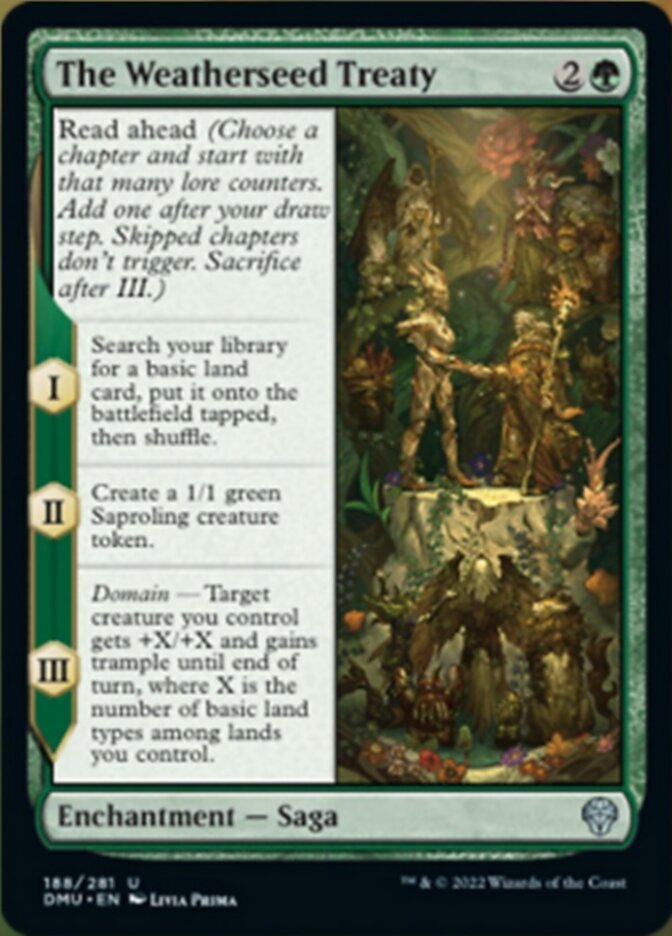
Rating: 5/10
I haven’t liked any of the ramp spells that we’ve gone past so far, but I do like The Weatherseed Treaty. Three mana is a bit much, but getting a Rampant Growth followed by a Saproling token makes for a good enough deal that I’m interested.
You even get to swing with the Saproling as a 4/4 or 5/5 on the following turn thanks to the final chapter, so all-in-all I think you have a nice card. You can even skip straight to chapter three sometimes when doing so gives you the ability to swing past a giant blocker.
The World Spell
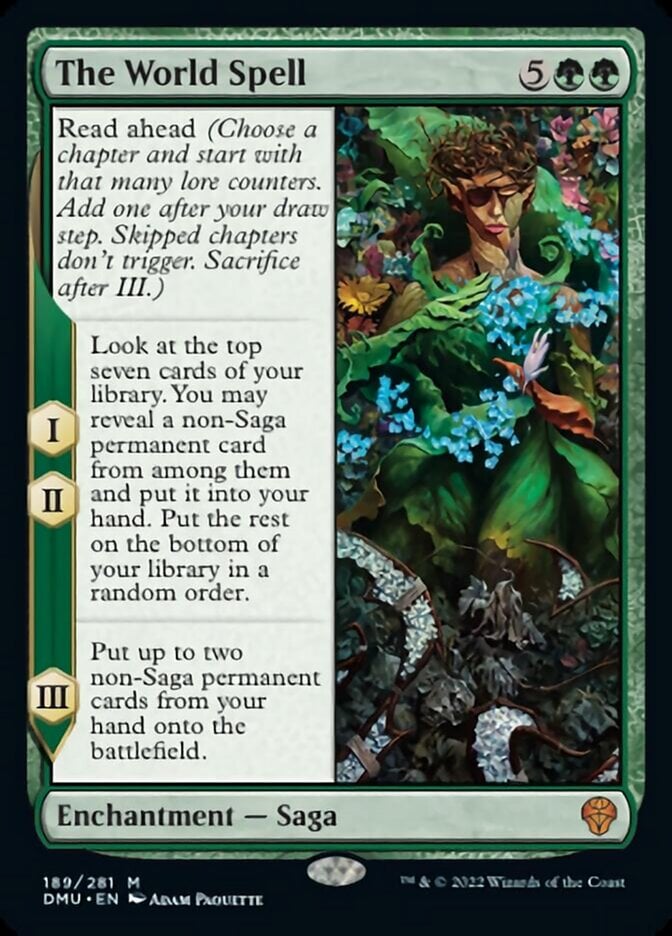
Rating: 0/10
Seven mana is a big ask in Limited games, so you really need a big effect if you’re going to be spending that much. While The World Spell has some serious Tooth and Nail vibes, you just can’t be spending seven mana on an effect that does so little.
There’s nothing that you’re likely to want to cheat into play by skipping ahead to the third chapter, and being able to grab two creatures from your top 14 cards isn’t worth such a hefty mana investment. This is quite clearly a cool plant for Constructed and I have a Commander deck that will pick this up straight away, but in Limited it’s a complete bust.
Yavimaya Iconoclast

Rating: 5/10 without kicker, 7/10 with kicker
I’m already very happy with a 3/2 trample for just two mana. That’s a stat line that’s efficient enough to see play in every green deck. Throw in a red kicker to get me a 4/3 haste, trample for just three mana, and you have a really absurd rate.
Even if Yavimaya Iconoclast doesn’t keep its stat buff after the turn ends you’re still left with a great body after what should be a very impressive first hit.
Yavimaya Sojourner
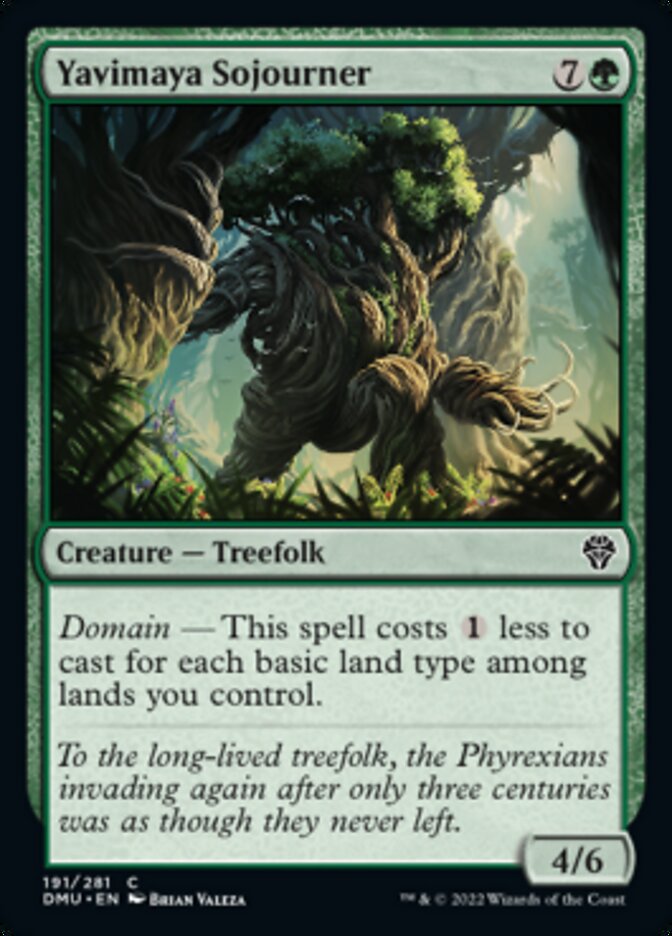
Rating: 3/10
Yavimaya Sojourner is by far the worst card in this cycle. Only a dedicated domain deck would be interested in it, and if you do get all five land types out then your big reward is a vanilla 4/6 for three mana? I think that’s too much work to do when you’re getting so little in return.
Multicolored
Ajani, Sleeper Agent
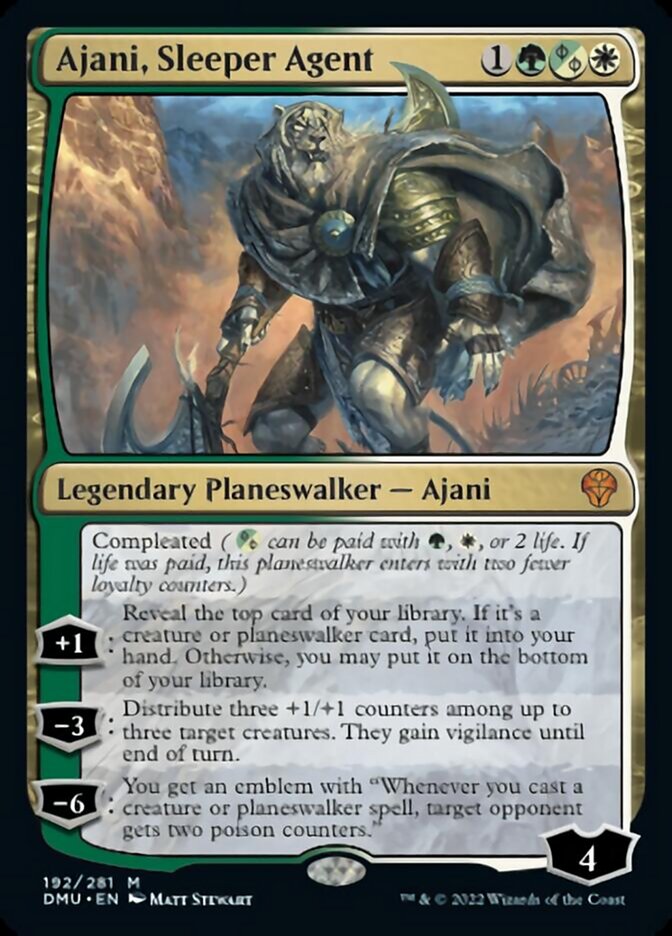
Rating: 6/10
The key ability you’re looking for on any planeswalker is the ability to protect itself from an incoming attack, which Ajani, Sleeper Agent isn’t very good at doing. Its -3 has some capacity to do this while keeping up the pressure on your opponent, but it’s not the most effective at doing this.
At least its +1 ability either draws you a creature or bottoms a land in most Limited decks, so it should be able to do a fair bit of work if played onto an empty board or behind enough blockers. Ajani should provide enough long-term advantage to swing a game your way if left undefeated, and its ultimate is powerful too.
It just naturally loses points for being a little too fragile in many situations.
Aron, Benalia’s Ruin

Rating: 7/10
The base stats on Aron, Benalia's Ruin are a really good start, but its ability being so broad is the thing I’m excited by here. It has no timing restrictions, which allows you to do this in response to removal or during combat.
Even the threat of activating this in combat is enough to get through a bunch of extra damage. This looks like an excellent creature, and you’ll win games very quickly if you can build towards it and go wide.
Astor, Bearer of Blades
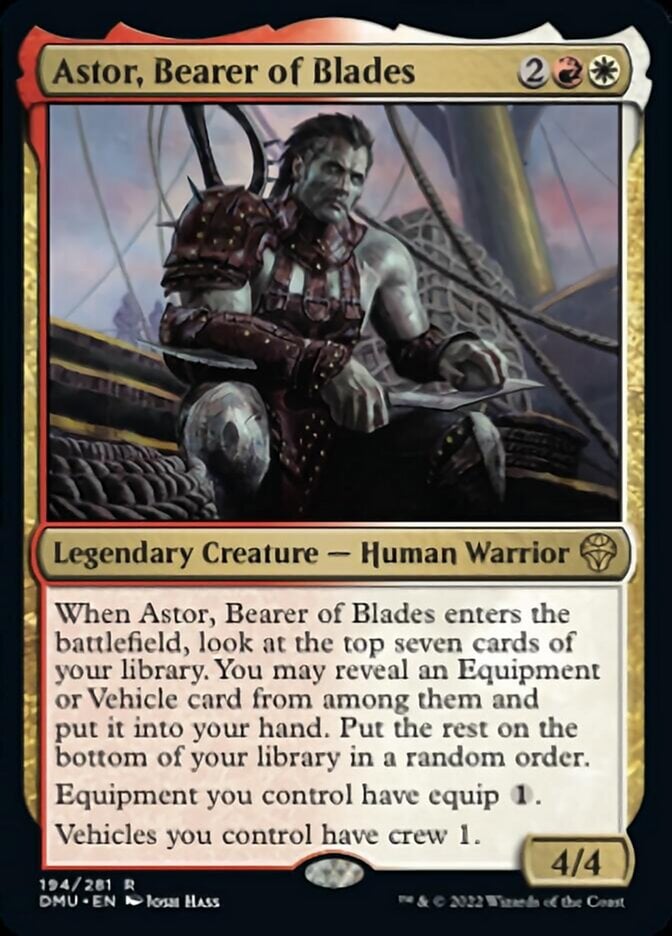
Rating: 4/10
There aren’t a lot of vehicles or equipment in the set, so Astor, Bearer of Blade’s usefulness beyond being a vanilla creature is severely limited. Its stock goes up if you have one and it’s a cool way to cheat past the restrictions on Weatherlight Compleated, but it’s just not very exciting outside of Constructed and Commander.
Baird, Argivian Recruiter

Rating: 6/10
With red and white having the most enlist creatures, Baird, Argivian Recruiter is basically your big payoff for using enlist, generating a free token every turn just for using it. But that does mean that your opponent can see it coming and make sure the creature you enlisted with is killed in combat.
Because of how the trigger works, you can use an enlist ability and play this post-combat and still get a 1/1 out of it. The easiest way to enable this (depending on your deck) is with a +1/+1 counter so that you don’t have to send your enabler into combat all the time.
This looks like a great build-around and payoff for these aggro decks with so many ways to trigger this and a two mana 2/2 being such a free investment to make.
Balmor, Battlemage Captain
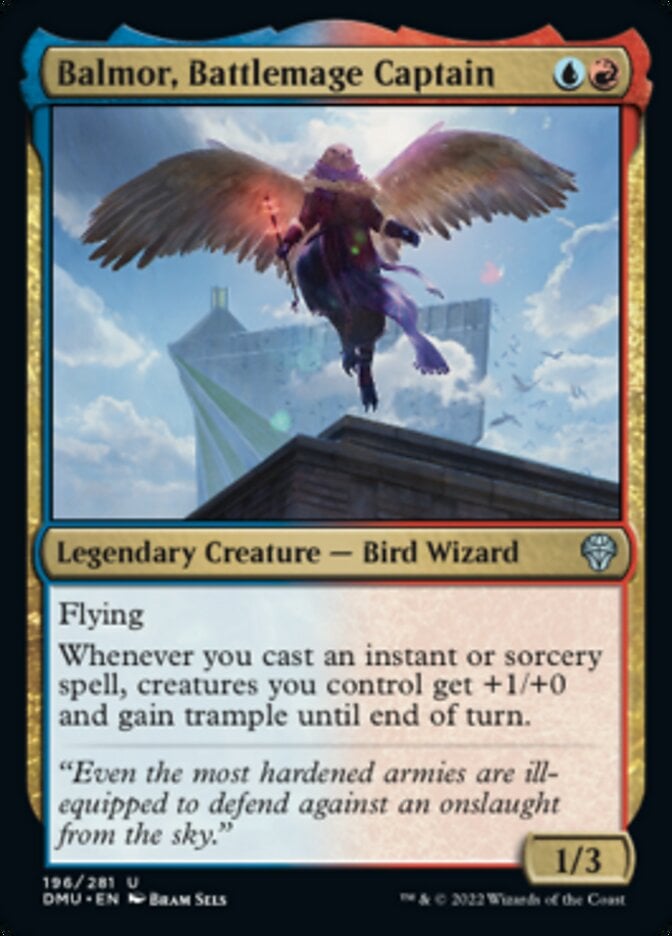
Rating: 5/10
I’m not convinced by Balmor, Battlemage Captain. I think it suffers greatly from what I call “Izzet () mage syndrome.” You want cards that pay you off for casting instants and sorceries, but when they aren’t instants or sorceries themselves that reduces the number of them in your deck, which in turn makes the payoffs worse.
How effective is this going to be in a deck that presumably doesn’t want to play that many creatures in the first place? At least it grows itself and is a nice starting size so it’s not completely useless, but I don’t think this is a great payoff for what you want the deck to do.
Bortuk Bonerattle
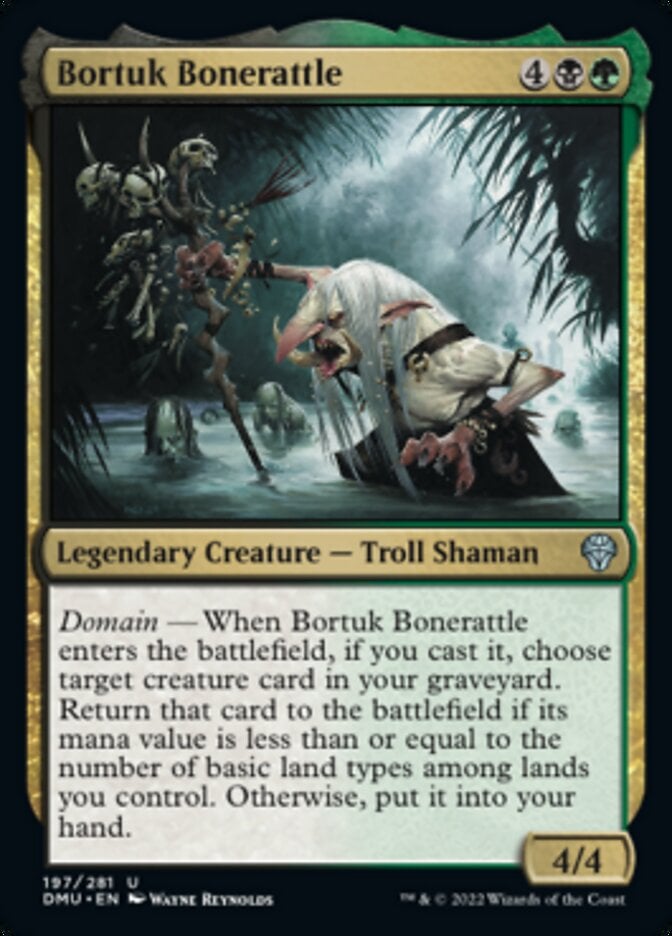
Rating: 6/10
Even if your Gravedigger is a 6-mana 4/4, it’s still a great card. Most decks aren’t that likely to be able to make use of the domain effect since you really want to be getting back the biggest creature you can find.
If that magical moment does happen, then cheating out a 4- or 5-drop is an incredibly powerful swing that should help you catch up a game you were losing or win a game a lot faster than before.
Elas il-Kor, Sadistic Pilgrim

Rating: 7/10
Combining Soul Warden and Cruel Celebrant into the same card is just nasty. Having Elas il-Kor, Sadistic Pilgrim in play is just annoying for your opponent since you’re assumingly going wide and having lots of creatures that love dying, meaning that Elas just guarantee that damage is getting through.
Even if that isn’t possible, being a 2/2 deathtouch means it’s never dead and can always just trade up if needed.
Ertai Resurrected

Rating: 9/10
The comparison I’ll make here is with Venser, Shaper Savant. They’re virtually the same card, but countering a spell or killing a creature and having your opponent draw a card should on average be a stronger effect than just bouncing that card.
Ertai Resurrected is just incredible, being a hard answer to literally any threat whether it’s already on the board or about to be played. They might draw a “better” card when you use it, but odds are they’ll just draw land and you’ll have gained a massive tempo swing regardless of what they draw.
I can’t imagine how annoying it’ll be to have my silly bomb rare countered by Ertai and then have no bomb in play and have an extra 3/2 to deal with. Oh, can I please bounce Ertai too? Tolarian Geyser is perfect for it!
Yeah, Ertai is disgusting and I can’t wait to play it myself.
Garna, Bloodfist of Keld
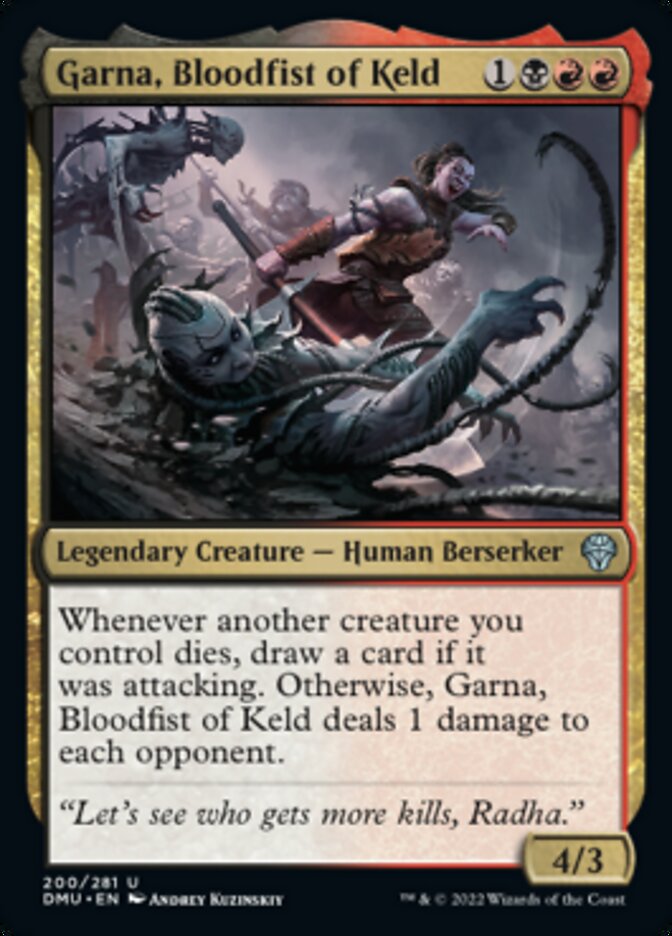
Rating: 7/10
Black and red really want to be attacking fast and trading off their creatures, which is a strategy that Garna, Bloodfist of Keld pays you off massively for, much like its 2018 counterpart Garna, the Bloodflame. Even if you’re just sacrificing your creatures by other means, it’s still paying you off with extra damage which is nothing to be sniffed at.
I’d be happy taking Garna highly and making sure my deck was focused enough to make it shine.
Ivy, Gleeful Spellthief

Rating: 4/10
Ivy, Gleeful Spellthief feels like a much stronger card for some weird Constructed or Commander deck, but it’s pretty cool that it can pick up combat tricks that you use on your other creatures or even ones that your opponent tries to use on theirs. It’s also a 2-mana 2/1 flier which is a really great stat line, so it’s probably fine to run. It’s just not something you can build around particularly well.
Jhoira, Ageless Innovator

Rating: 3/10
There’s no artifact focus in this set, so I don’t see Jhoira, Ageless Innovator doing anything all that useful here. It’s a 2/3 for two so not totally useless, but it’s not going to be very useful unless you pick up some silly rare or mythic artifacts to cheat out.
Jodah, the Unifier
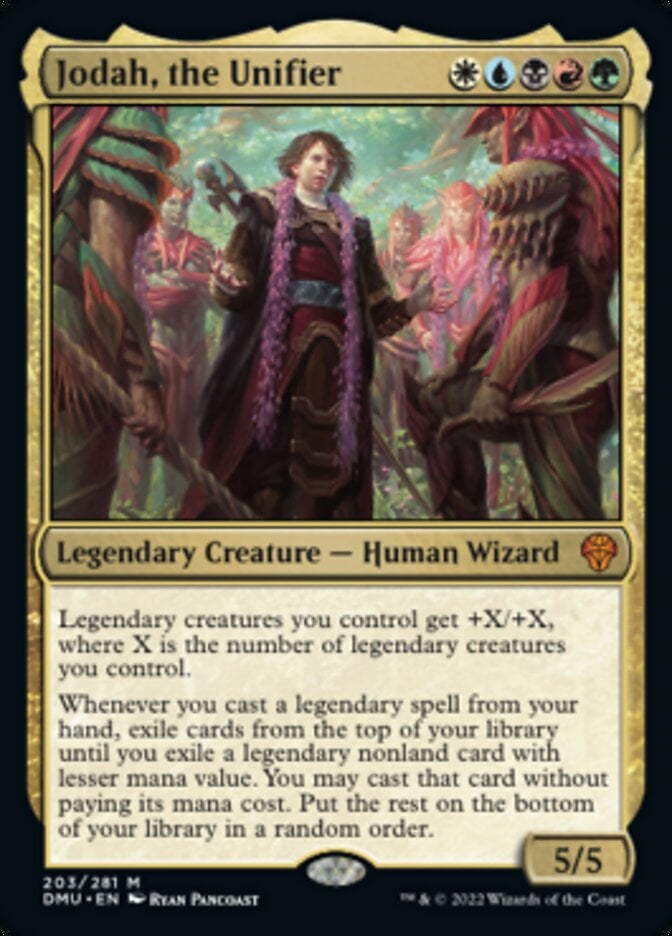
Rating: 6/10
Jodah, the Unifier would probably be a flat 0 under normal circumstances, and thanks for playing. But this set has abundant mana fixing and a Draft archetype looking to get to five colors, so I have to assume that Jodah is imminently castable.
It’s already a 6/6 thanks to its own ability in a vacuum, and it’s very likely that your deck has another legend or two in it. There are 49 legendary cards in the set, 20 of which are uncommons and there’s one guaranteed in every pack.
Seeing as you’re a 5-color deck there should be loads that you’re able to pick up and splash that no one else is interested in. All of this makes the “legendary cascade” ability extremely powerful if you get it to work. Once it goes off once you should be winning, and I don’t know how you can possibly lose if you get it to happen twice.
While Jodah asks some tricky deckbuilding questions of you, the power on offer is undeniable and I’m very much looking forward to building a Jodah deck if I see it.
King Darien XLVIII
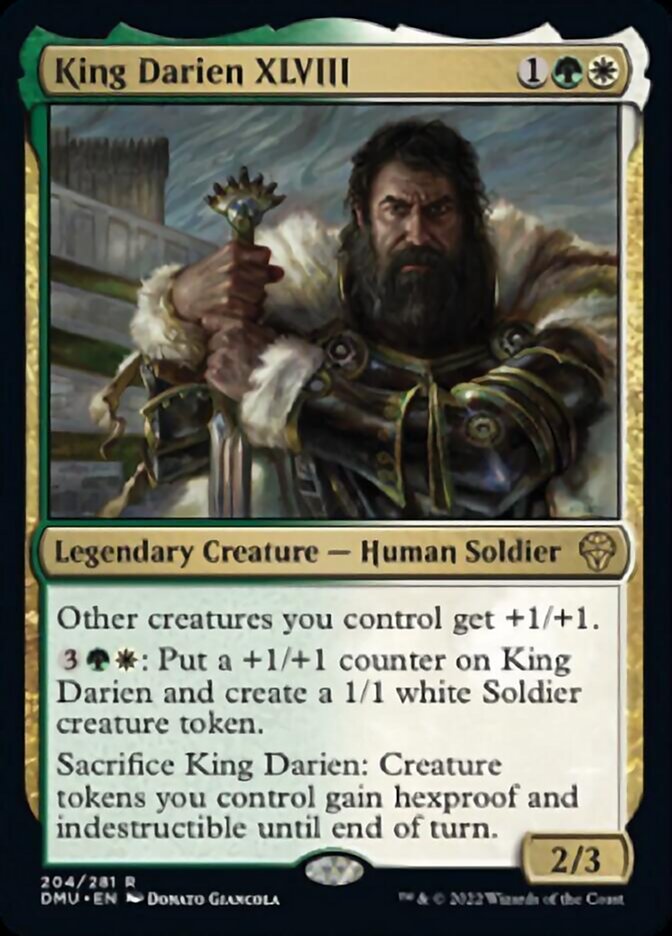
Rating: 9/10
Darien must be a very popular name among the royal families of Dominaria. In nearly 1,000 years of British history, the most kings of the same name we’ve ever had is eight, so to get up to 48 Dariens is pretty impressive.
What’s even more impressive is just how many ridiculous abilities they managed to fit onto King Darien XLVIII. A universal lord that grows itself while churning out Soldier tokens that can also save them all by falling on its own sword, much like Dauntless Escort. Darien would be really good if you removed any one of its three abilities, and with all three it’s just nuts.
You’d best hope that you have removal for Darien as soon as sit comes down or it’ll take over the game.
Lagomos, Hand of Hatred
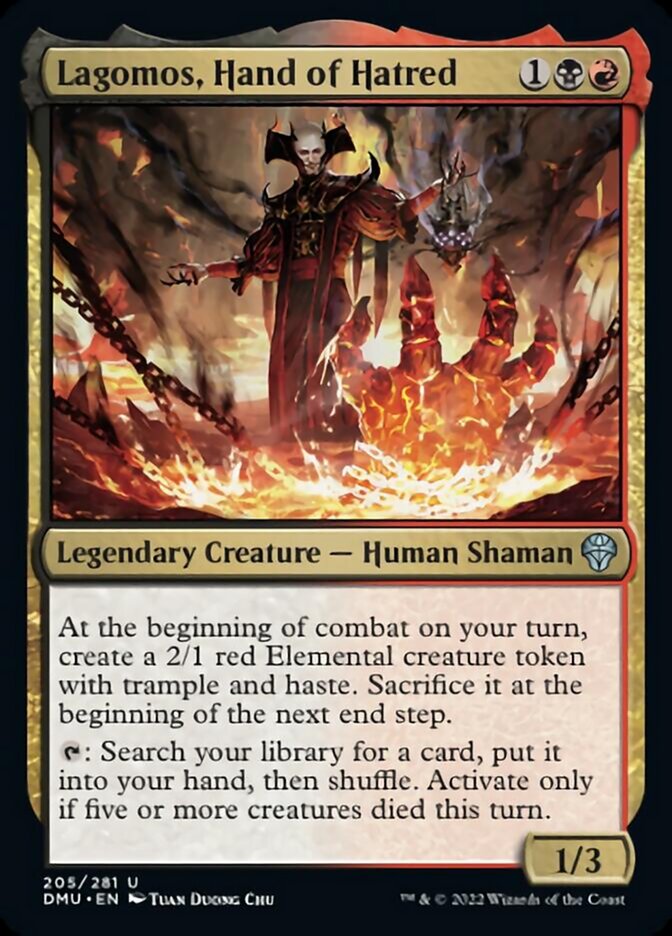
Rating: 6/10
Lagomos, Hand of Hatred reminds me a fair bit of Valduk, Keeper of the Flame, being able to create some aggressive sacrifice fodder every turn. The Demonic Tutor ability is a little too cute, but making a free 2/1 haste every turn is pretty good. And you’ll probably have some ways of making use of that if it can’t get through blockers in Rakdos ().
Meria, Scholar of Antiquity

Rating: 3/10
I’m once again going to point out that this is a set with no artifact synergies. These artifact-themed cards are mainly hinting at the heavy artifact focus of The Brothers War, which we’re only a couple of months away from.
Meria, Scholar of Antiquity is little more than just a decent-sized vanilla creature, so I wouldn’t value it at anything more than that. Sometimes you might have a couple of artifacts out and are able to draw an extra card each turn, which is great, but even a deck with a relatively high number of artifacts isn’t likely to get this to happen.
Nael, Avizoa Aeronaut
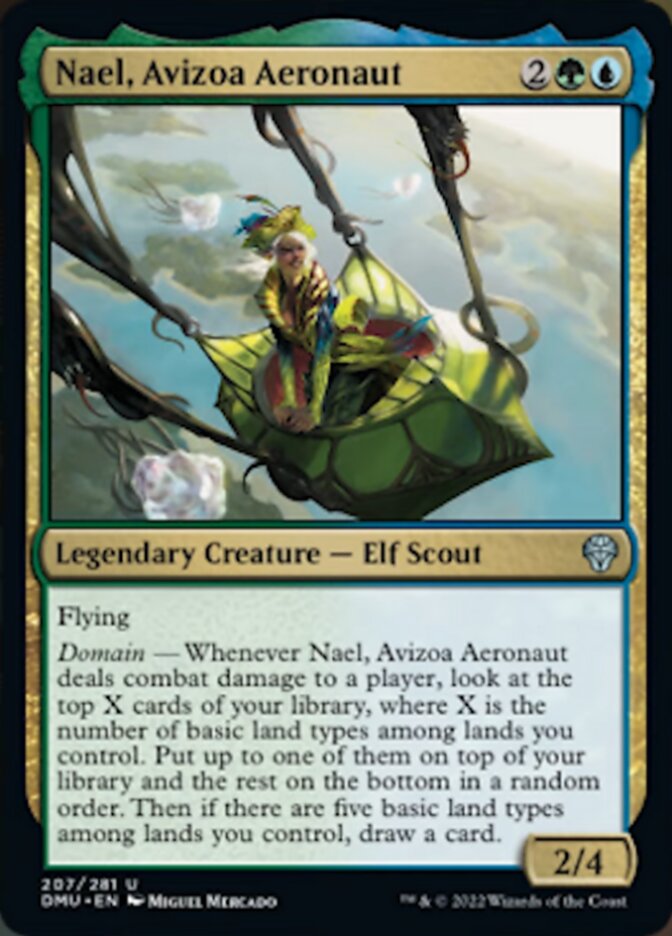
Rating: 7/10
Nael, Avizoa Aeronaut is a domain payoff I can really get behind. If it’s the deck you’re trying to build then I’d guess it should be fairly easy to get all five land types out, at which point a flying creature that lets you draw the best card from your top five whenever it hits lets you take over a game very quickly.
Najal, the Storm Runner
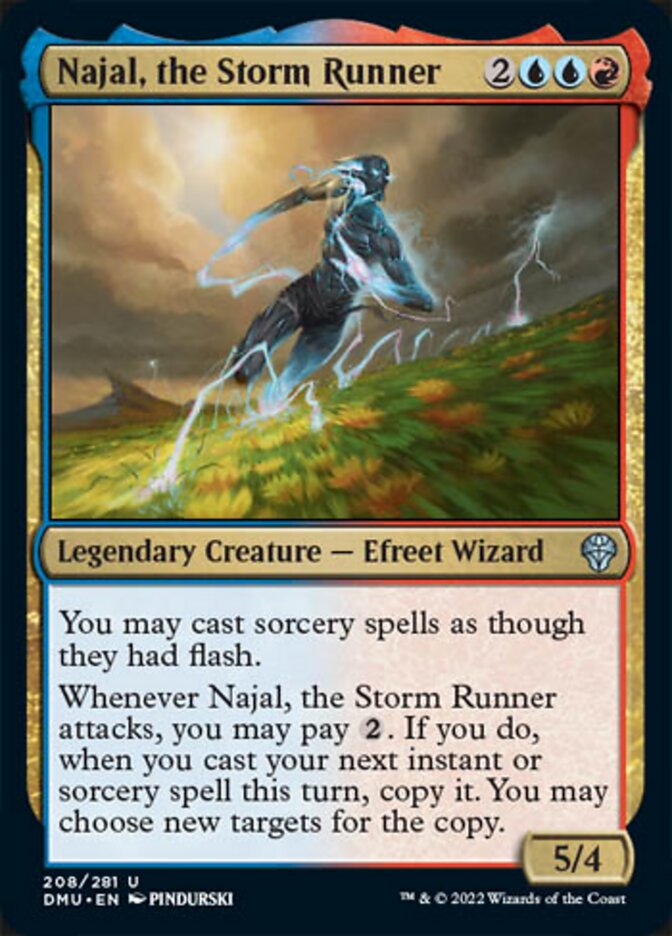
Rating: 7/10
I’m not used to my Izzet spell payoffs being so big, but Najal, the Storm Runner really hits hard. Since the trigger happens when it attacks, the best play here would be to use it to cast something that removes potential blockers, making the attack a lot more palatable.
Imagine using Najal to copy Tolarian Geyser, bouncing two blockers, drawing two cards, and maybe even gaining six life if you have access to the kicker. That’s just dirty, and I can’t wait to see what shenanigans you can pull off with it.
Nemata, Primeval Warden
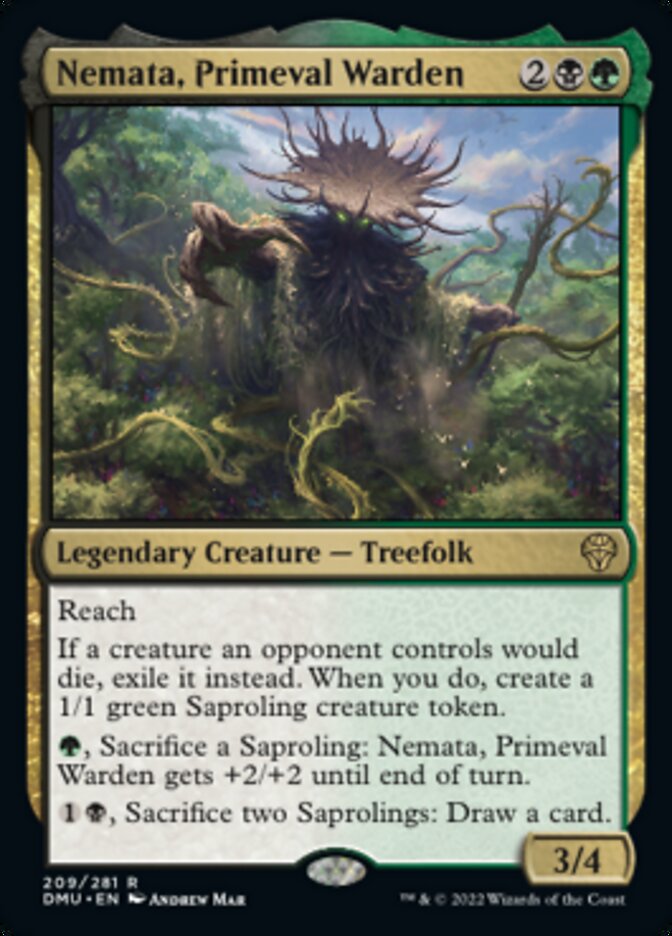
Rating: 7/10
Sadly this set isn’t exactly brimming with Saprolings like the last Dominaria set was, so Nemata, Primeval Warden doesn’t get the help from the rest of the set that might have pushed its grade into the 8 or 9 range. But it’s still doing a decent amount of work.
Turning off death triggers is annoying, and flooding the board with Saprolings is a powerful ability, even though you don't have any other ways to make them and make good use of the activated abilities.
Queen Allenal of Ruadach

Rating: 6/10
Tokens look to be quite a strong deck in this format, with plenty of effects that create them. Queen Allenal of Ruadach looks to be perfectly well supported in the right deck given that, and odds are you’ll be able to since it heavily leans into white.
The only knock on the Queen is that she’ll often be a 1/1 or 2/2 if the board is nearly empty, but it turns around pretty quickly since a single Captain's Call will shoot it right back up. Just be careful of how easy it is for your opponent to manipulate its size by picking off your other creatures during combat. If it’s a 5/5 and you’re expecting it to trade with an opposing 5/5, be aware that one removal spell will shrink it.
Raff, Weatherlight Stalwart
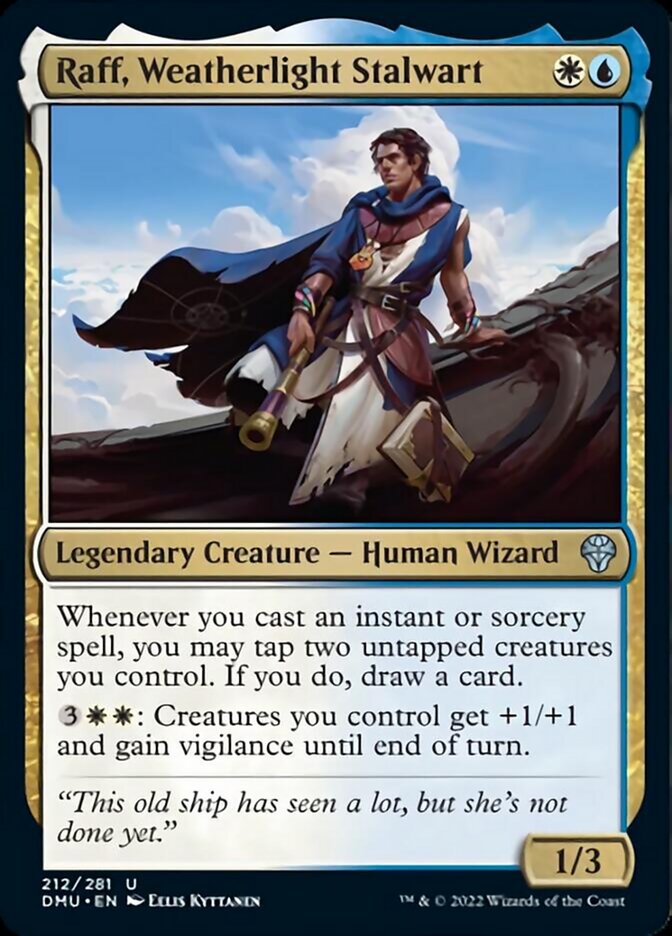
Rating: 7/10
Raff, Weatherlight Stalwart has a very weird crossover ability where it’s trying to pay you off for casting instants and sorceries but requires creatures in play to do so. It can count as one of those two creatures, so it’s not too difficult to do, but those things are still at odds with each other.
All that said, what the card wants you to do is use tokens as you build up your board and accrue value. Then you can use Raff’s activated ability to grow your team for a big alpha strike.
All of that on a simple 2-drop sounds like a good investment to me.
Ratadrabik of Urborg
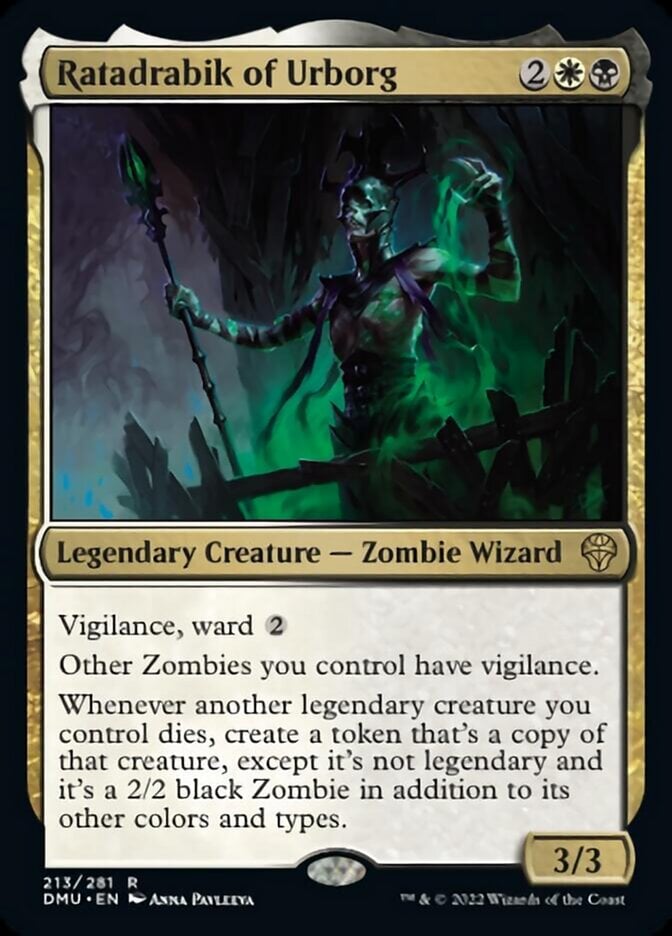
Rating: 5/10
Even with a lot of legendary creatures in the set, you have very few real payoffs for playing them. Ratadrabik of Urborg is one, but since most decks will likely have about three or four legends, this isn’t going to be quite as good as it looks. There’s also no zombie tribal synergy to make use of the vigilance ability.
If you can set up a situation where Ratadrabik is played alongside another legendary, its triggered ability is very powerful. It’s just not likely to trigger several times over the course of a game.
Rith, Liberated Primeval

Rating: 10/10
Rith, Liberated Primeval is the first in a cycle of 3-color mythic rare legends. I’m going to assume that these are easily splashable thanks to the abundant mana fixing in the set. Given that, this card is absolutely disgusting.
Rith doesn’t need to be on the battlefield when excess damage was dealt in order to trigger. Meaning you can attack your 4/4 into a 4/3, deal excess damage, then play Rith post-combat and get an extra dragon straight away. Or just wait for your opponent to make a chump block. Or attack your medium-sized creature into their deathtouch blocker.
Once Rith hits the board, your opponent just can’t make these blocks anymore and your burn spells turn into insane Flametongue Kavus with flying. Wingmate Roc is one of the best Limited cards of all time and while this is a fair bit worse being three colors and harder to enable, being only a bit worse than one of the best cards of all time still makes you an easy 10 that’s incredibly hard to beat.
Just remember to change your MTG Arena settings to stop auto-assigning trample damage so you can manually assign a point of excess damage and trigger Rith.
Rivaz of the Claw
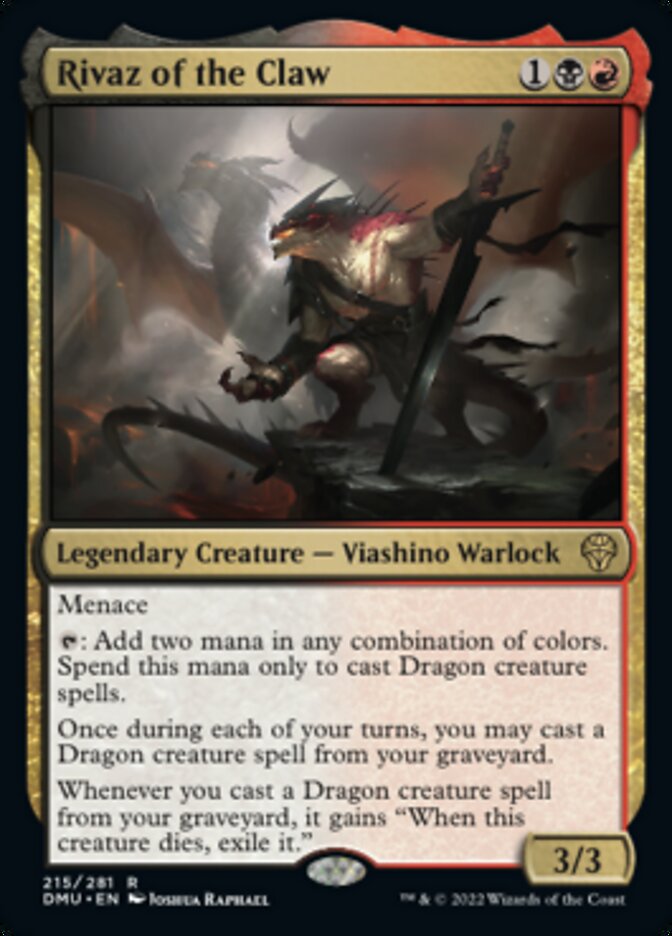
Rating: 4/10
While there are a couple of very powerful dragons in this set, getting a deck with Rivaz of the Claw and one of those is just too unlikely to happen. A 3/3 menace for three is a good card, and that’s what this entire rating is based on.
If you’re lucky enough to get a stupid deck where Rivaz fixes the green and white mana for Rith, Liberated Primeval then good job, you’ve officially won the format.
Rona, Sheoldred’s Faithful
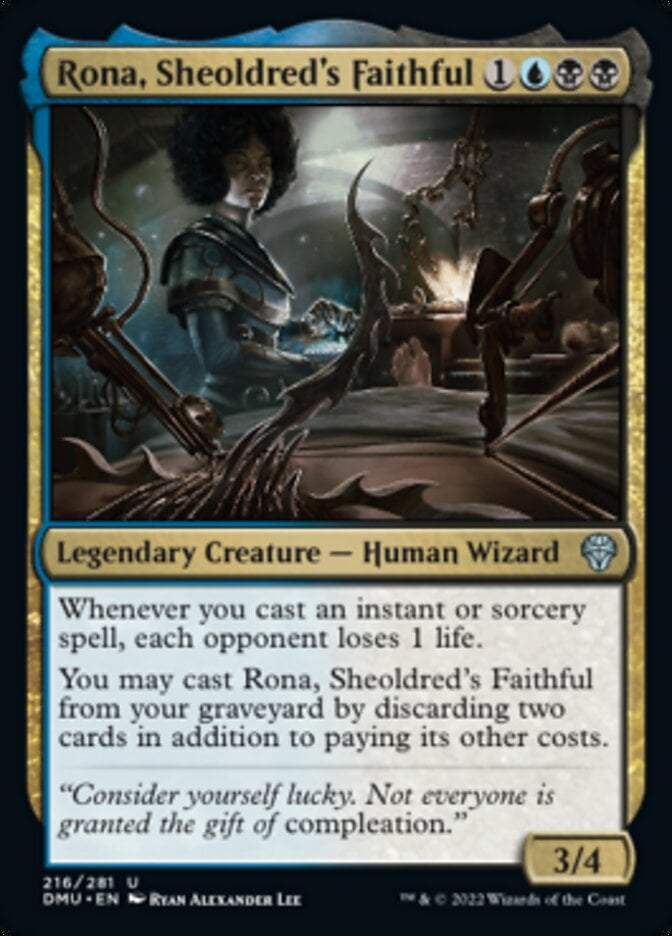
Rating: 7/10
Rona, Sheoldred's Faithful has some big shoes to fill as its 2018 counterpart, Rona, Disciple of Gix, was an exceptional card in the format. This new Rona is fairly decent, but hitting for one damage isn’t the sort of payoff that you want when you’re casting instants and sorceries.
The ability to essentially Retrace Rona from the graveyard is pretty sweet, and a big incentive to hold on to excess lands in the late game. And since it doesn’t exile herself you can keep doing this if you need to and can purposefully save the lands you draw just to do this.
This card provides a good amount of inevitability for the late game even if it doesn’t do much earlier on, so it seems good overall.
Rulik Mons, Warren Chief
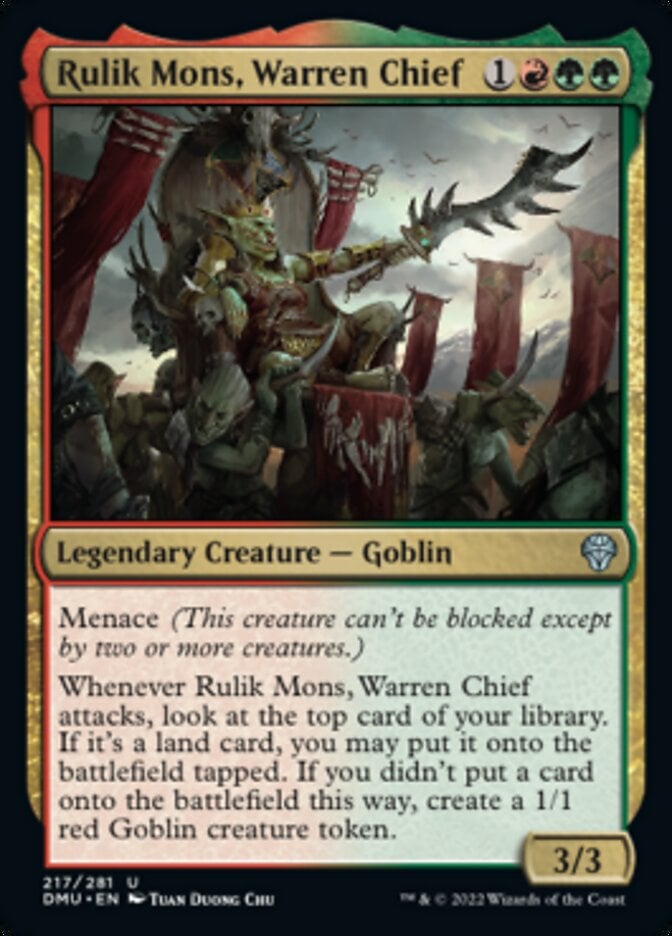
Rating: 6/10
Having a safe attack for a 3/3 menace is fairly easy to achieve, and getting to basically draw a card when you do is one of the biggest rewards you can get for making sure it can do so. Rulik Mons, Warren Chief is one of the simplest legends in this cycle. Your aggressive midrange decks should be happy having it on the board.
Your opponent really wants this off the board, so it takes a lot of the focus away from your other attackers.
Shanna, Purifying Blade
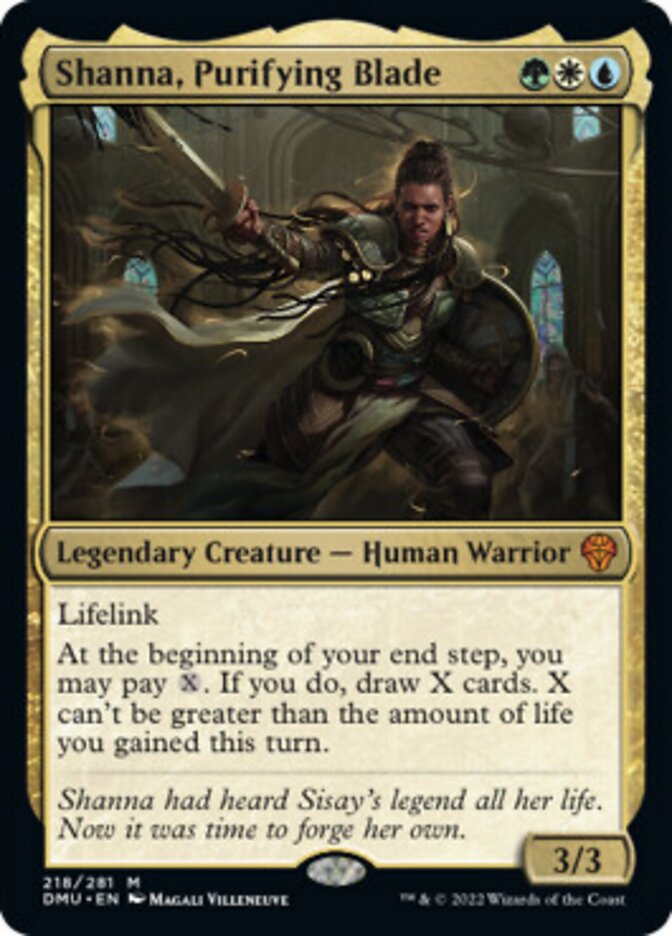
Rating: 9/10
Shanna, Purifying Blade isn’t kidding around. Shanna premiered in the original Dominaria as an uncommon that wasn’t even playable in some decks, and now you have a badass mythic rare that can really put you far ahead.
You really want to make sure it’s safe for Shanna to connect and let you draw a bunch of cards in the end step. Even if you can’t, all opponents should find it hard to race you when you have a 3/3 lifelink on the board. Not to mention that Shanna still pays you off if you have life gain from any other source.
Just imagine playing Mesa Cavalier and drawing two cards in your end step. Shanna looks like a really broken card that only needs a little bit of support to go absolutely ridiculous.
Sol’Kanar, the Tainted

Rating: 10/10
Let’s get this out of the way first: there’s absolutely no way you can allow Sol'Kanar, the Tainted to go to the opponent’s board. But you do have quite a lot of time before that becomes a problem.
Given the mix of abilities and how aggressive this format looks like it can be, I doubt your opponent will be able to last long enough for the final mode to become an issue. Not to mention that you have access to a bunch of cards in these colors that bounce Sol’Kanar to your hand or sacrifice it for value, so you really shouldn’t have to worry about it.
In fact, even more than that, how is your opponent going to last if they don’t just outright kill it? Sol’Kanar’s set of abilities is so ridiculous that you should run away with a game given any time on the board. Assuming they can’t kill it immediately, you’ll always get one of the triggers off, and drawing a card or killing a creature are incredible effects to get from the get-go. The rest just add to your advantage.
Soul of Windgrace
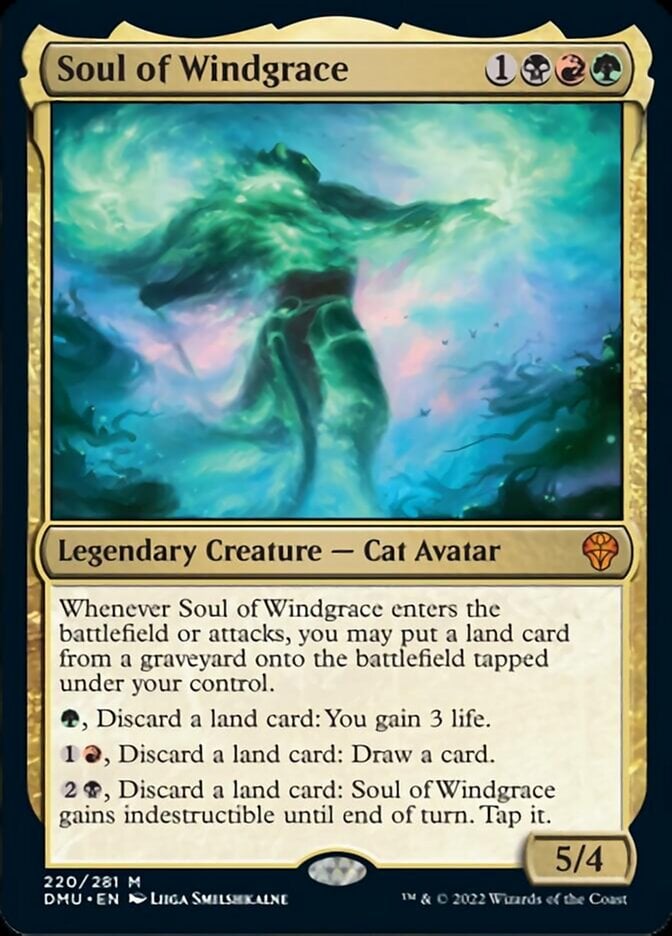
Rating: 7/10
Soul of Windgrace doesn’t give you any advantages right off the bat, unlike Sol’Kanar. Having to discard lands for each ability seems quite fair as opposed to the downright ridiculousness we’ve come to expect from top-tier mythic rares.
Being able to trade in excess land for cards or life isn’t that bad, and you get to put those lands into play whenever Windgrace gets to attack. I guess that’s an upside.
This all just seems like a kind of average but very good rare to me as opposed to a game-winning bomb that takes over a board and must be answered.
Stenn, Paranoid Partisan
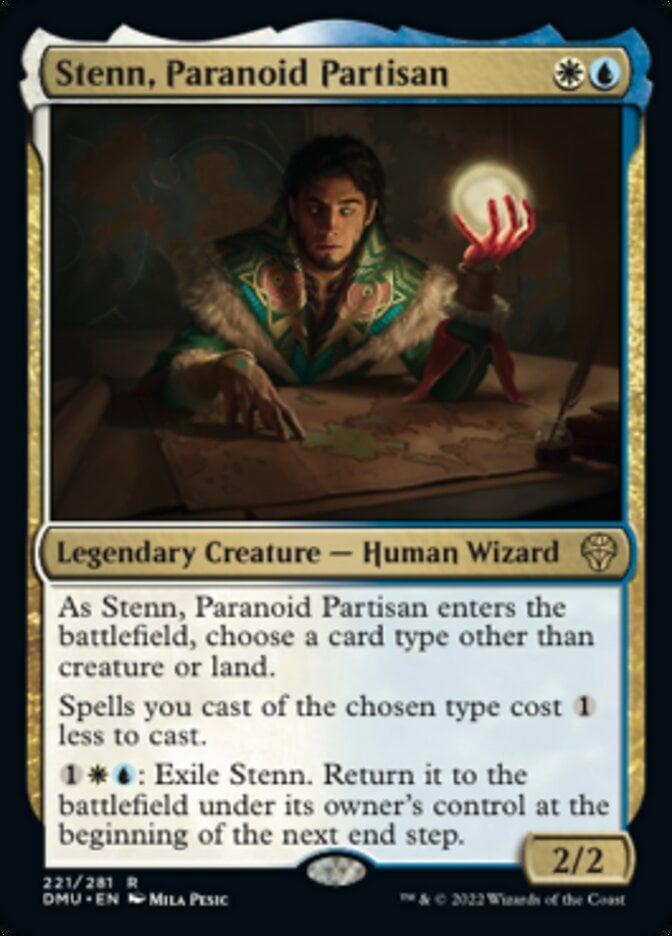
Rating: 4/10
I’d be pushing Stenn, Paranoid Partisan up to a 6 or a 7 if it had the ability to cast creatures for cheaper, but sadly that won’t work. As is, your best bet is usually going to be to name instant or sorcery based on what’s in your hand, but this ability is only effective in the early game where you’d rather be casting creatures on curve.
The flicker ability is really sweet, making this a very annoying blocker while also resetting the named card type to optimize future turns. But I have a feeling that that’ll end up being more cute than good.
Tatyova, Steward of the Tides

Rating: 6/10
Ah, how the mighty have fallen. Tatyova, Benthic Druid was one of the most broken cards at any rarity in Dominaria, and yet Tatyova, Steward of the Tides doesn’t even do anything until you get to seven lands. Turning your lands into 3/3 fliers at that point is a very strong ability, but having the flying linked to Tatyova does means that killing it off makes the lands much easier to deal with.
Tori D’Avenant, Fury Rider

Rating: 7/10
Battle cry is an incredible ability for go-wide aggro decks, so of course dialing that up to 11 is going to be a good thing. Not only granting +1/+1 but also trample or “vigilance” based on the creatures’ colors is just an incredible swing.
A streamlined aggro deck that tops its curve with Tori D'Avenant, Fury Rider is going to be really tough to beat.
Tura Kennerüd, Skyknight
Tura Kennerud, SkyknightRating: 7/10
I love creatures that create creature tokens whenever you cast an instant or sorcery. That steady stream of extra value should always be capable of swinging games in your favor.
Tura Kennerüd, Skyknight is one of the worst versions of this that we’ve seen, but still a very strong card that should be a potent build-around that’s also easily splashable in a lot of blue decks.
Uurg, Spawn of Turg
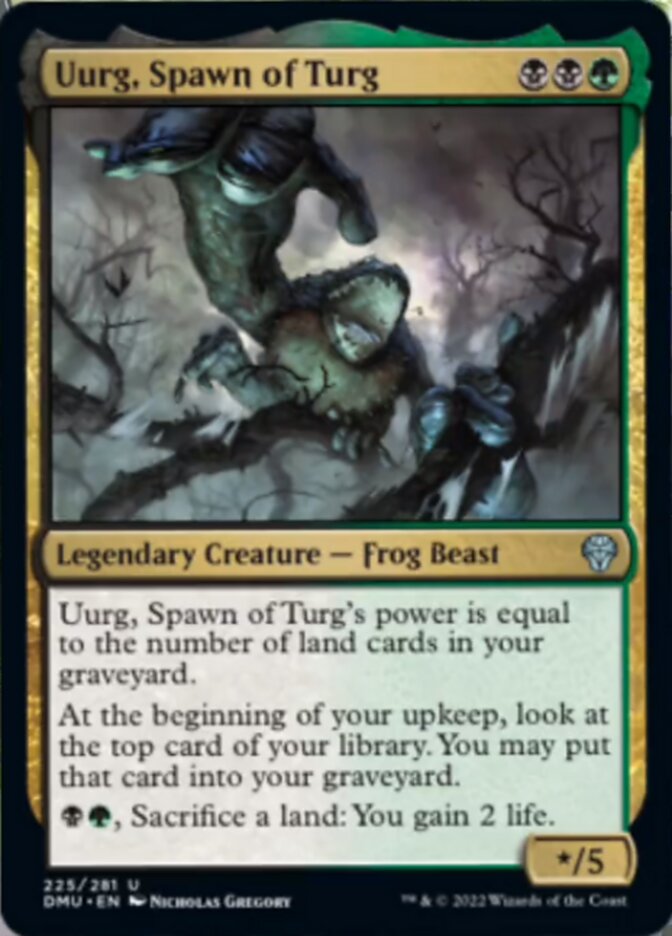
Rating: 5/10
I want to like Uurg, Spawn of Turg more, but there’s not a lot of good stuff here. Lands just don’t go to the graveyard too often, meaning this often starts life as a 0/5. Getting to surveil each upkeep helps to make sure you draw decent cards each turn.
The biggest problem with this legendary frog is that it just takes so long to pay you off. It has virtually no immediate impact and is easy for your opponent to ignore for quite a long time before it’s worth killing.
Vohar, Vodalian Desecrator
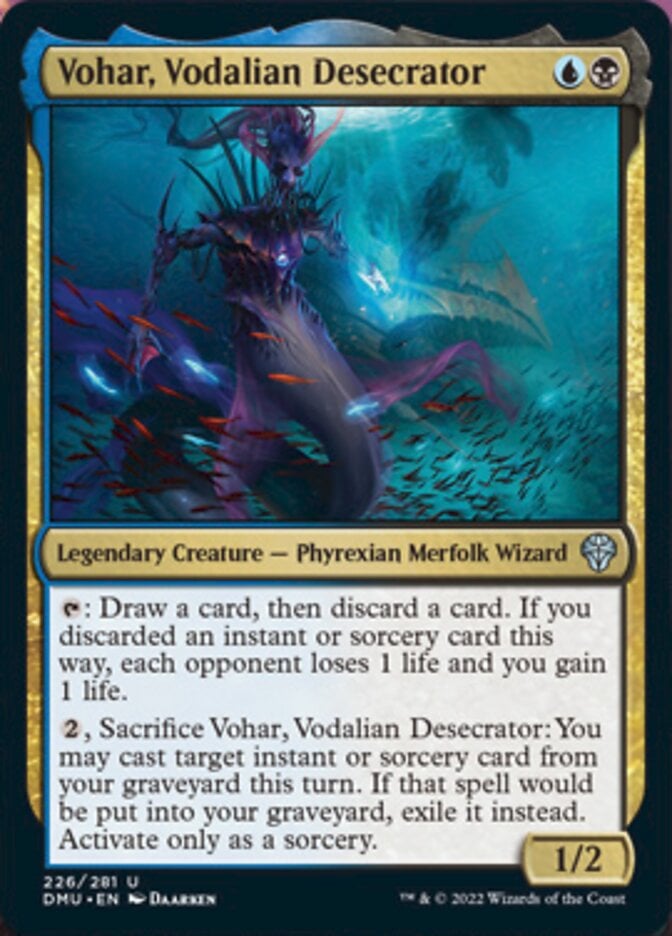
Rating: 7/10
What’s not to love about a legendary upgrade on the classic Merfolk Looter with a couple of extra abilities? Looters are extremely good in decks that aren’t trying to be aggressive since they’re great at smoothing out your draws and making sure you always have relevant cards to play. Not to mention that you can trade your looter in for an important instant or sorcery when you need to, making Vohar, Vodalian Desecrator a card I’m very interested in playing.
Zar Ojanen, Scion of Efrava
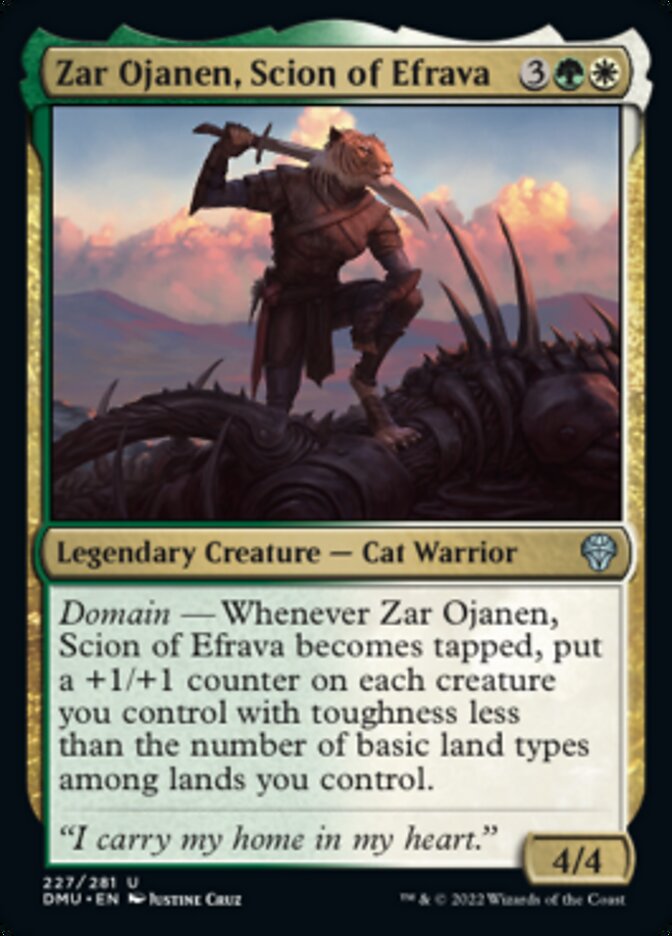
Rating: 4/10
It’s cool that Zar Ojanen, Scion of Efrava triggers when it attacks or is tapped to an enlist ability, but only working on 1-toughness creatures is really not that good. I get that you can use this to buff all of your various 1/1 tokens, but do you need to be splashing other land types to affect anything else?
I kinda hope I’m wrong on this one because I love the idea of the card, I just think that it’s too restrictive of an ability to make me excited.
Zur, Eternal Schemer
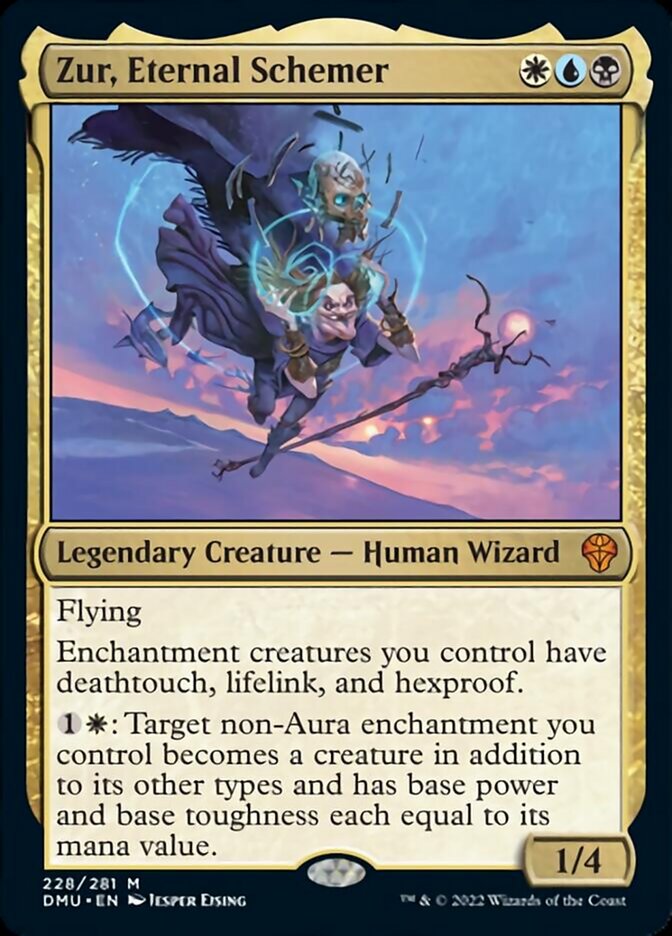
Rating: 3/10
I bet Post Malone is happy with a new Zur to play with, but I doubt he’ll be playing it in booster Draft. There are a handful of enchantments in the set but not very many, so the targets available to turn into creatures are few and far between. There are also no enchantment creatures at all, so you have to rely on the activated ability alone.
Zur, Eternal Schemer is cool if you can get it to work, but it seems too difficult given how few enchantments you actually have access to.
Colorless
Karn, Living Legacy
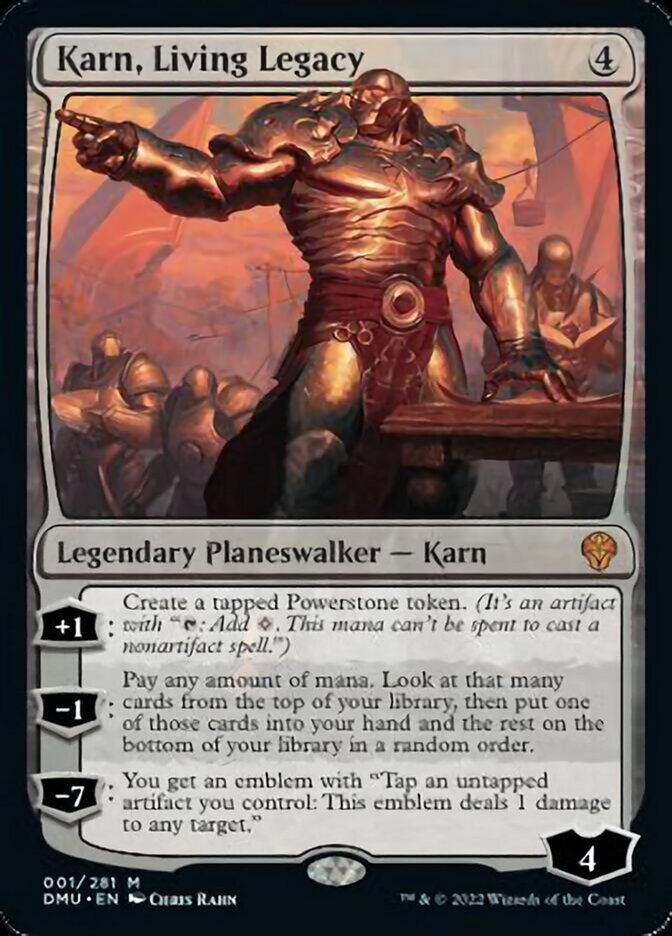
Rating: 0/10
Ah yes, the classic “we’ve made too many good versions of this guy so we need to massively overcompensate when toning down the power level of the next one” play. Karn, Living Legacy reeks of unplayability to me.
I don’t want to make bad mana rocks with its +1, I definitely don’t want a -1 that requires me to spend mana when the best it can do is draw one card. Above all else, neither of these abilities are ones that you care about in Limited.
Karn doesn’t affect the board, doesn’t remove threats, and doesn’t create blockers. Just don’t bother with this and you’ll be better off. Leave it to the realms of Constructed… where I think it’s also pretty awful but any potential it has will be there.
Automatic Librarian

Rating: 2/10
If Chrome Cat wasn’t good enough, then I doubt Automatic Librarian will be either. That said, it’s really not the worst thing you can do and this isn’t that bad if you’re stuck on playables. I just don’t think you should ever prioritize it.
Golden Argosy
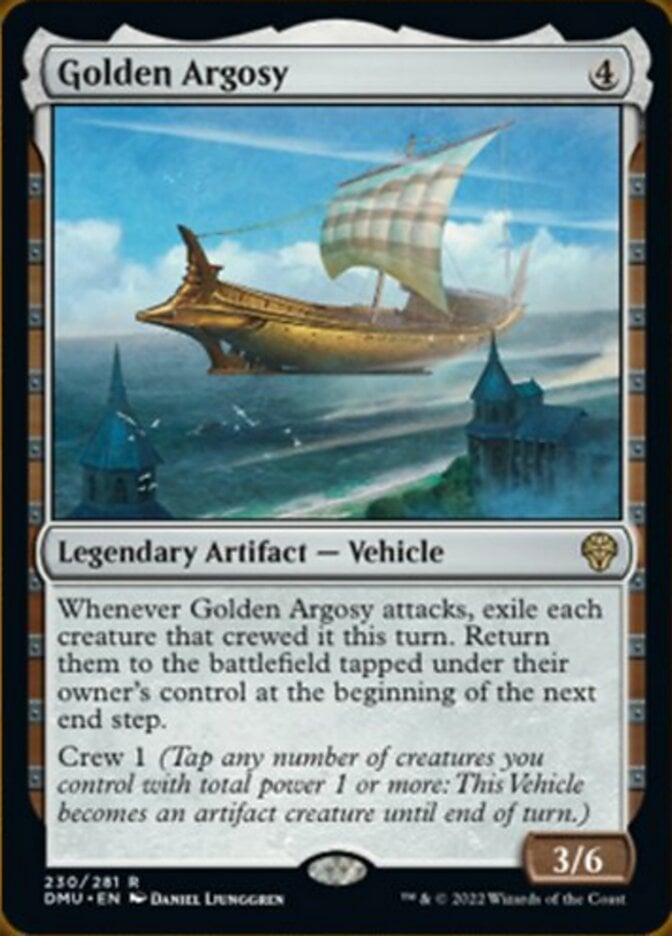
Rating: 8/10
One thing I noted as I was going down each color is the fact that there were no flicker spells, but lots of great creatures that were crying out to be flickered. Golden Argosy is the answer.
Despite having no keywords, a 3/6 vehicle for four mana is a good size and is fairly hard to kill in combat. If you can reliably crew it up and send it in, flickering any of the great options for ETB triggers, then you’re really doing it.
Hero’s Heirloom
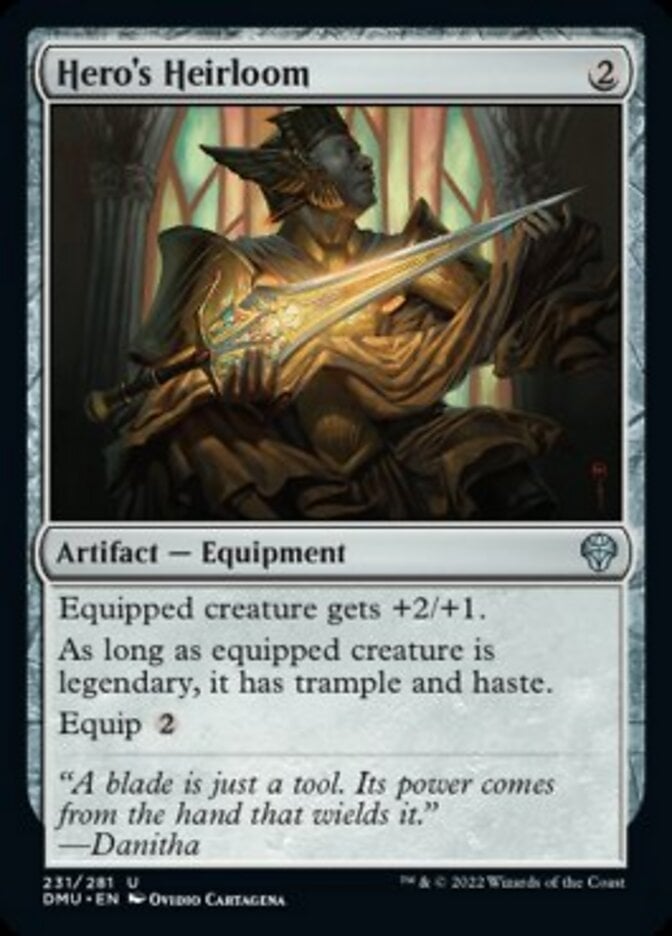
Rating: 5/10
The baseline I use to evaluate equipment is Vulshok Morningstar, and Hero's Heirloom is close enough that I have to imagine it’s good. Equipping a legend is pretty spicy and it’s especially busted with the new Danitha, Benalia's Hope, so be wary of that combo.
I don’t know if you can afford many slots for cards like this, but one couldn’t hurt. And it provides you with enough power to be worth it.
Inscribed Tablet

Rating: 3/10
I don’t get why we can’t just have Traveler's Amulet instead, but the upside here is that Inscribed Tablet can fetch nonbasic lands, which is nice given all the dual lands in the set.
Unfortunately, you always have to pick a land if you see one as the five cards are revealed. You can’t “fail to find” so you get to draw a random card when you don’t need lands anymore. In a format with such a heavy focus on domain and splashing extra colors, I think you’ll be happy with this in your deck.
Jodah’s Codex

Rating: 5/10
I think you really have to be playing a domain deck to want Jodah's Codex. It looks worth the mana cost if you get it down to an artifact that just taps to draw a card every turn.
Unfortunately, cards like Jayemdae Tome are just bad by modern standards, regardless of what the mana costs for them are. Maybe it’s fine if you can get it down to costing two to activate. One is okay and zero is fantastic.
Karn’s Sylex
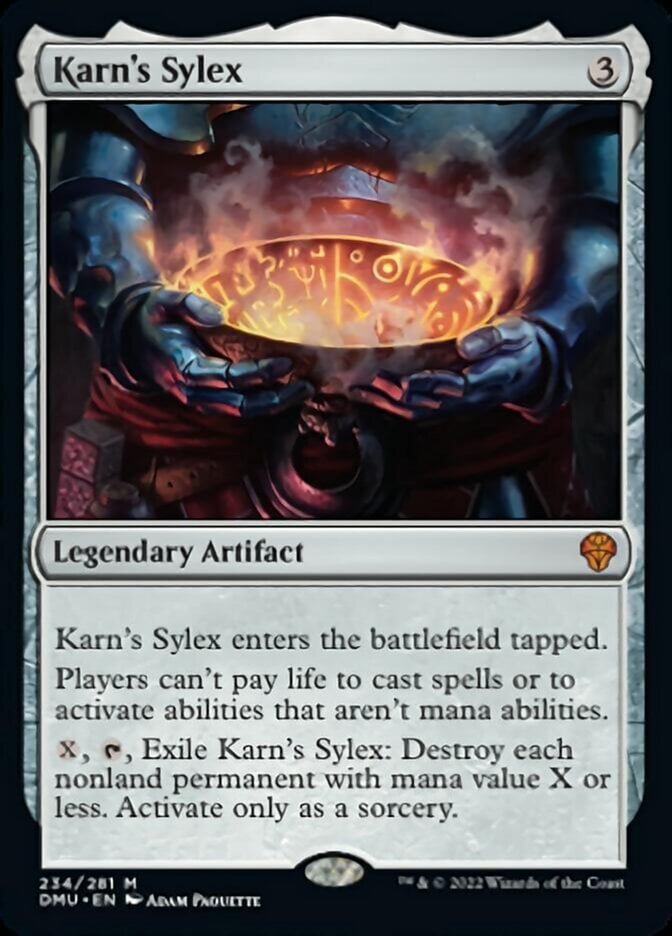
Rating: 6/10
The whole first half of Karn's Sylex’s text is designed for Constructed play, so you’ll ignore that. But I’m very interested in it functioning as an Oblivion Stone.
It’s essentially a flexible board sweeper that you have to cast first and then wait a turn before cracking. You can set up scenarios that only kill your opponent’s cards and leave some of yours behind since it’s based on mana values. It may cost a lot of mana, but that ability alone is enough for me to pay attention to this.
Meteorite

Rating: 4/10
Meteorite has cropped up a few times over the past decade and it’s usually fine. An expensive mana rock is never all that good, but getting a nice chunk of damage in is a welcome bonus. If this kills a relevant creature and then fixes the mana for your bomb rare or splash card then it’s done its job.
Relic of Legends
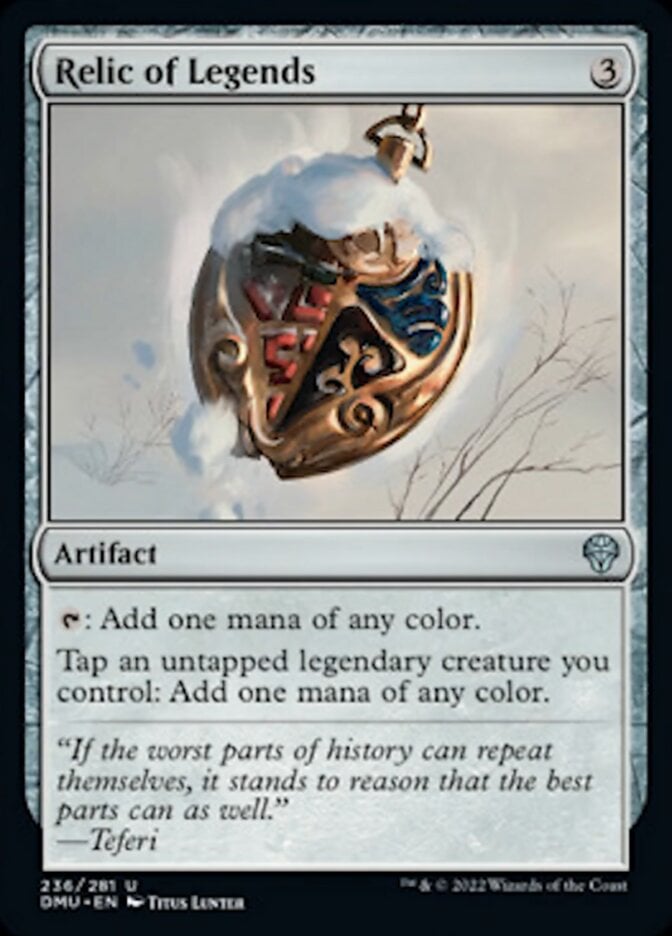
Rating: 5/10
We’ve seen a whole host of terrible mana rocks, and there seems to be one in every set these days. It’s nice to see quite a powerful one for a change.
Not only do you need some mana fixing for a lot of decks, but having the potential to add multiple mana in a turn lets you ramp out bigger and more complicated cards. Very much like Relic of Legends’ predecessor, Coalition Relic, I’d expect you won’t mind having this as a source of mana fixing.
Salvaged Manaworker
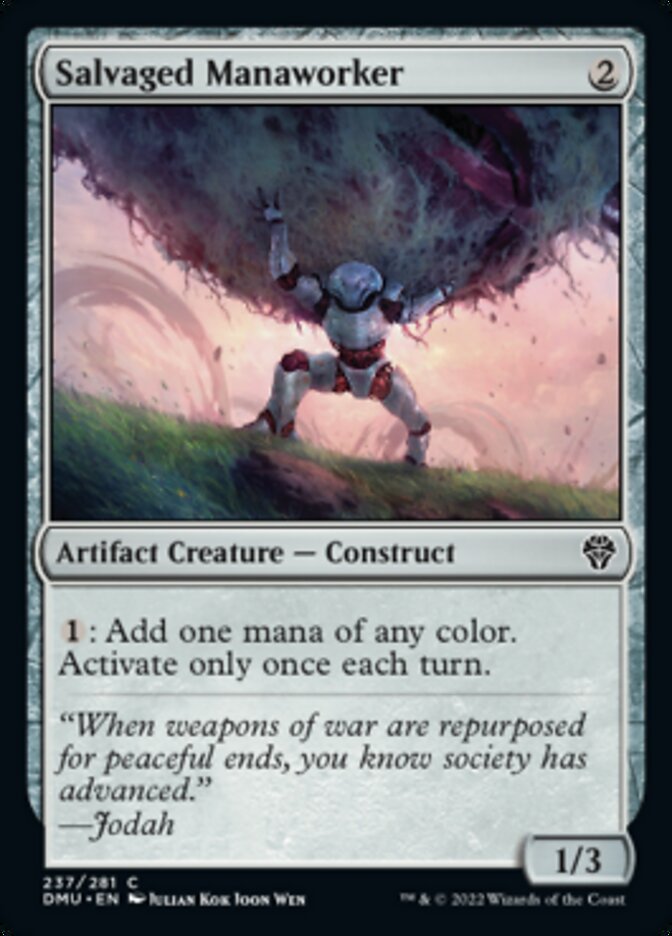
Rating: 2/10
I don’t think you’ll be struggling so much for mana fixing that you want to play Salvaged Manaworker. It doesn’t attack well, it blocks fine but is still too fragile, and it doesn’t help you with domain.
They could have at least given it defender so you could use it with your walls deck.
Shield-Wall Sentinel

Rating: 3/10
You only want a card like Shield-Wall Sentinel if you’ve been crazy enough to build the walls deck that I’m so hoping is good enough. Even then it’s not a particularly good rate for a creature. I kind of want it to be a bit sturdier.
Still, it does its job and if you failed to pick up many of the big uncommon payoffs for the deck. This helps to double up on some of them.
Timeless Lotus

Rating: 2/10
Cards like Timeless Lotus really need the right home to be useful. Providing five mana and all colors at once can be a very powerful effect, so I can see this being good if you’re a slow deck with a lot of top end and a variety of kicker costs to satisfy.
But beyond that you should avoid it.
Vanquisher’s Axe
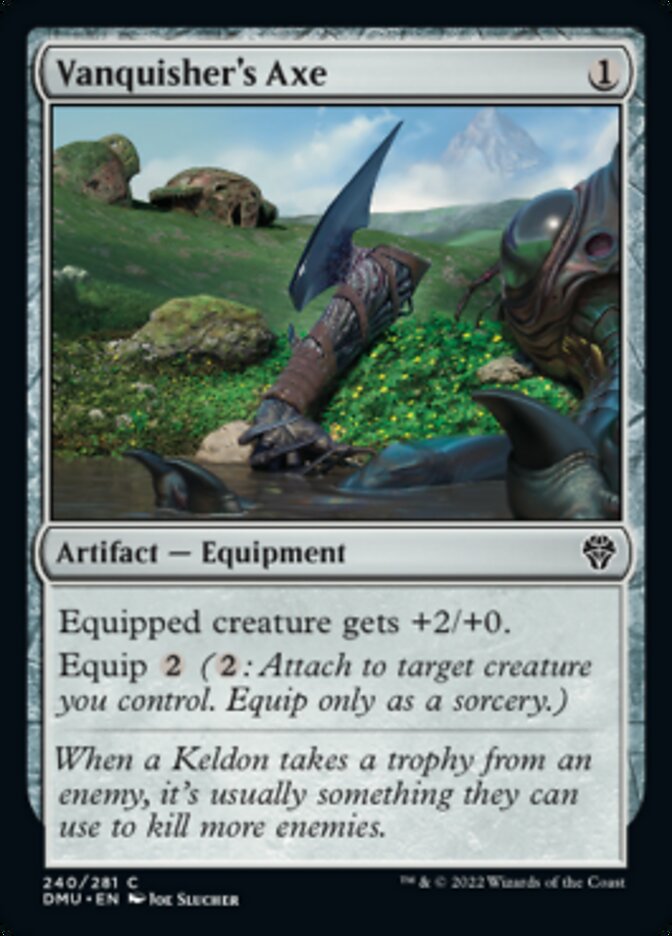
Rating: 3/10
The costs on an equipment card have to be so precise to be worth playing. I don’t think it’s worth paying two mana to only be giving a boost to power and no toughness or keywords.
I don’t like it, but I can see some decks wanting Vanquisher's Axe. It’s also particularly good with 1/1 tokens since it turns them into cards that can trade up for real cards.
Walking Bulwark
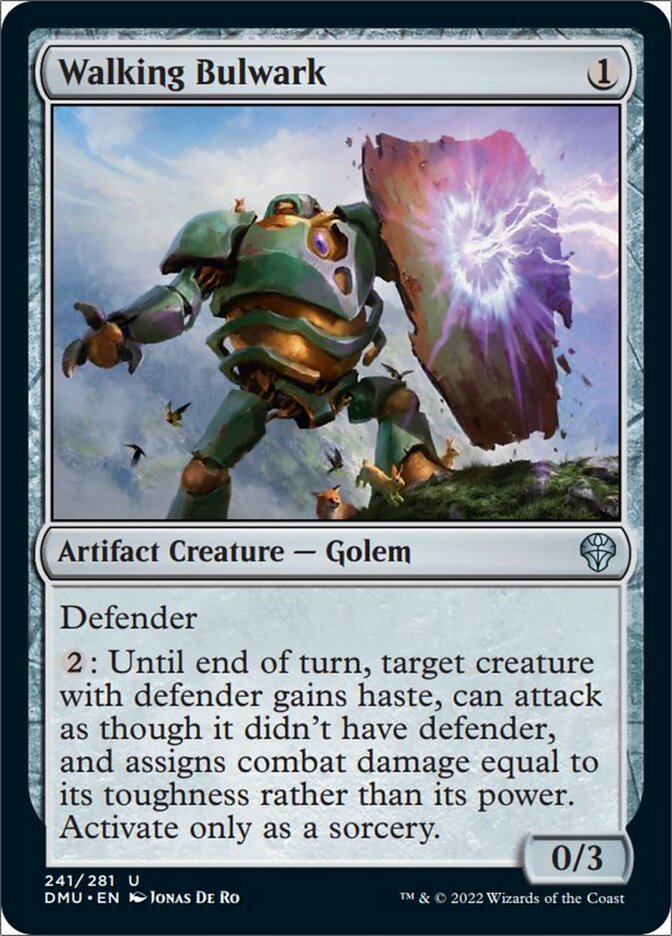
Rating: 4/10
This rating is entirely based on playing Walking Bulwark in a deck with plenty of defenders. It’s a slightly better Stuffed Bear by itself, but that’s not a compliment. Even if you do get a bunch of defenders together a lot of them are unimpressive in terms of stats.
The biggest is a 0/5 and most are stuck around three or four toughness, so I don’t think paying two mana to animate them will do much good. I think this is the worst payoff that that deck has access to, but it’s one that I’ll try to pick up nonetheless and it still adds to the defender counts needed for the other payoffs.
Weatherlight Compleated
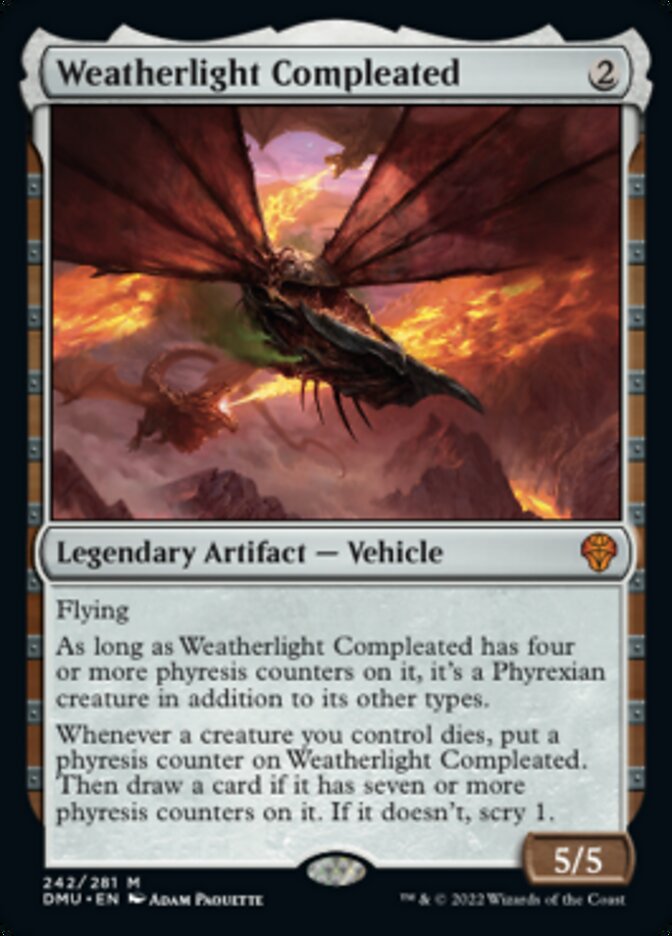
Rating: 1/10
So hear me out. If you drop Weatherlight Compleated on turn 2 you have to have had four creatures die in order for it to finally become active, at which point it’s just a 5/5 flier. If you draw it late, it’s virtually unplayable.
It takes so much work to get this active and it lets you scry 1 whenever a creature dies until it is. You know, there’s a black common 2-drop that does the same thing and that gets to attack and block right away.
Even if you went to the trouble of animating it another way, it’s not like a 5/5 flier is going to win the game uncontested. I think this looks like a card that was good at one point in testing, but it’s now a twisted and warped version of what it once was. Which, hey, is right on theme with the story of the card, so job done.
Lands
The Common Dual Lands
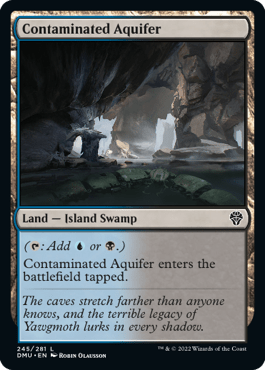

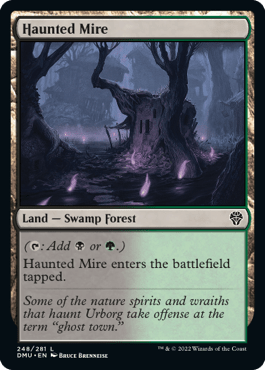
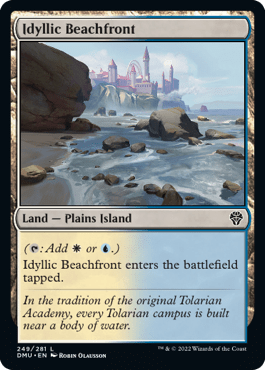
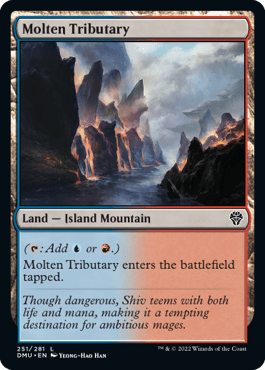

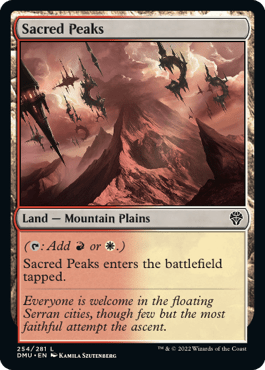
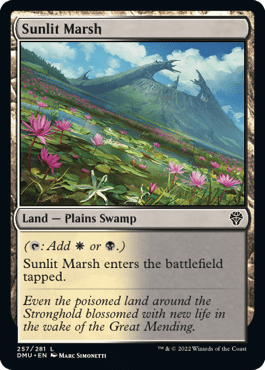
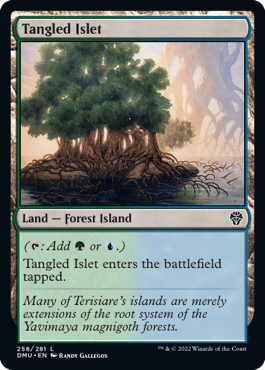
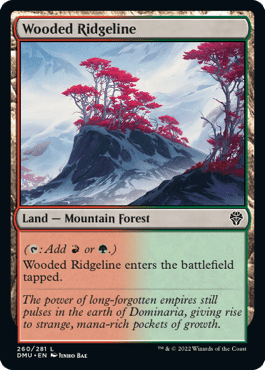
- Contaminated Aquifer
- Geothermal Bog
- Haunted Mire
- Idyllic Beachfront
- Molten Tributary
- Radiant Grove
- Sacred Peaks
- Sunlit Marsh
- Tangled Islet
- Wooded Ridgeline
Rating: 5/10
I freakin’ called it! We figured there had to be a common dual land cycle in this set and with domain making a comeback, making this cycle seemed inevitable.
With so many multicolored legendaries and a whole bunch of kicker spells with off-color costs to pay for, you’ll often need good fixing like this and the basic land types are huge to turn on your domain effects. Unless you’re heavy on domain you likely won’t take these too highly, but fixing is often necessary and these will be great for it.
You could even play one of these completely off-color if you just happen to have a domain effect in your deck, just as a colorless land that provides two extra land types to the domain card. I love this cycle and I’m hoping it makes this format as balanced as it looks.
The “Pain” Lands
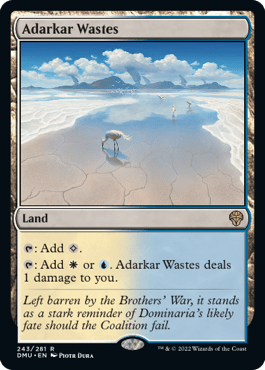

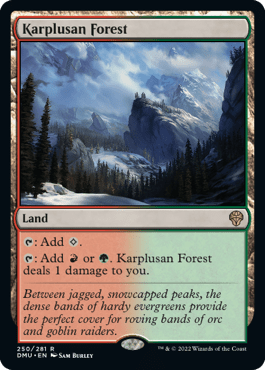
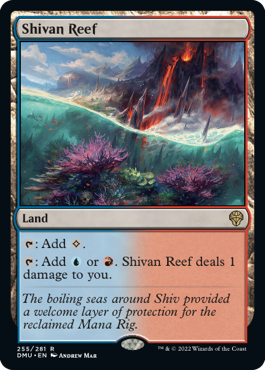
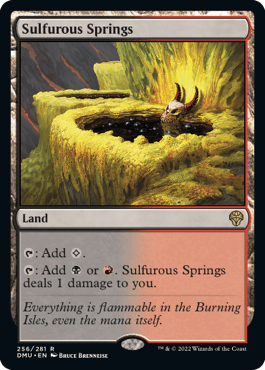
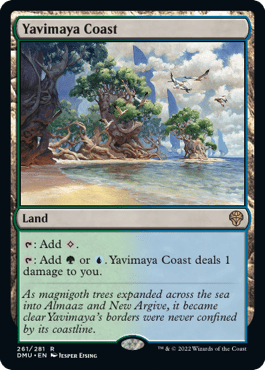
Rating: 4/10
The classic pain lands from Ice Age and Apocalypse are back, or at least six of them are. We’ll presumably get the other four in the next set.
These are fine if you need them. They’re always untapped and you don’t have to pay life for them if you no longer need the colored mana, so there’s not much to dislike. You just aren’t going to prioritize taking them over good playables.
Crystal Grotto
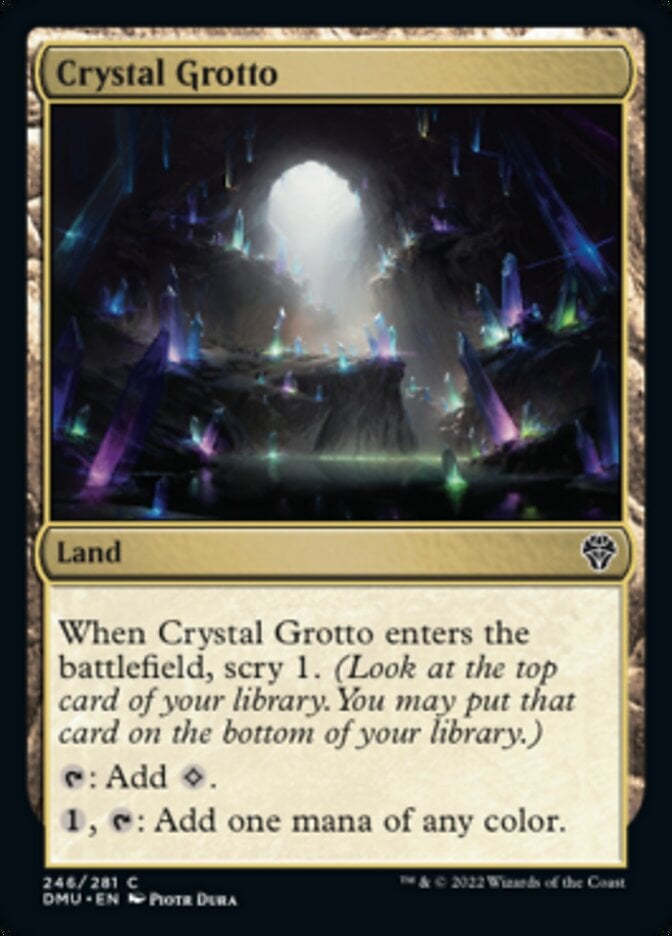
Rating: 1/10
Even if it does scry 1 when it enters, Shimmering Grotto is still not a very playable card. While fixing all of your colors, Crystal Grotto is also effectively adding one mana to the cost of your spells that need the fixing.
That trade-off is something that you should only be willing to do if you have absolutely no other options. But I don’t see that being necessary too often with a cycle of common dual lands.
Plaza of Heroes
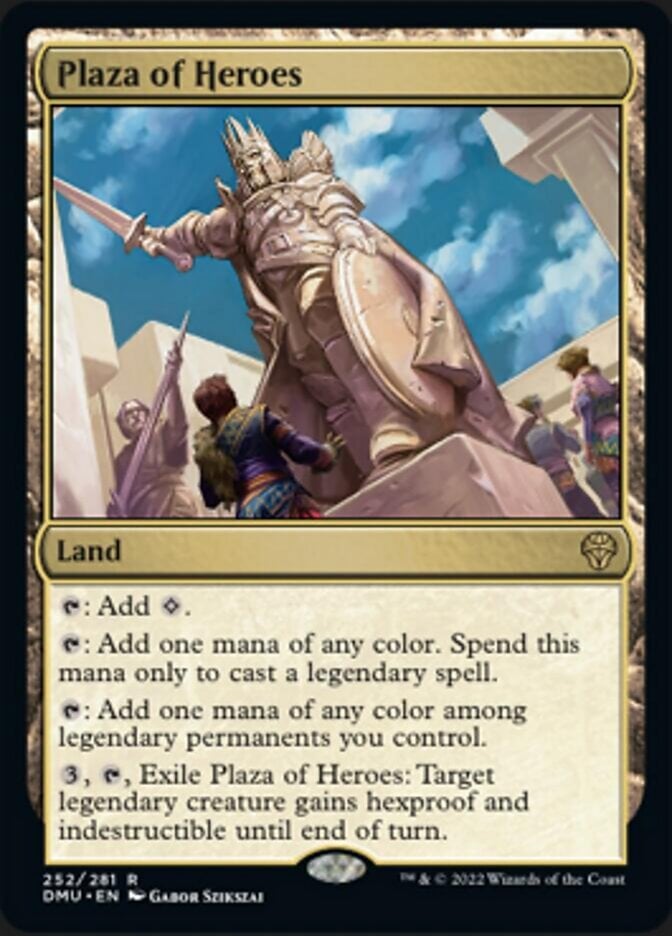
Rating: 5/10
There are a lot of powerful legendary creatures in this set that are pretty easy to splash, and Plaza of Heroes is a nice way to do that. But what I really like about this card is the ability to save your legendary creature from something, which is going to be a very annoying trick for your opponent to play around with.
This seems like a good card if you have enough legendaries, and I’d probably be happy even if I wasn’t splashing any just to make use of the final ability.
Thran Portal
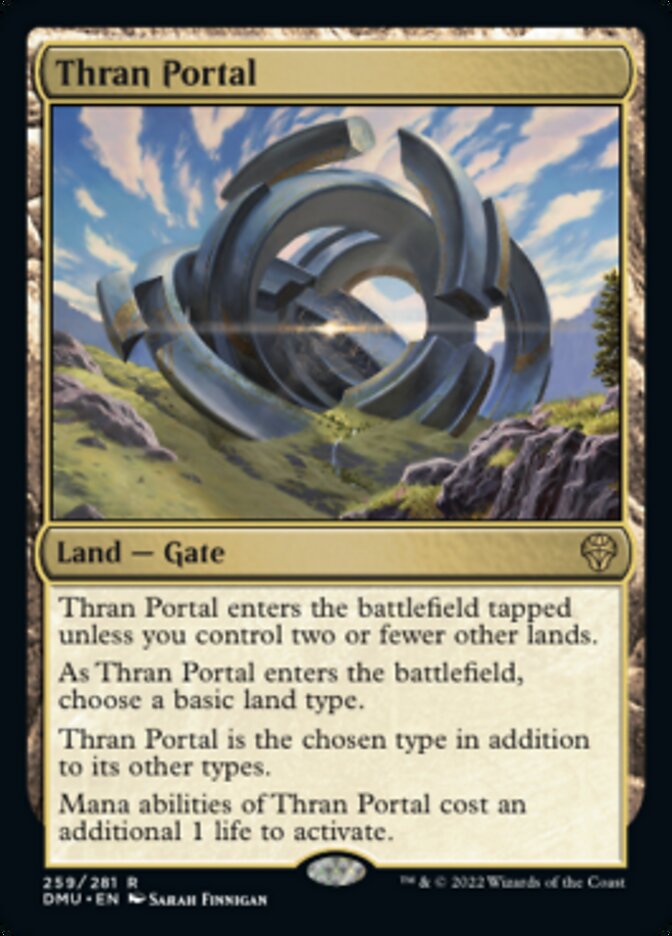
Rating: 4/10
Thran Portal is a hell of a lot of text, but it’s basically just a land that’s whichever color you choose, carries that basic land type for domain, and costs you life to tap for mana.
Okay, that’s fine, but it’ll often just be a worse Evolving Wilds for Limited. Still, fixing is fixing, and you’ll be happy with that in a lot of decks. You just can’t rely on this too much in a control deck where your life is a resource you often can’t afford to spend like this.
Wrap Up
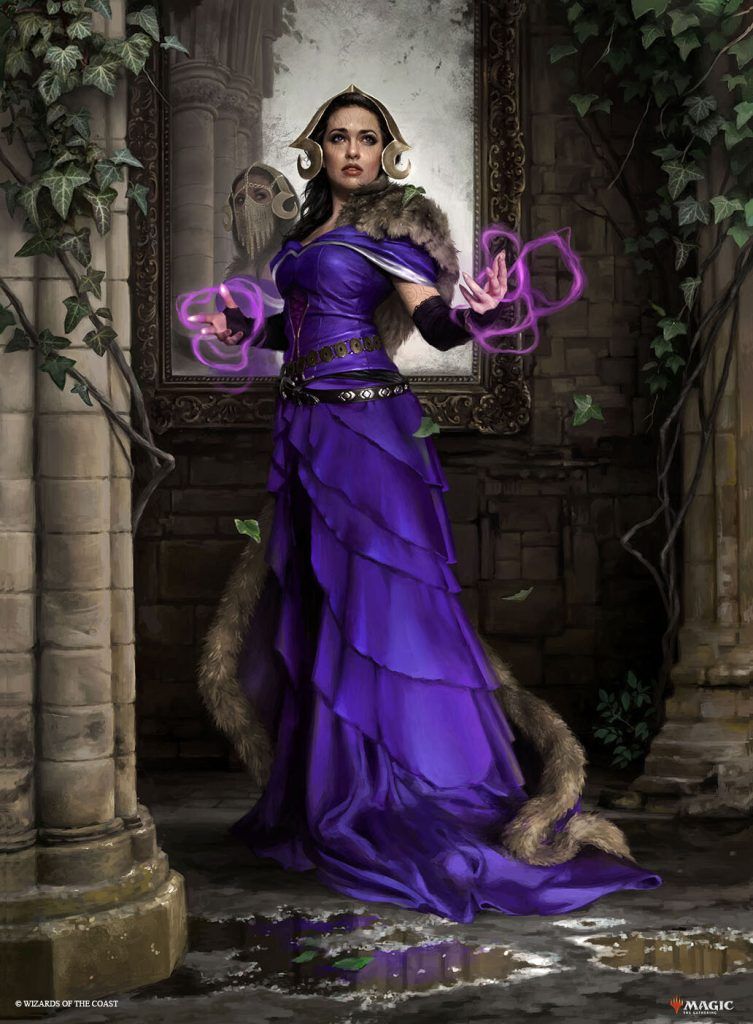
Liliana of the Veil | Illustration by Martina Fackova
I hope you’re as excited about this set as I am. I’ll be playing a Draft tournament and a team Sealed tournament of this format here in the UK, so I’m really invested in figuring out how the format works.
Do you have any early Limited tidbits or advice to share? What do you think about my ratings for these cards? Let me know in the comments below or over on Draftsim’s Twitter.
Until next time, take care of yourselves and enjoy your prereleases!
Follow Draftsim for awesome articles and set updates:
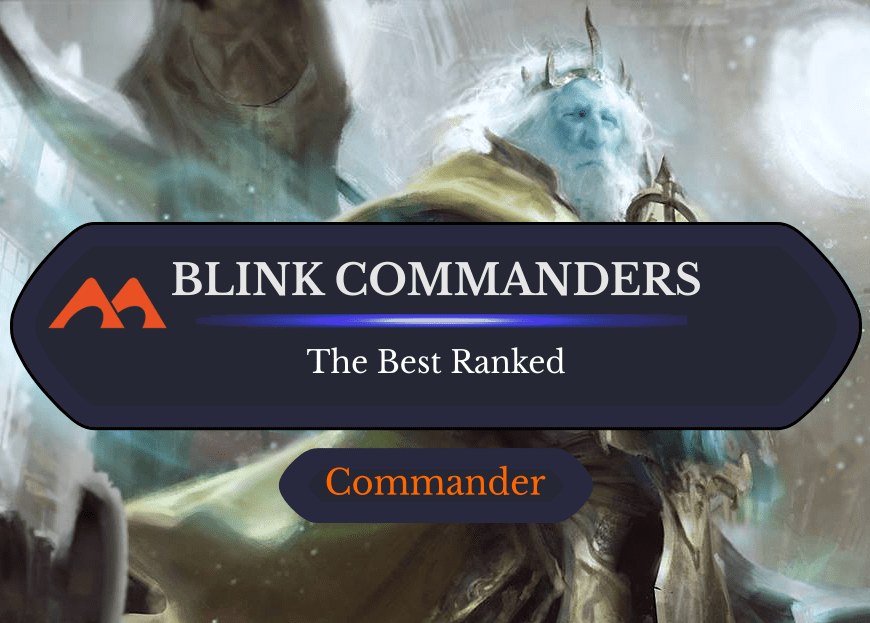
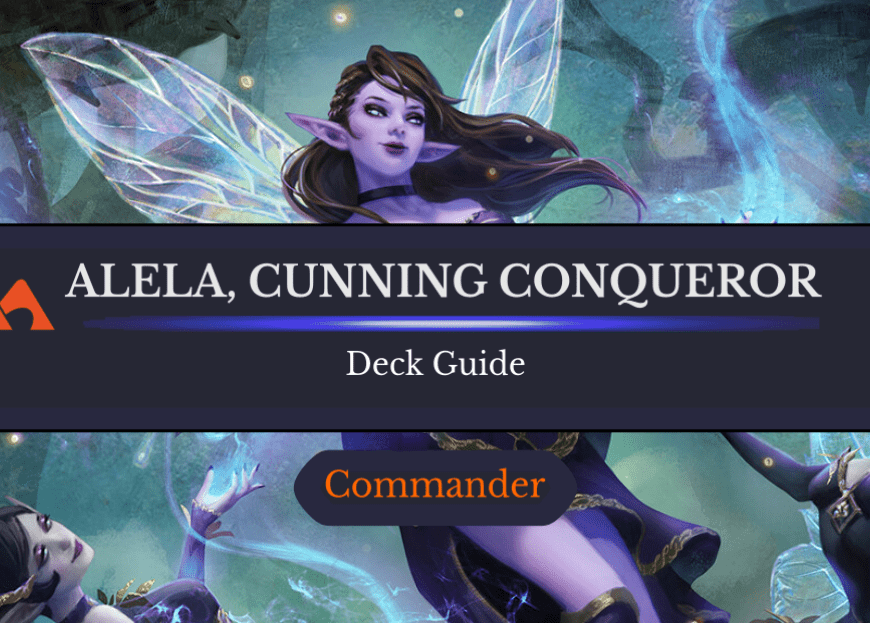
Add Comment